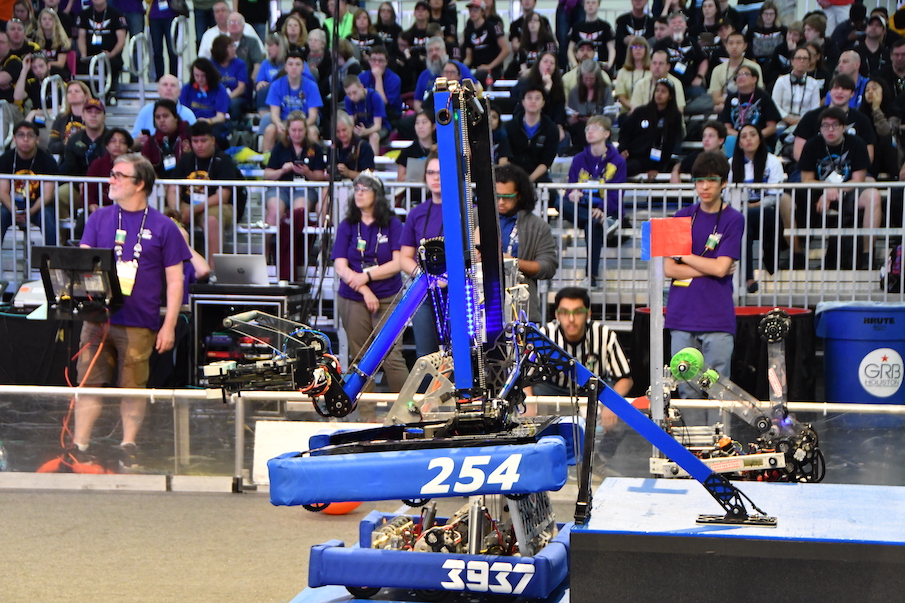Blog Archive
Discovery Day 2019
Event Summary
On November 2, we presented our 2019 robot Backlash at the annual Bay Area Science Festival Discovery Day at Oracle Park. At the event, we showed what FIRST was, described the different competitions for different ages, and explained how our 2019 FRC season went. Team 254 worked in conjunction with Teams 604 (Quixilver), 1072 (Harker Robotics), 1868 (Space Cookies), and 2643 (Dark Matter) to showcase our collective engineering achievements as high school students participating in FIRST. Discovery Day allowed for us to inspire a wider audience within our community and ignite interest in FIRST Robotics.

Our Experience
While Discovery Day gave members of our community more exposure to FRC, it also provided a valuable experience for our team members, who loved facilitating the interactive education that FIRST Robotics entails. People of all ages watched the robot speed around the enclosure, and our robot played catch with them, exhausting the ball for each eager spectator to catch and roll back. We also invited spectators to interact with our robot’s many parts and explained each area’s function to provide them with kinesthetic learning and understanding of Backlash. Discovery Day was a huge success with our community, and it’s an experience we hope to continue creating for others!
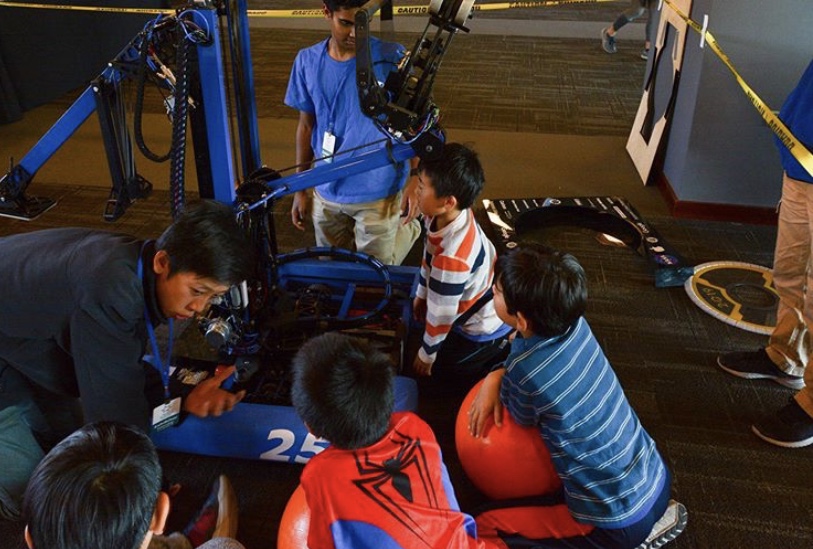
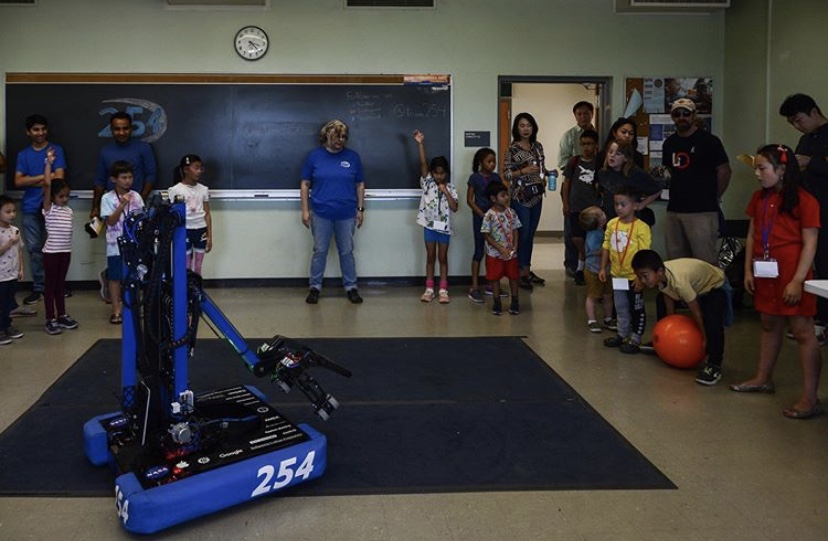
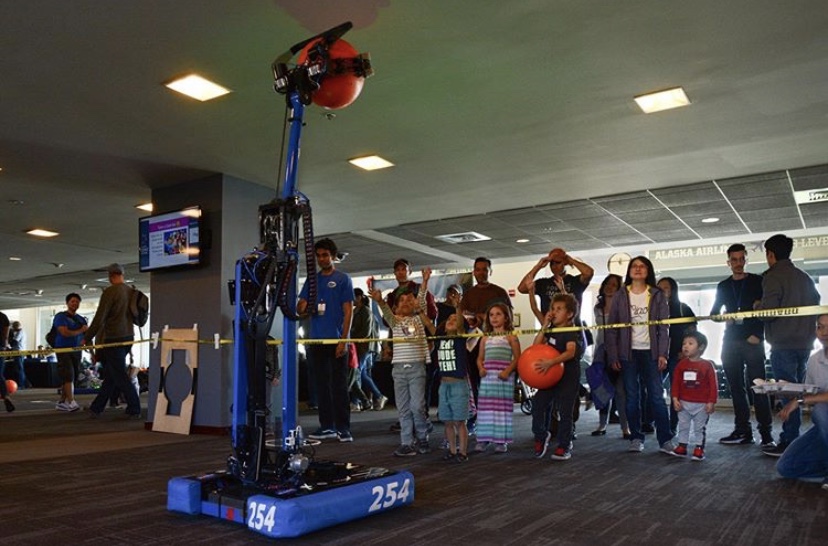
2019 Bellarmine VEX Tournament
A Brief Summary
This past weekend, we hosted the Bellarmine Bay Area VEX Tournament, an annually hosted tournament hosted by Team 254’s VEX Program. We had five of our VEX Teams (254B, 254D, 254F, 254W, 254X) compete in the tournament. Congrats to VEX Team 315K Paradigm and VEX Team 3324V Supernovas-Fusion for winning the tournament! We would also like to shoutout VEX Team 3324V for winning the Robot Skills section of the tournament and VEX Teams 95070A Redwood Robotics and 315K Paradigm for winning the Excellence Award.
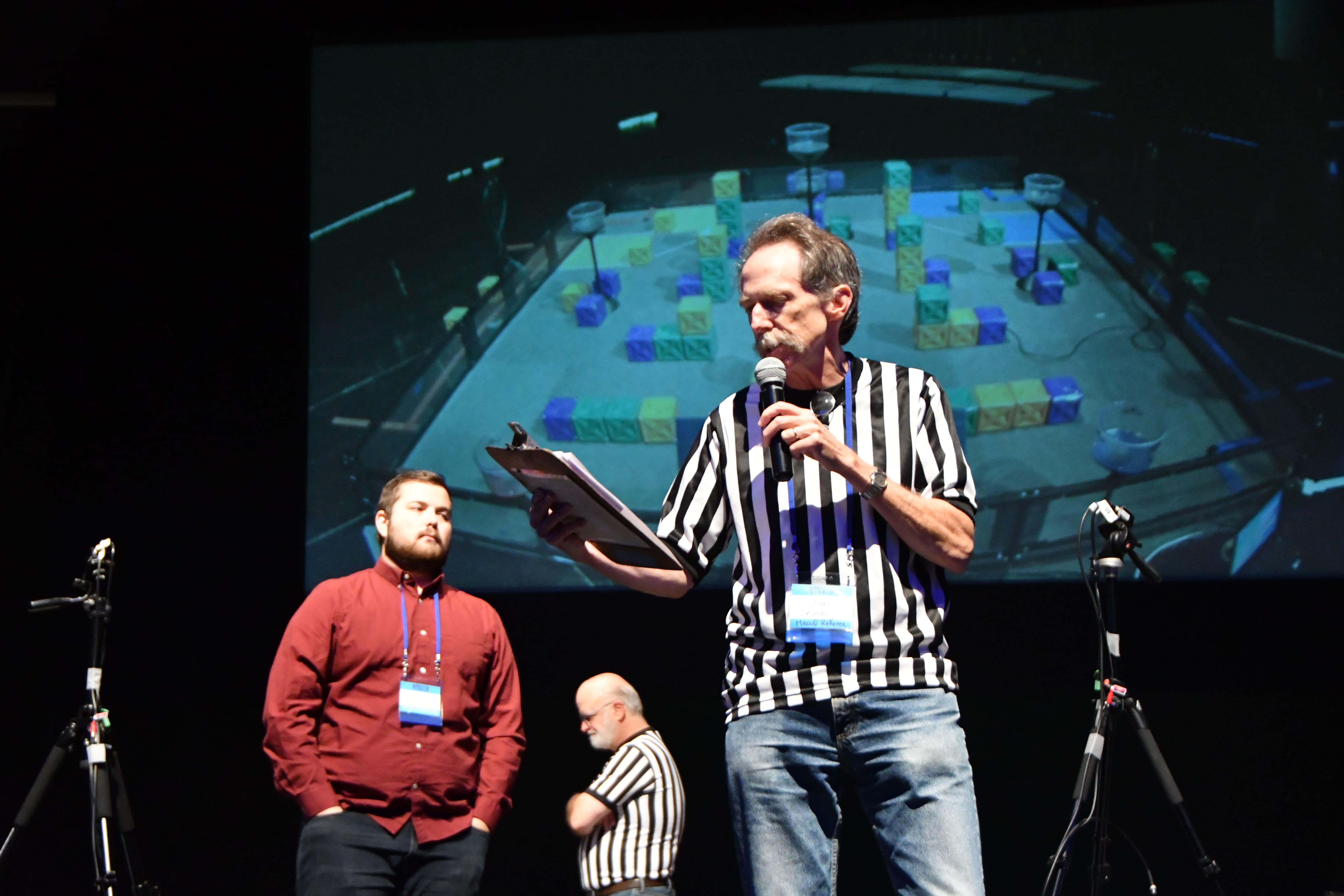
Event Summary and Highlights
General Summary
Overall, the tournament ran smoothly, we had no major hiccups throughout the event and everyone seemed to have had a great time. Our teams saw varying success, as our VEX teams D, W and F made it to eliminations. This event had many firsts for Bell Vex History, to mention a few, this was the first to have a Bell Vex Logo, and the first to have live scoring.
Robot Performance
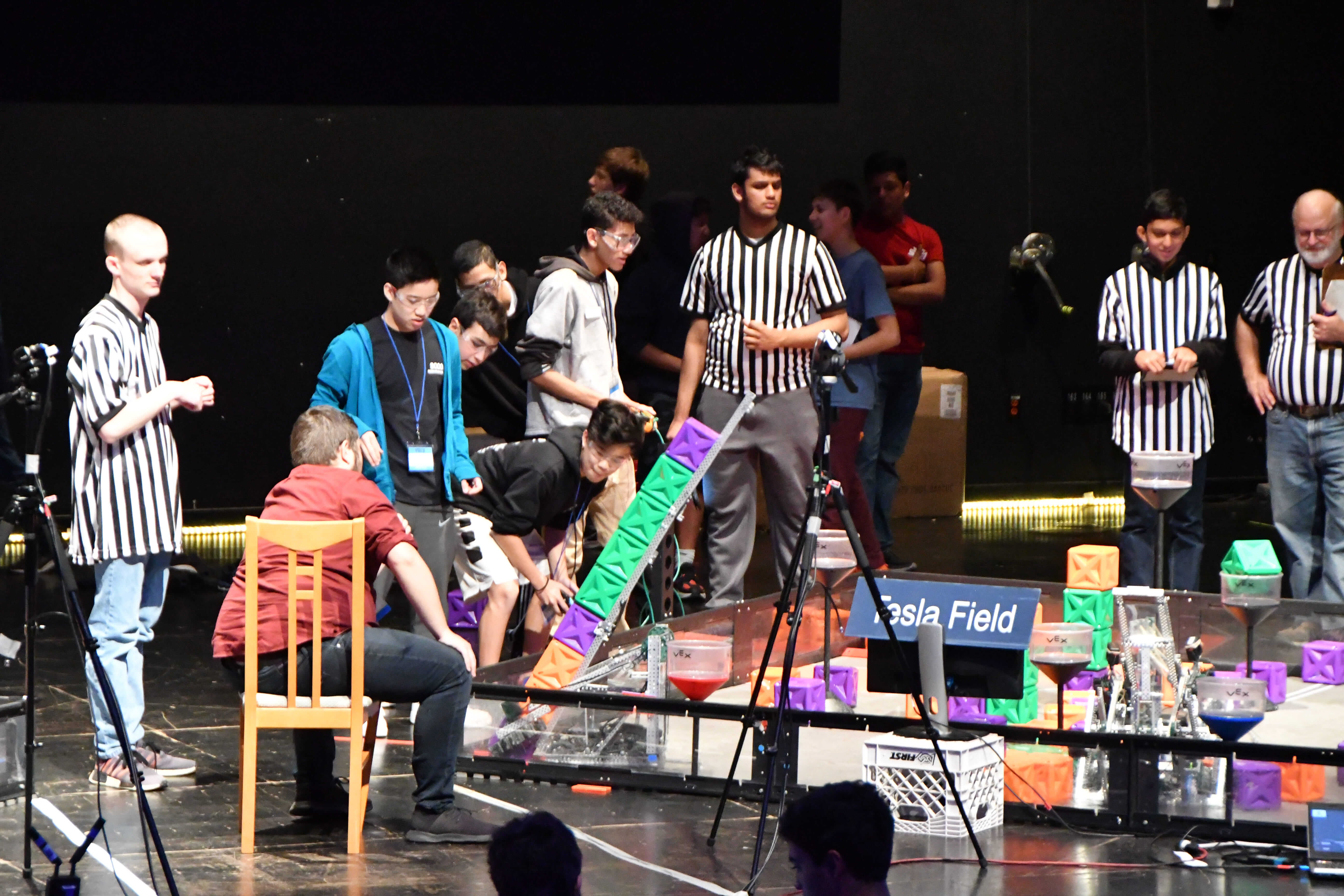
254B
Throughout the tournament 254B was struggling with many issues. Most of the issues stemmed from connection and software issues. The robot’s hardware performed well, but not being able to control the hardware lead to this team’s demise. Unfortunately, this team placed last in the tournament. But, it was a great learning experience for the team.
254D
This team was also struggling with various software issues, their automatic positioning system was not working according to plan, leaving them to recreate their autonomous routes throughout the tournament. They were also having trouble getting their massive tray to deploy properly. Ultimately, they ended up near the bottom of the rankings. Because of their past success, 254W chose to pick them as their alliance partner, but lost in the round of 16.
254F
During the qualification matches, the robot performed really well, we were able to slow down the other teams with our very defensive robot. The six motor drive base really helped us push through all the cubes and defend very effectively. Our new and improved arm allowed us to be the fastest team at scoring cubes into the towers while also being able to stack cubes reasonably quickly. We ended up ranked in 7th place and we made it all the way to semifinals.
254W
This team had won 4 of 6 qualification rounds and placed in 20th after qualification rounds. Their new intake design was not working according to plan, causing them to focus on tower control instead of their designed purpose, cube stacking. Fortunately this worked out for their benefit, this team became ranked 23th and decided to choose 254D as their alliance partner. They then lost in the round of 16.
254X
Throughout qualification matches this robot struggled quite a bit. Resulting in 2 wins and 4 losses, this team placed in 45. They had issues stemming from their lift and intake. These issues resulted in slow intake speed and an inability to score very quickly or in high quantities.
A Special Thanks
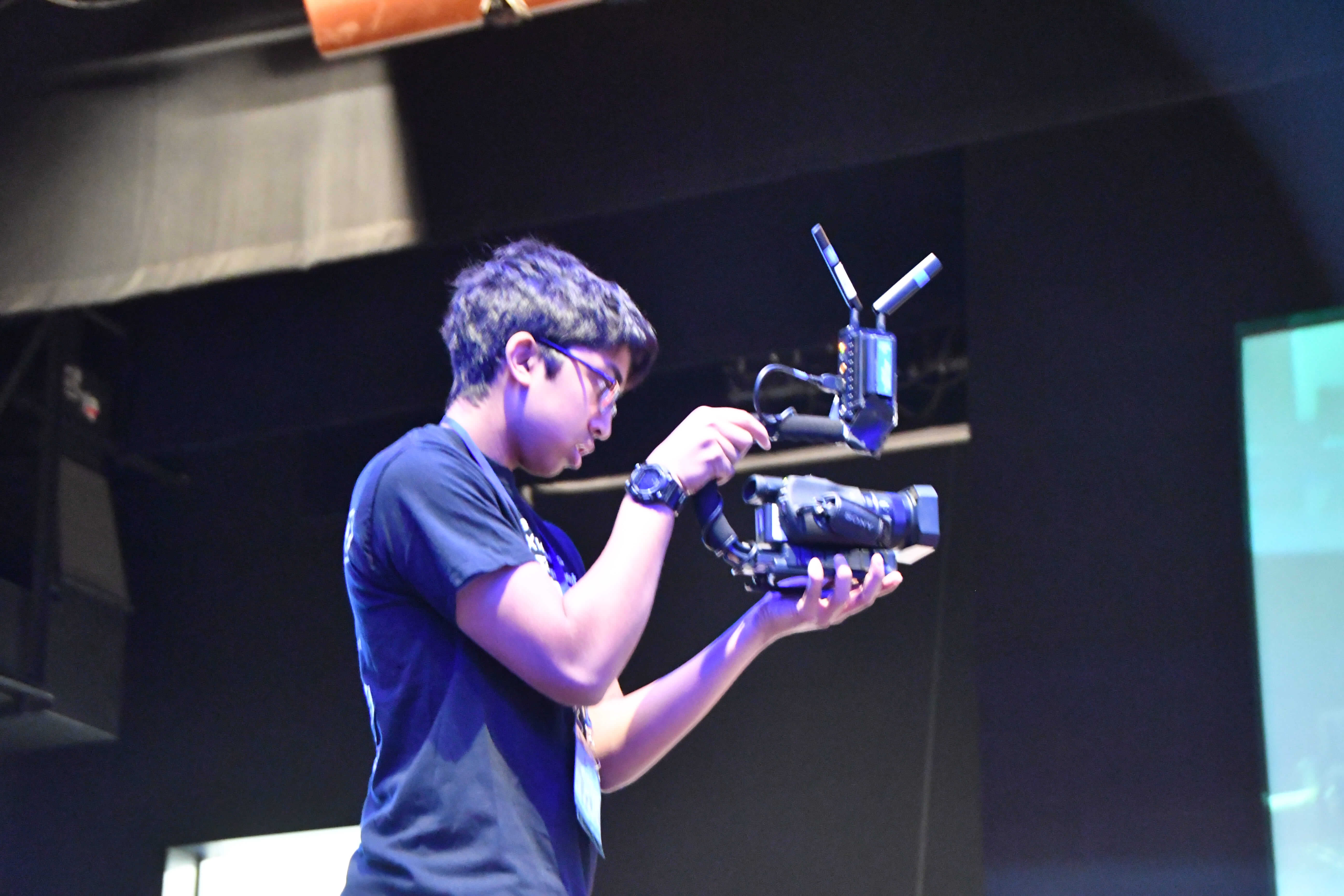
At Bell Vex, we would not have been able to be so successful without the amazing teams that attended the tournament. We would also like to thank all the volunteers and judges that made this tournament an exciting experience, and all of our mentors, teachers, and parents who helped run the tournament smoothly.
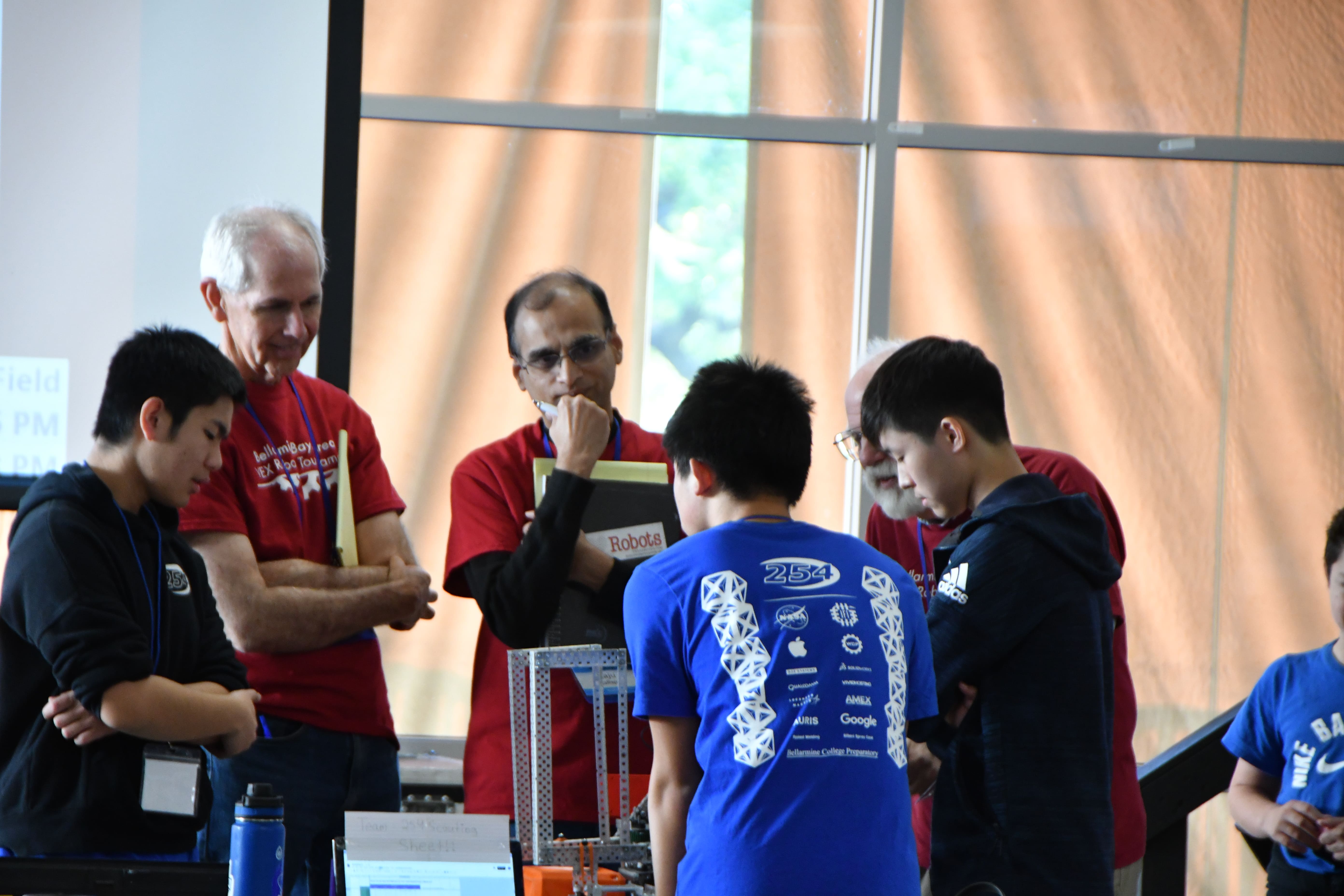
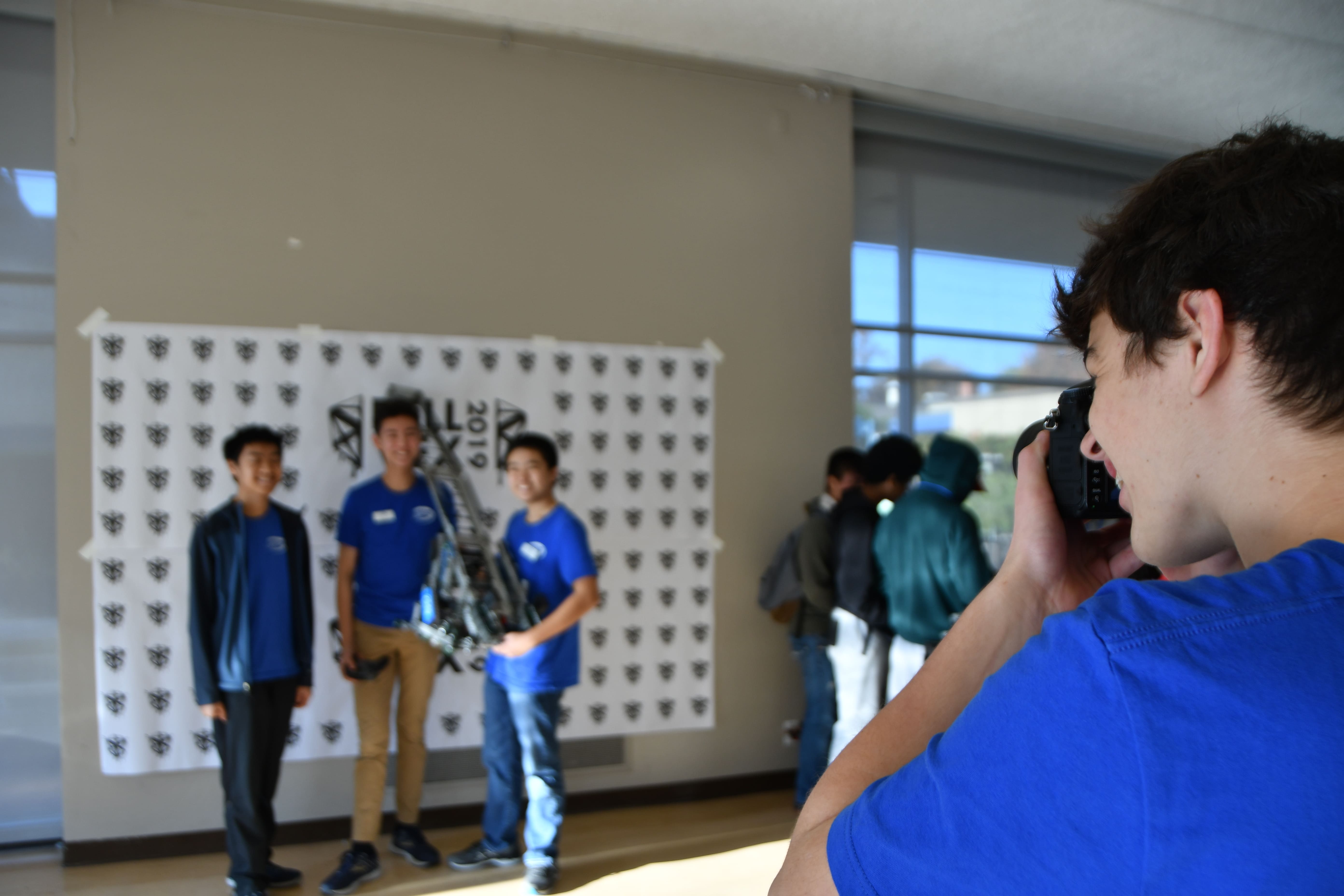
Chezy Champs 2019
A Brief Summary
As part of an eventful weekend, we hosted Chezy Champs, our annually hosted offseason tournament at Bellarmine College Preparatory, in our hometown of San Jose, CA. We had a great time jumping back into action with our robot, Backlash, before the start of the 2020 FRC Season. Alongside, Team 3647 Millenium Falcons, Team 971 Spartan Robotics, and Team 5700 SOTA Cyberdragons, we were able to win the tournament!
Team 254 and alliance partners Team 971 climb the HAB at the end of an elims match
Event Summary and Highlights
Robot Performance
Backlash scores cargo into the rocket shop during a quals match
Throughout our qualification matches, we sought to earn the maximum number of ranking points, which meant prioritizing scoring in the rocket in every match to get the rocket RP, as well as climbing and scoring enough points to win. We employed a new rocket RP scoring style that allowed us to utilize our partners well. Since opposing defense was much better at Chezy Champs, we focused on the top two levels of the rocket and let our partners score on the first level. The HAB RP was a bit harder because of the increased point requirement. Thus, we made sure to always climb successfully and also get our partners to park on the platform. We consistently scored double climbs in our matches.
By the elimination period, we focused on simply winning our matches. We scored as many points as possible by scoring as many cargo balls as possible since they were worth more than hatches. We wanted to score enough hatches such that we had multiple points to score at any moment and avoid getting caught up by defense. We ran our cargo ship autonomous program to place hatch panels on the first two side slots of the cargo ship and then filled the rocket during most of our matches. Sometimes, we switched between the task of scoring hatches and cargo with Team 971 to confuse defensive opponents.
Alliance Selection
Going into the elimination period, we chose to form an alliance with Team 3647 Millenium Falcons, Team 971 Spartan Rootics, and Team 5700 SOTA Cyberdragons.
Team 254 representative, Safwaan Khan, poses with our chosen alliance partners
A Special Thanks
At Chezy Champs, we would not have been able to be so successful without the amazing teams that we were able to work with during our matches. Also a special shout out to our pit crew and drive team for properly maintaining our robot during the tournament. We would also like to highlight the efforts of our alliance readiness crew to keep our alliance partners ready throughout the tournament. Team 254 would also like to thank all the volunteers and judges that made this tournament an exciting experience, and all of our mentors, teachers, and parents who supported us and helped us succeed in this tournament.
Members of Team 4183, Bit Buckets Robotics, hold up their newly acquired Chezy Champs swag
254 member, Safwaan Khan, in action as a scorekeeper
Drive team members, Jack Gnibus and Marcus Ma, enthusiastically clean up the field during a lunch break
Hot San Jose Nights 2019
Event Summary
On September 7th, Team 254 appeared at the 11th Annual Hot San Jose Nights at the Reid-Hillview Airport in San Jose, CA to demonstrate our 2019 season robot, Backlash. We talked about our 2019 season, what we do as a robotics team, and how others can get involved in robotics. To entertain some of the kids that came to see our robot, we even played catch with game pieces using our robot. Many of our team members were also able to speak with other parents about the FIRST Program and how their children could get involved. This event allowed us to share our knowledge and experiences with the surrounding community.
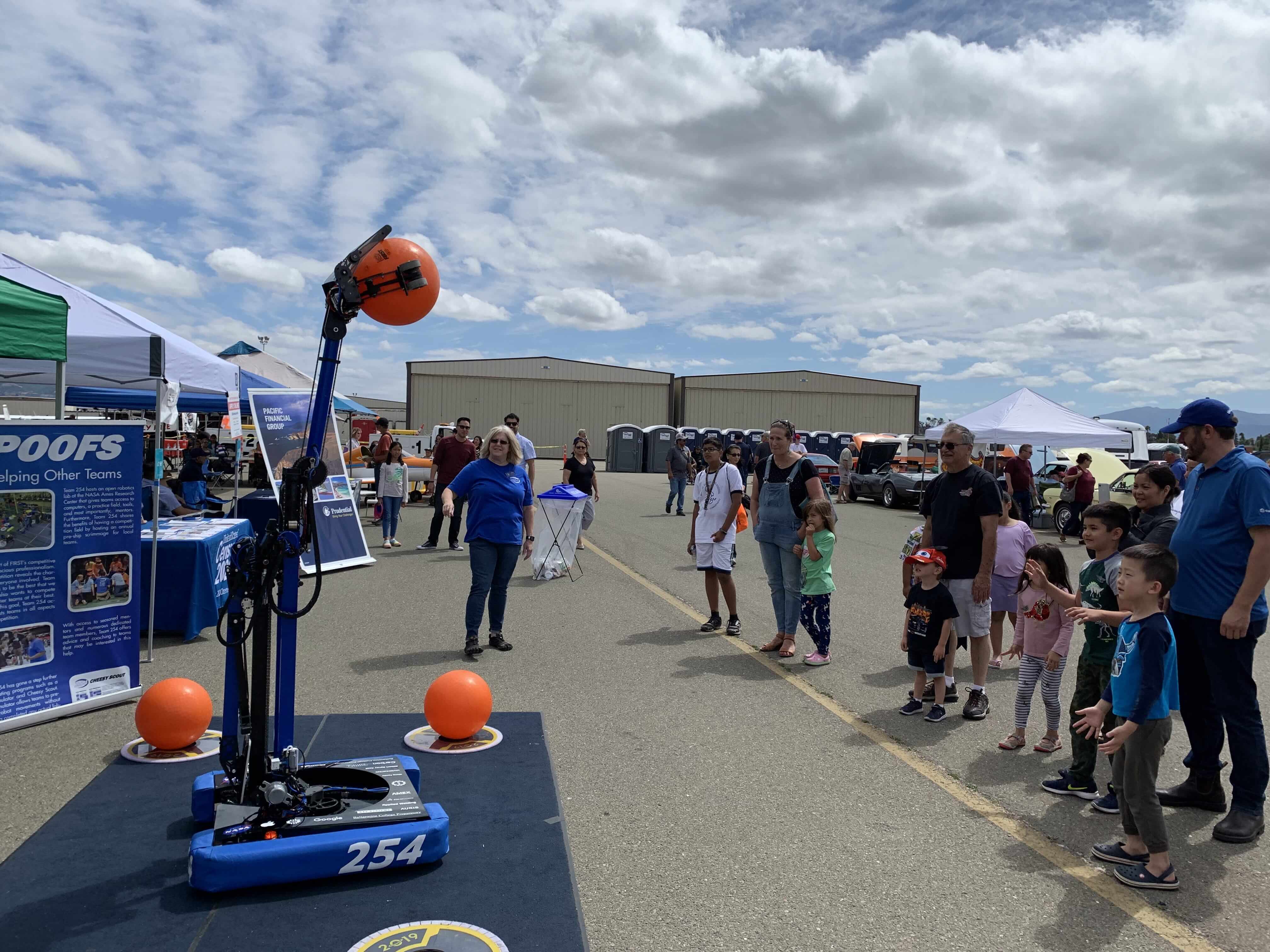
Team 254 President, Jack Gnibus, and Members, Marcus Ma and Emiliano Hansen, show Backlash to the surrounding crowd.
Our Experiences
Outreach leader, Safwaan Khan said, “Hot San Jose Nights was an amazing and exciting first event to attend as Outreach Director. Not only did I get to talk about robots, something I love to do, but I also got to interact with both children and adults. I got to show and explain the functions of the robot to children, and I got to explain the processes in which we construct our robot to adults. Overall, the event was a great way to meet and play with others in our community.” Our team allowed visitors to touch our robot and look at it up close, while also answering any of their questions about our robot. In general, people were astonished to see the speed of our robot and how tall it could expand, and several people asked how they could get involved with what FIRST has to offer. Overall, Hot San Jose Nights was an outstanding outreach event and we wish to continue making an impact in our community!

A crowd of onlookers observe Backlash in action!
2019 FRC World Championship
A Brief Summary
Last week, we attended the 2019 FIRST World Championship in Houston, Texas from April 17th to April 20th. Assigned to the Turing Division, we won the Division Championship Award and the Industrial Design Award sponsored by General Motors.After becoming the Turing Division Champions, we executed a well-planned strategy alongside FRC Team 3310 Black Hawk Robotics, FRC Team 6986 PPT Bots, and FRC Team 948 NRG (Newport Robotics Group), allowing us to earn the second place title at the 2019 FRC World Championship in Houston!
Team 254 poses for a picture at the Hall of Fame Lunch in the George R. Brown Convention Center
Robot Performance
Qualification Matches (Turing Division)
Throughout our qualification matches, we sought to earn the maximum number of ranking points, which meant prioritizing scoring in the rocket in every match to get the rocket RP, as well as climbing and scoring enough points to win. Since we were competing in the 2019 FRC World Championship, most teams could fill a rocket with cargo by themselves or with another team on our alliance, which made our strategy easier to execute. When we were with partners who could manage scoring on the rocket themselves, we primarily worked on distracting defense. Seeing as finishing a rocket is incredibly hard under defense, giving the other teams an open other side of the field allowed them to finish their rocket as we worked on ours. In other matches, where we did not have partners capable of finishing the rocket, we accomplished the task ourselves, while fighting through the defense the best we could. We also made sure to finish each of our matches by climbing onto the HAB, so we could get the HAB docking ranking point. Luckily, we were with many other level 3 climbers, allowing us to stay out in the field longer as they climbed, but we always attempted a double climb for more points with the new climber.
We also kept tiebreaker points in mind during our divisional qualification matches. If there happened to be a tie in ranking points, we always prioritized scoring cargo to boost that metric. It also worked well seeing that cargo balls are worth more than hatch panels.
Alliance Selection
Going into the elimination period in the Turing Division, we chose to form an alliance with FRC Team 3310 Black Hawk Robotics, FRC Team 6986 PPT Bots, and FRC Team 948 NRG (Newport Robotics Group).
Team 254 representative, Brandon Chuang, poses with our chosen alliance partners
Elimination Matches (Turing Division)
During our elimination matches, we focused all our efforts on winning our matches. Since ranking point didn’t matter, we focused on scoring more matchpoints. We put most of our efforts into scoring as many cargo balls as possible, because they were worth more than hatches. We wanted to score enough hatches such that we had multiple points to score at any moment to allow for us to change our scoring location and not get stopped by defense. We ran our cargo ship autonomous program to place hatch panels on the first two side slots of the cargo ship, and then filled the rocket and did any other tasks throughout the rest of the matches.
Backlash with alliance partner, Team 3310, at the end of a match
On the Einstein Field
We generally maintained a similar strategy during the Einstein matches as in theTuring Division elimination round, by placing a larger focus on the number of matchpoints we scored. However, we used the amount of cargo scored was used as a metric in case any matches ended in a tiebreaker. We made it to our final tiebreaker match on the Einstein field and, unfortunately, lost due to an amazing performance carried out by FRC Team 1323 MadTown Robotics, FRC Team 973 Greybots, and FRC Team 5026 Iron Panthers, the Newton Division winners, allowing us to earn the second place title.
A Special Thanks
At the 2019 FIRST World Championship in Houston, we would not have been able to be so successful without the amazing teams that we were able to work with during our matches. Also a special shout out to our pit crew and drive team for properly maintaining our robot during the tournament. We would also like to highlight the efforts of our alliance readiness crew to keep our alliance partners ready throughout the tournament. Team 254 would also like to thank all the volunteers and judges that made this tournament an exciting experience, and all of our mentors, teachers, and parents who supported us and helped us succeed in this tournament.
Members of the Team 254 Pit Crew repair Backlash before an upcoming match
Our drive team poses for a picture on the Einstein Field
An action shot of Team 254’s suction climber at the end of a divisional qualifications match
2019 Silicon Valley Regional Champions!
A Brief Summary
As part of an eventful weekend, we attended the 2019 Silicon Valley Regional, in San Jose, CA. We had a great time at our second tournament of the FIRST Destination: Deep Space Season with our robot, Backlash. We won the Engineering in Excellence Award sponsored by Delphi. Alongside FRC Team 5499 The Bay Orangutans and FRC Team 6418 The Missfits, we were able to win the tournament, earning our 20th Blue Banner at the Silicon Valley Regional!

Team 254 and alliance partners Team 5499 and Team 6418 pose for a picture with Backlash after winning at the 2019 Silicon Valley Regional
Robot Performance
Qualification Matches
Throughout our qualification matches, we executed a strategy in which our goals were to fill one full rocket for a ranking point and to climb to level 3 of the HAB zone at the end of every match. We encountered consistent defense from most opposing alliances, resulting in our failure to fill in a rocket in a few matches. We also tried to maximize scoring cargo balls since it was the tiebreaker metric when it came to matches in which each alliance earned the same number of ranking points. We also maximized the amount of cargo balls scored during qualification matches since cargo balls are worth more in point value than hatch disks. At the tournament, we experimented with a new form of counter defense that involved our alliance partners blocking an opposing alliance’s robot to clear a path to the rocket for us to score. We ended up with a record of 9-0-0 during the qualification match period.
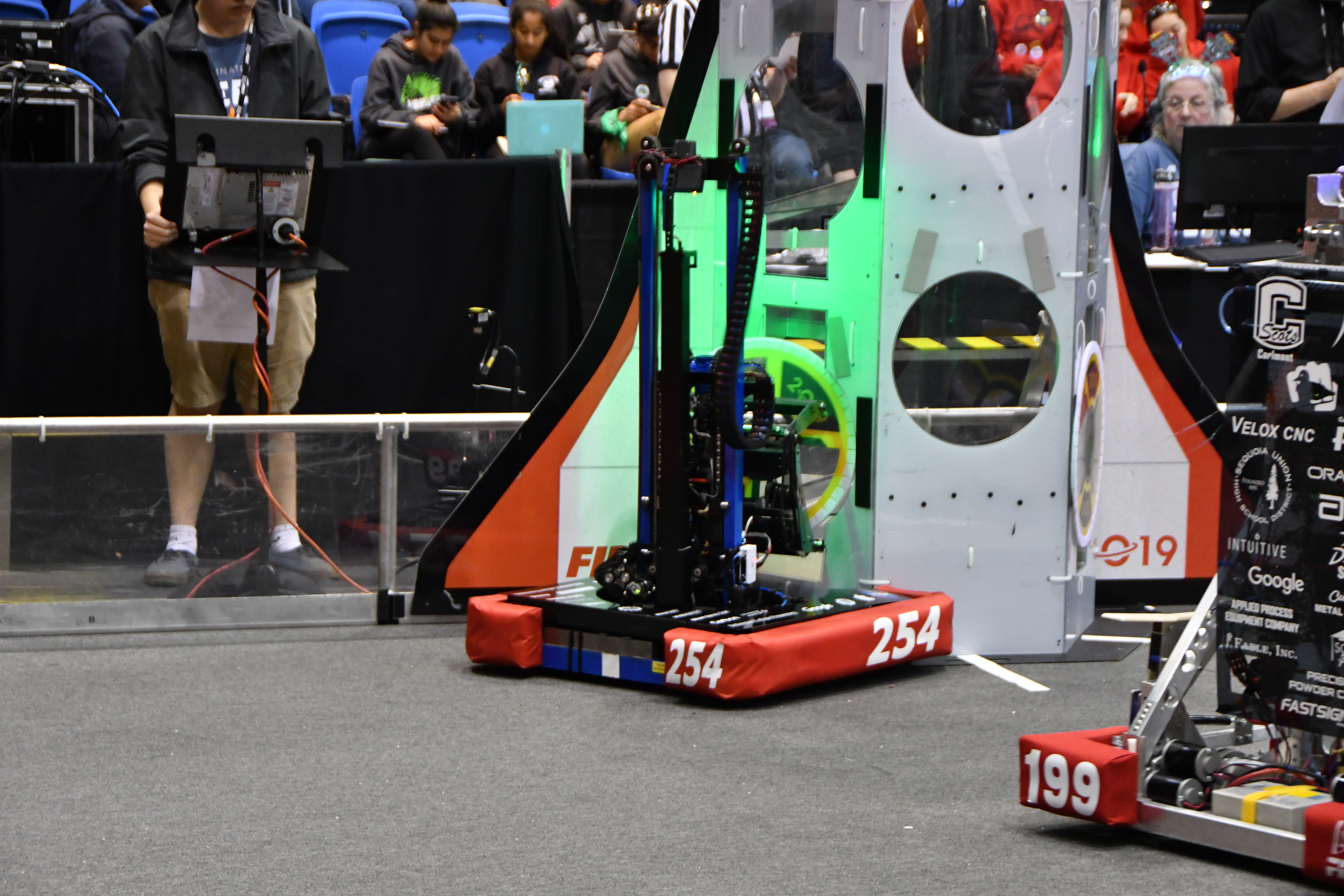
Team 254 places a hatch onto the rocket during the tele-operated period
Alliance Selection
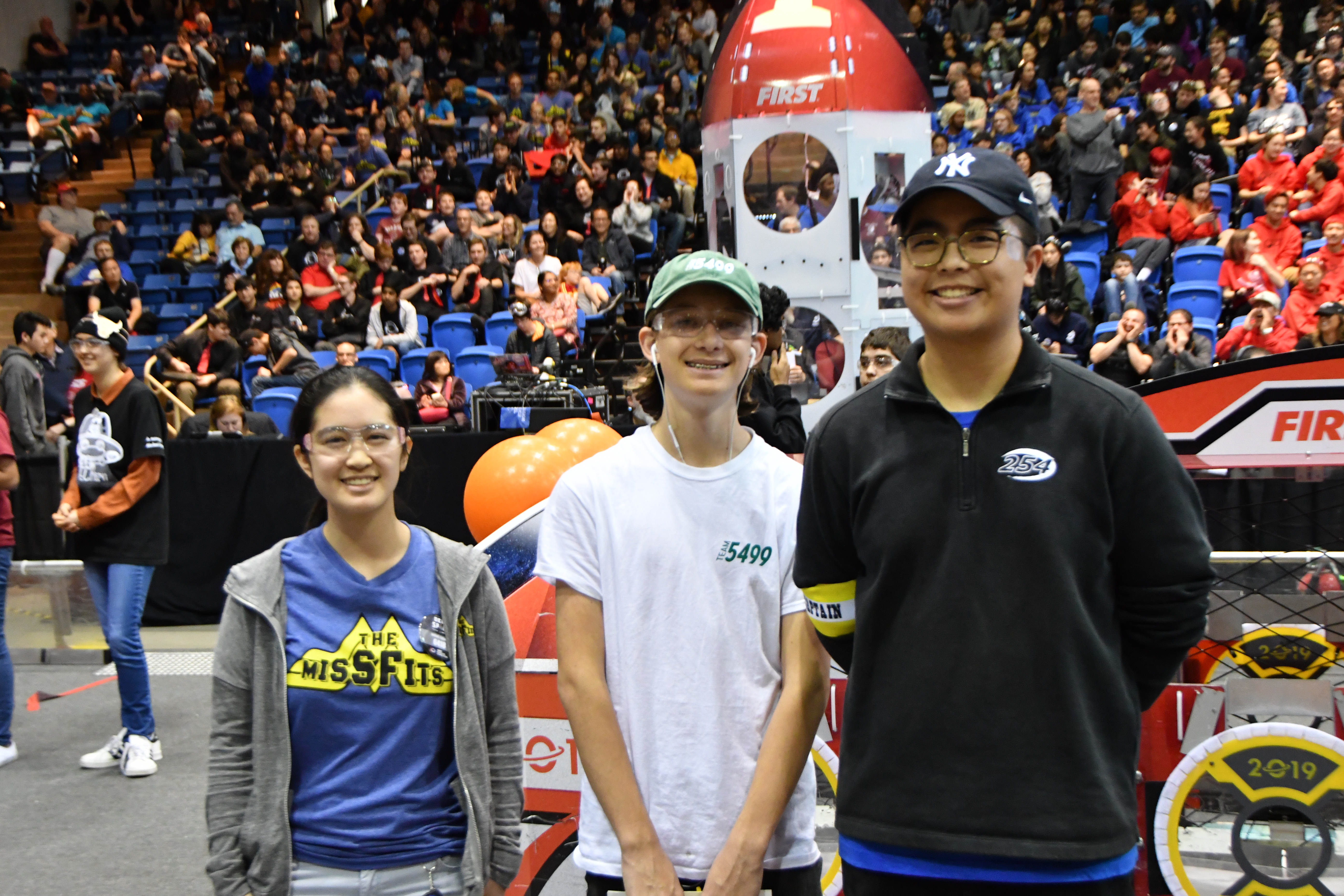
Team 254 representative, Brandon Chuang, stands with Team 5499 and Team 6418 as they agree to join our alliance
Going into the elimination period, we were excited to join an alliance with FRC Team 5499 The Bay Orangutans and FRC Team 6418 The Missfits.
Elimination Matches
During the elimination period, we employed a very dynamic, new strategy that involved our robot and Team 5499’s robot to cross paths in order to draw and confuse defense from the opposing alliance. This strategy was employed to maximize our total cargo score. We knew that Team 5499 was great at scoring cargo, so we did our best to open spots for them to score by placing hatches on the lower two levels of the rocket and the front of the cargo ship. Once each of these areas had a hatch in place, we began scoring cargo. This strategy worked well against defense because the crossing of paths by our robot and Team 5499 confused the opposing alliance’s defense robot. Team 6418 did a great job focusing on playing heavy defense on the opposing alliance.
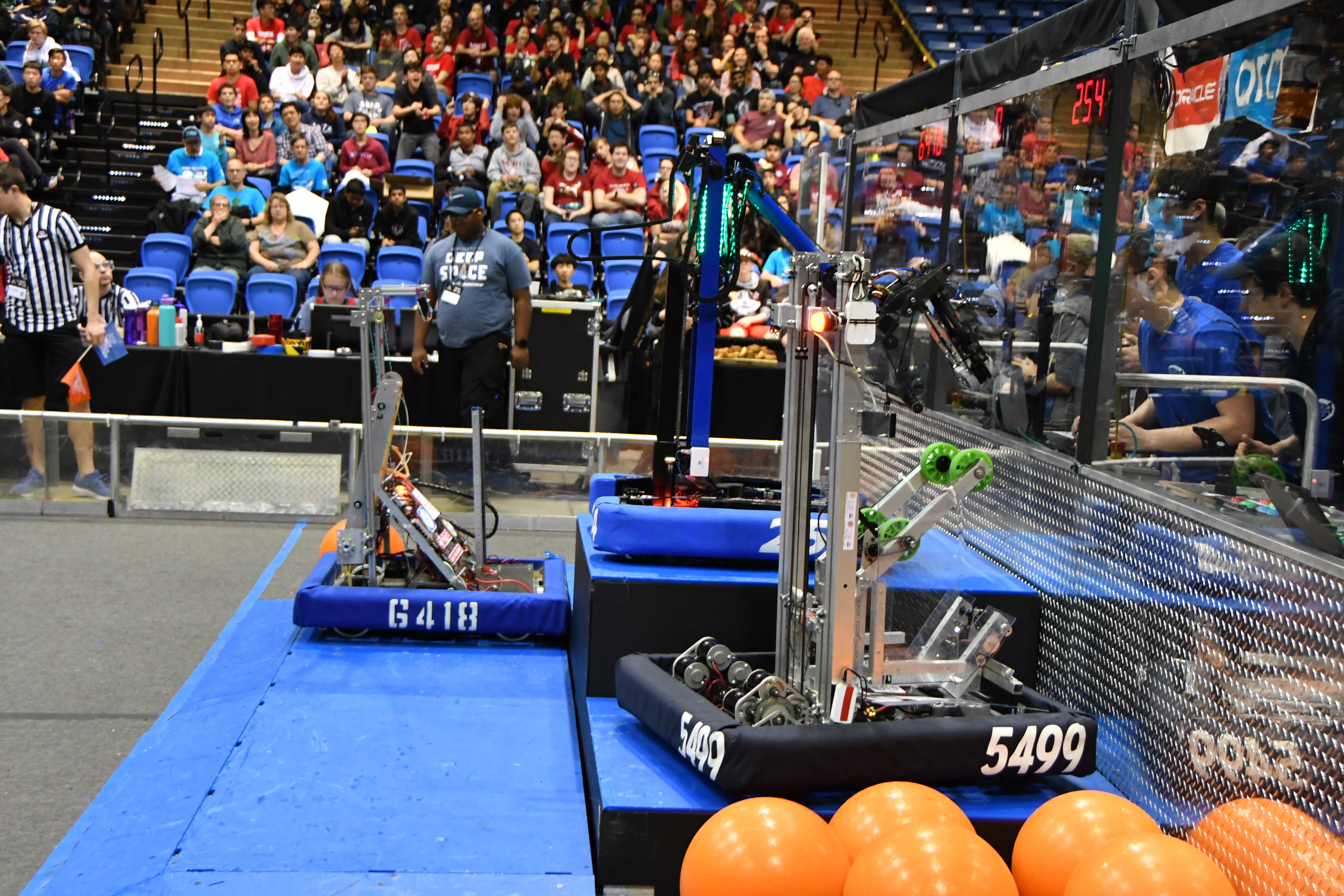
Team 254 and alliance partners Team 5499 and Team 6418 climb onto the HAB Zone at the end of an eliminations match
A Special Thanks
At the Silicon Valley Regional, we would not have been able to be so successful without the amazing teams that we were able to work with during our qualification and elimination matches. Also a special thanks for our pit crew and drive team for properly maintaining our robot during the tournament. A big thank you to the chairman’s presentation team for handling our team’s Chairman’s Presentation in front of a panel of FIRST Judges. Team 254 would also like to thank all the volunteers and judges that made this tournament an exciting experience, and all of our mentors, teachers, and parents who helped us succeed in this regional.
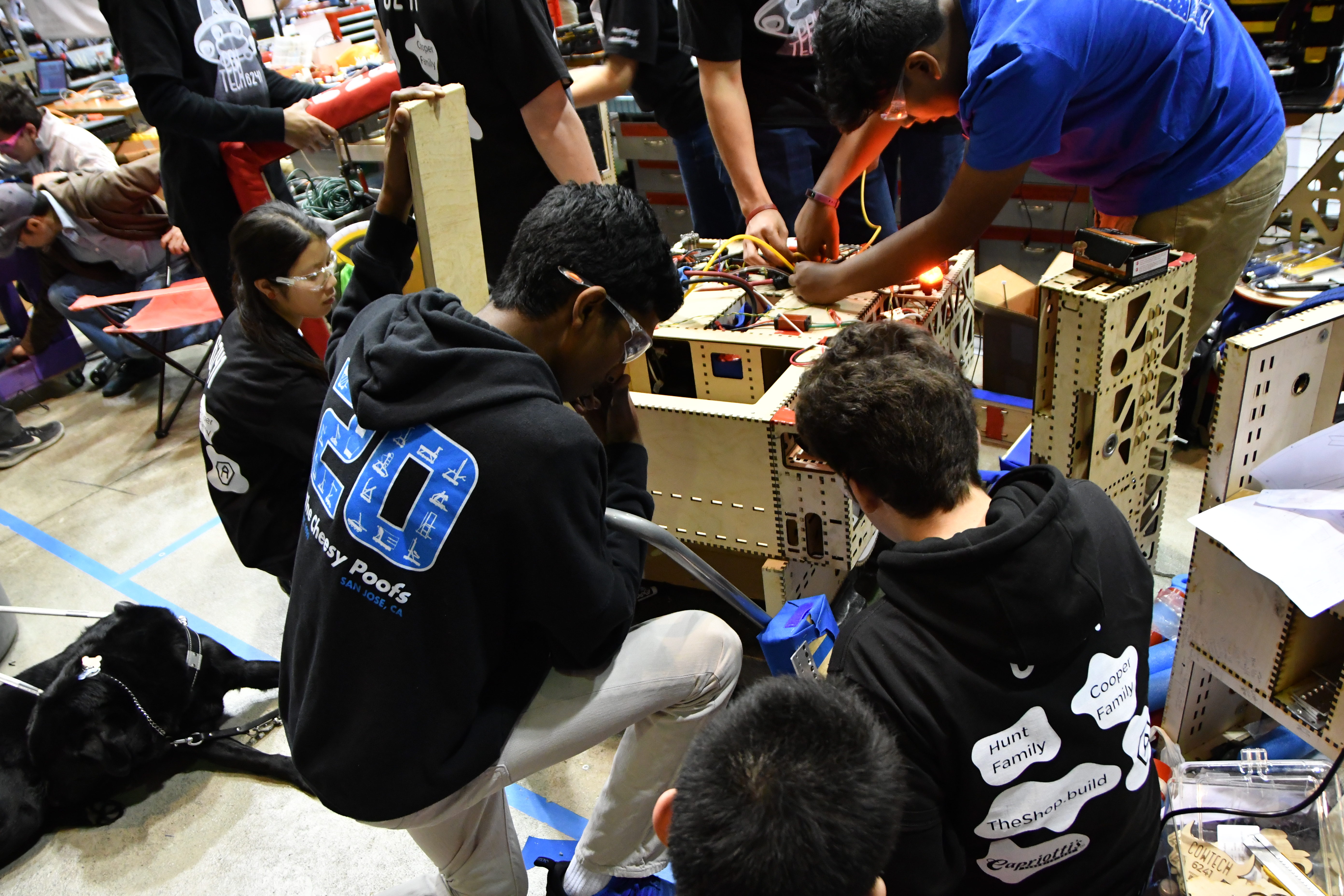
Our alliance readiness crew assists Team 6241 in before an upcoming qualifications match
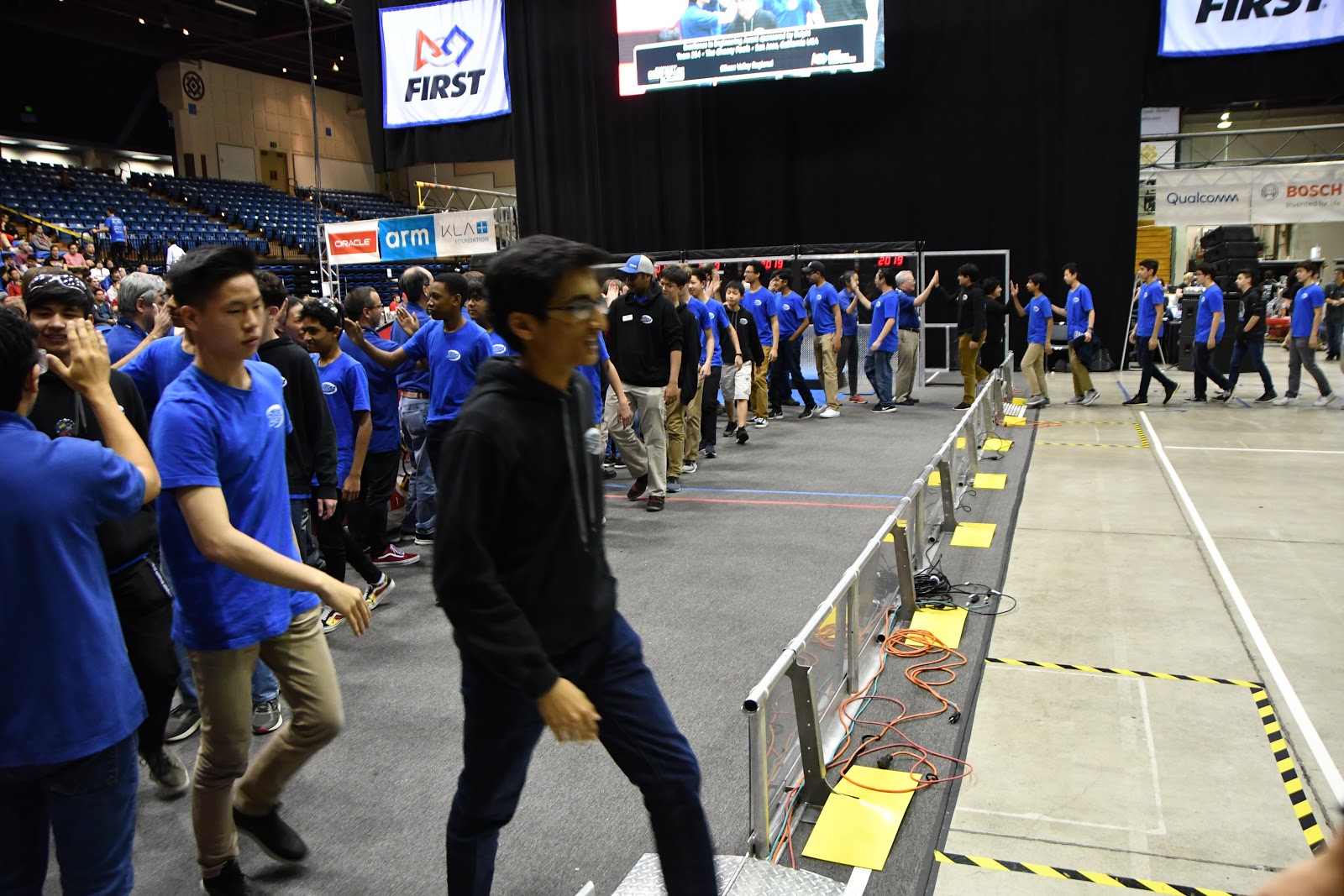
Members of Team 254 are congratulated by judges after winning the Engineering in Excellence Award at the 2019 Silicon Valley Regional
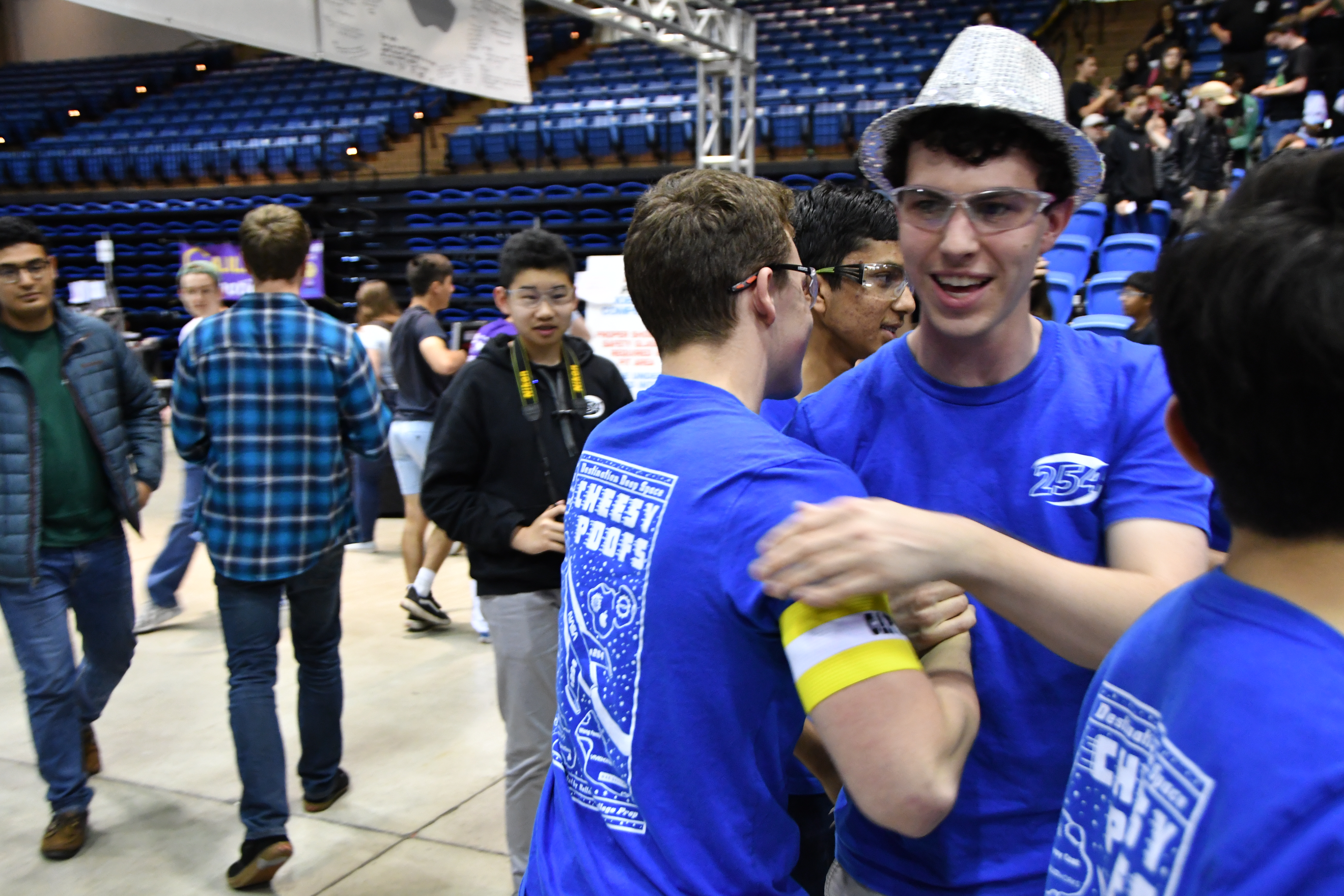
Team 254 Driver, Jack Gnibus, celebrates the regional victory with mentor, Joey Diamond
2019 San Francisco Regional Champions!
A Brief Summary
As part of an eventful weekend, we attended the 2019 San Francisco Regional, in San Jose, CA. We had a great time at our first tournament of the FIRST Destination: Deep Space Season with our robot, Backlash. We won the Innovation In Control Award sponsored by Rockwell Automation for our code. Alongside FRC Team 971 Spartan Robotics and FRC Team 5700 SOTA Cyberdragons, we were able to win the tournament, earning another Blue Banner!

Team 254 poses for a picture with Backlash after winning at the 2019 San Francisco Regional
Robot Performance
Qualification Matches
Throughout our qualification matches, we executed a strategy in which our goals were to fill one full rocket for a ranking point and to climb to level 3 of the HAB zone at the end of every match. We encountered consistent defense from most opposing alliances, resulting in our failure to fill in a rocket in a few matches. We also tried to maximize scoring cargo balls since it was the tiebreaker metric when it came to matches in which each alliance earned the same number of ranking points. We also maximized the amount of cargo balls scored during qualification matches since cargo balls are worth more in point value than hatch disks. We ended up with a record of 10-1-1 during the qualification match period.
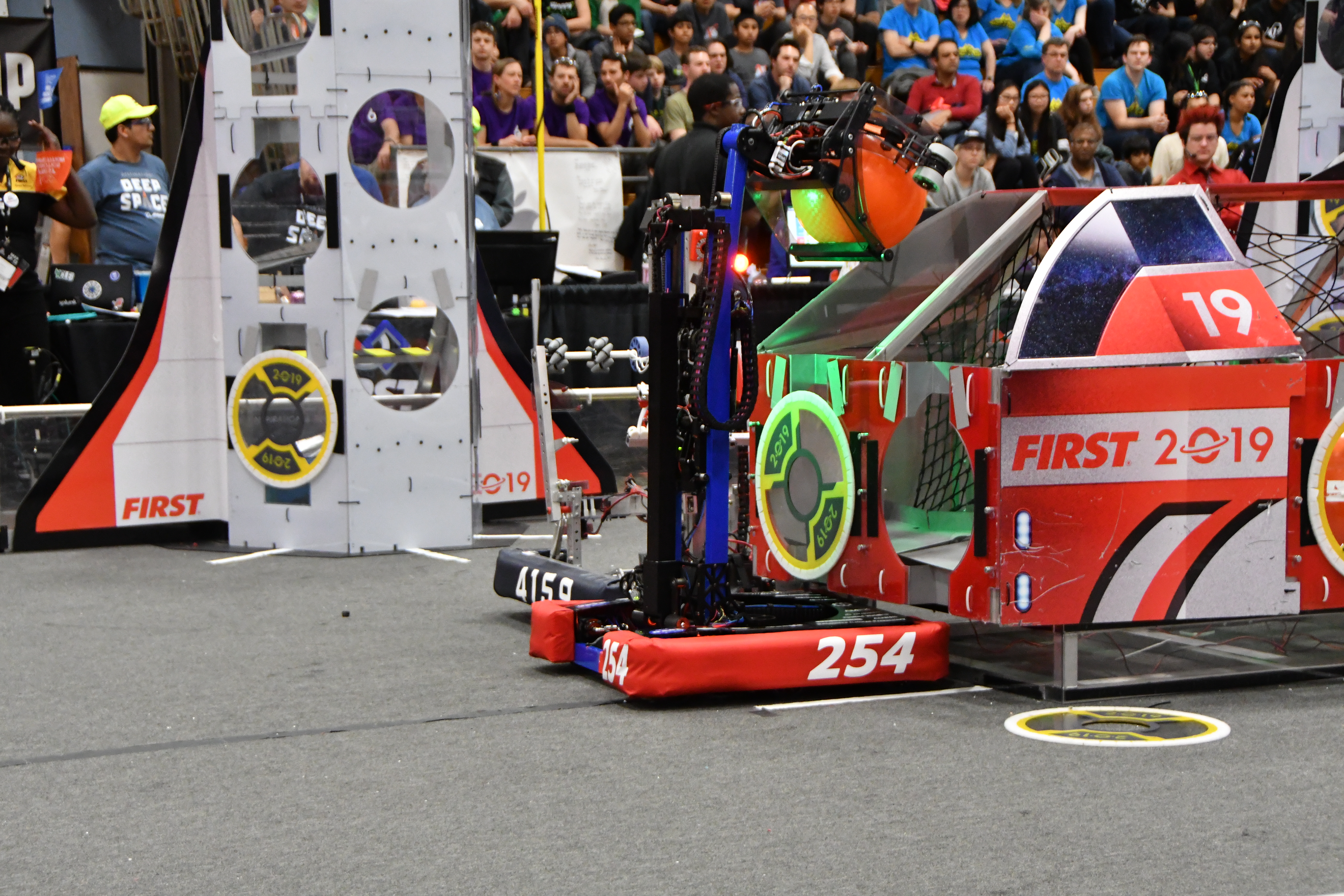
Team 254 places a cargo ball into the cargo ship during the tele-operated period
Alliance Selection
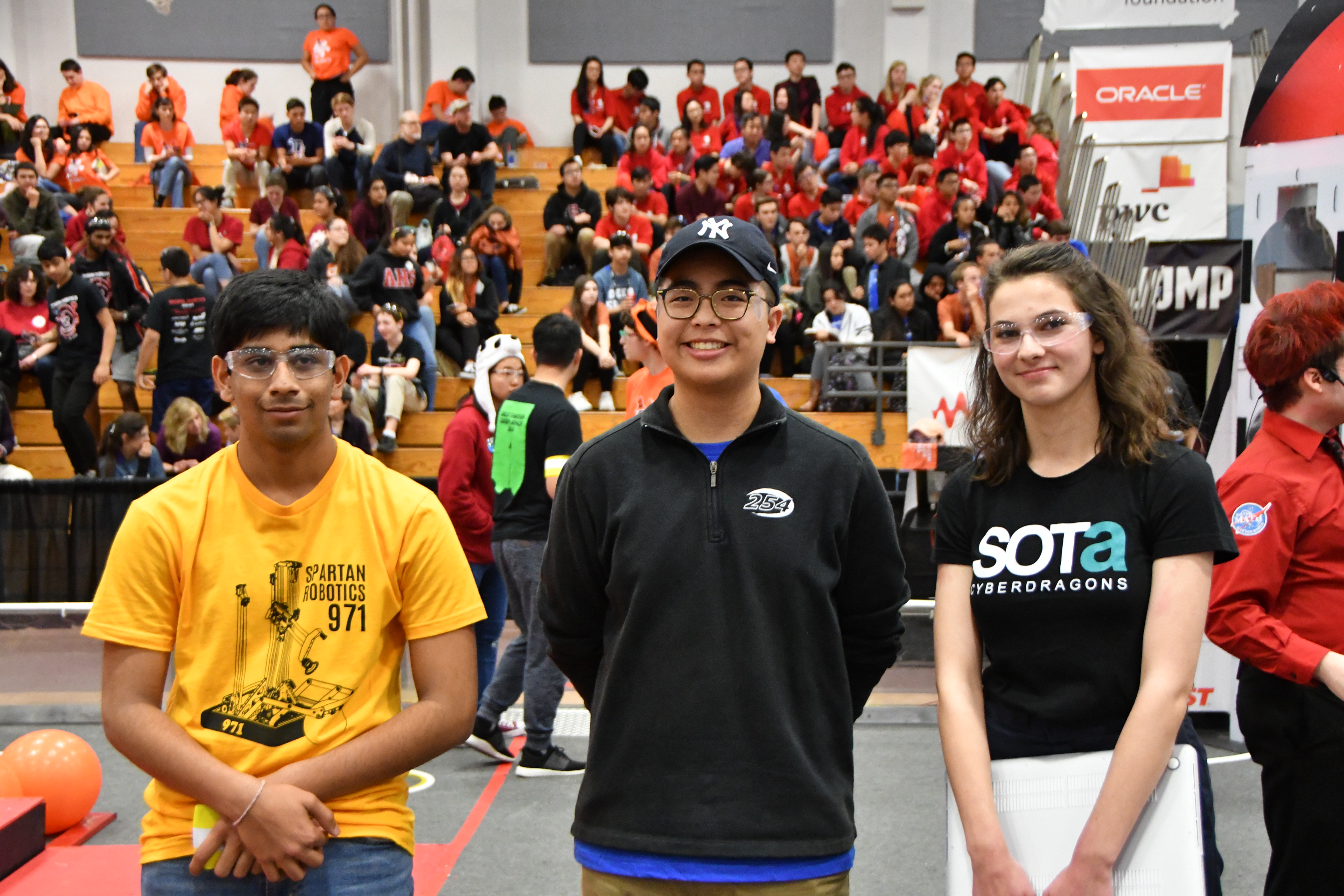
Team 254 representative, Brandon Chuang, stands with Team 5700 as we join Team 971 in an alliance
Going into the elimination period, we were excited to join an alliance with FRC Team 971 Spartan Robotics and FRC Team 5700 SOTA Cyberdragons.
Elimination Matches
Our main goal was to draw defense away from Team 971’s robot, allowing Team 971 to focus on scoring cargo balls. This strategy gave us the opportunity to score more points, since filling up the rocket did not give our alliance an advantage during the elimination period. Though we focused on distracting defense from the opposing alliance, we scored a few hatches for extra points. By scoring hatches on the rocket, we also opened up more options for Team 971 to score cargo balls. If we encountered particularly hard defense, we always had the option of scoring a hatch on level 1 of the rocket and getting around the defense later. This strategy allowed us to continuously have a lead during the match. In endgame, we climbed to either level 2 or level 3 of the HAB. Whenever we chose to execute a double climb, both our robot and Team 971’s robot climbed to level 3 of the HAB. During single climbs, Team 971 focused on level 3 of the HAB while we focused on climbing to level 2 of the HAB.
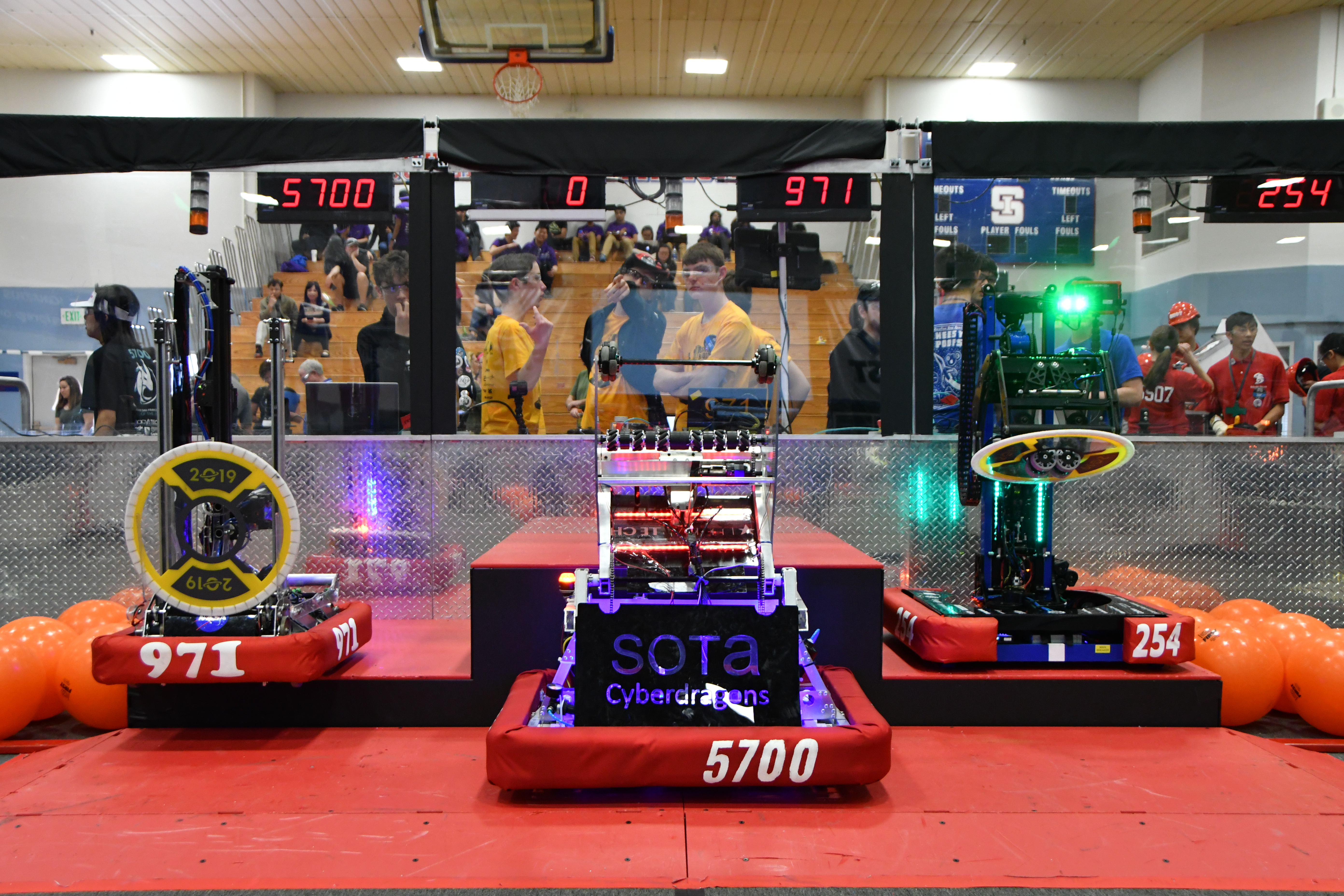
Team 254 and alliance partners Team 971 and Team 5700 load onto the HAB Zone before an upcoming eliminations match
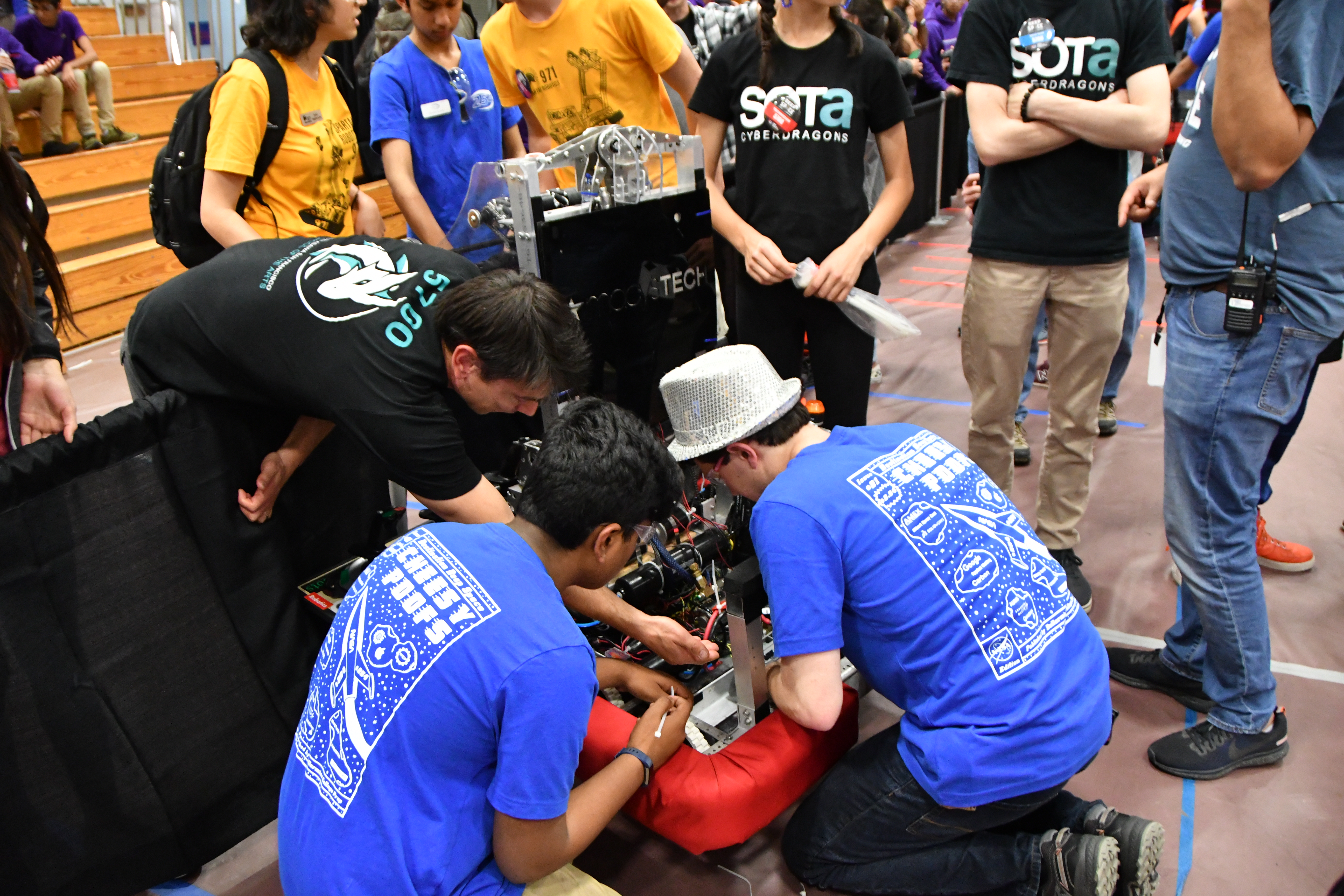
Our alliance readiness crew assists Team 5700 in before an upcoming eliminations match
A Special Thanks
At the San Francisco Regional, we would not have been able to be so successful without the amazing teams that we were able to work with during our qualification and elimination matches. Also a special thanks for our pit crew and drive team for properly maintaining our robot during the tournament. A big thank you to the chairman’s presentation team for handling our team’s Chairman’s Presentation in front of a panel of FIRST Judges. Team 254 would also like to thank all the volunteers and judges that made this tournament an exciting experience, and all of our mentors, teachers, and parents who helped us succeed in this regional.
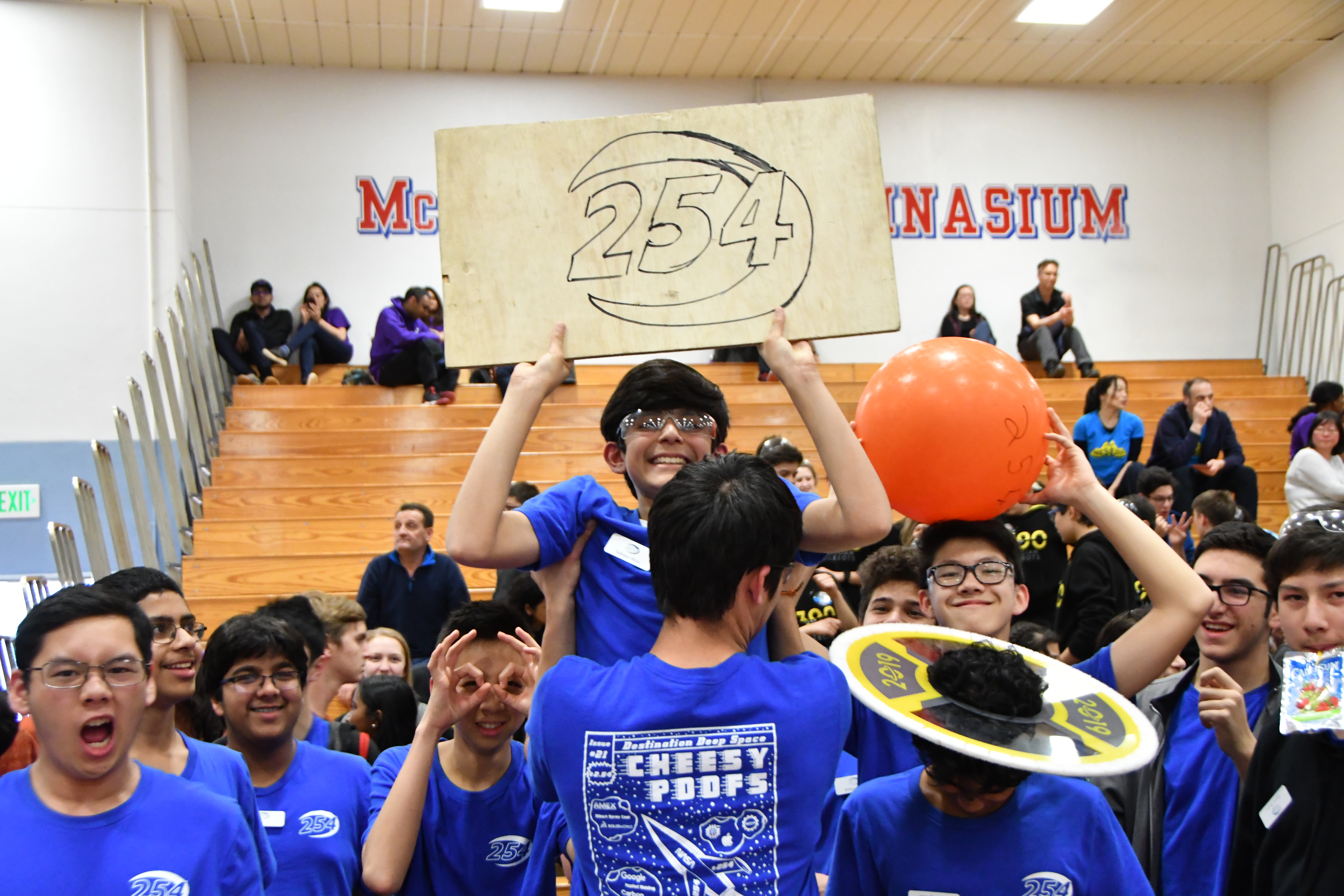
Members of Team 254 cheer enthusiastically after winning a regional

Team 254 Business Development Director, Suraj Roy, discusses our business plan with a judge for the Entrepreneurship Award
Madtown Throwdown Offseason Tournament
A Brief Summary
As part of an eventful weekend, we attended Madtown Throwdown, an annually hosted offseason tournament hosted by Team 1323 (Madtown Robotics), in Madera, CA. We had a great time jumping back into action with our robot, Lockdown, before the start of the 2019 FRC Season. Alongside, FRC Team 1323 MadTown Robotics, their offseason robot (9323), and our own programming robot (9254), we were able to win the tournament!
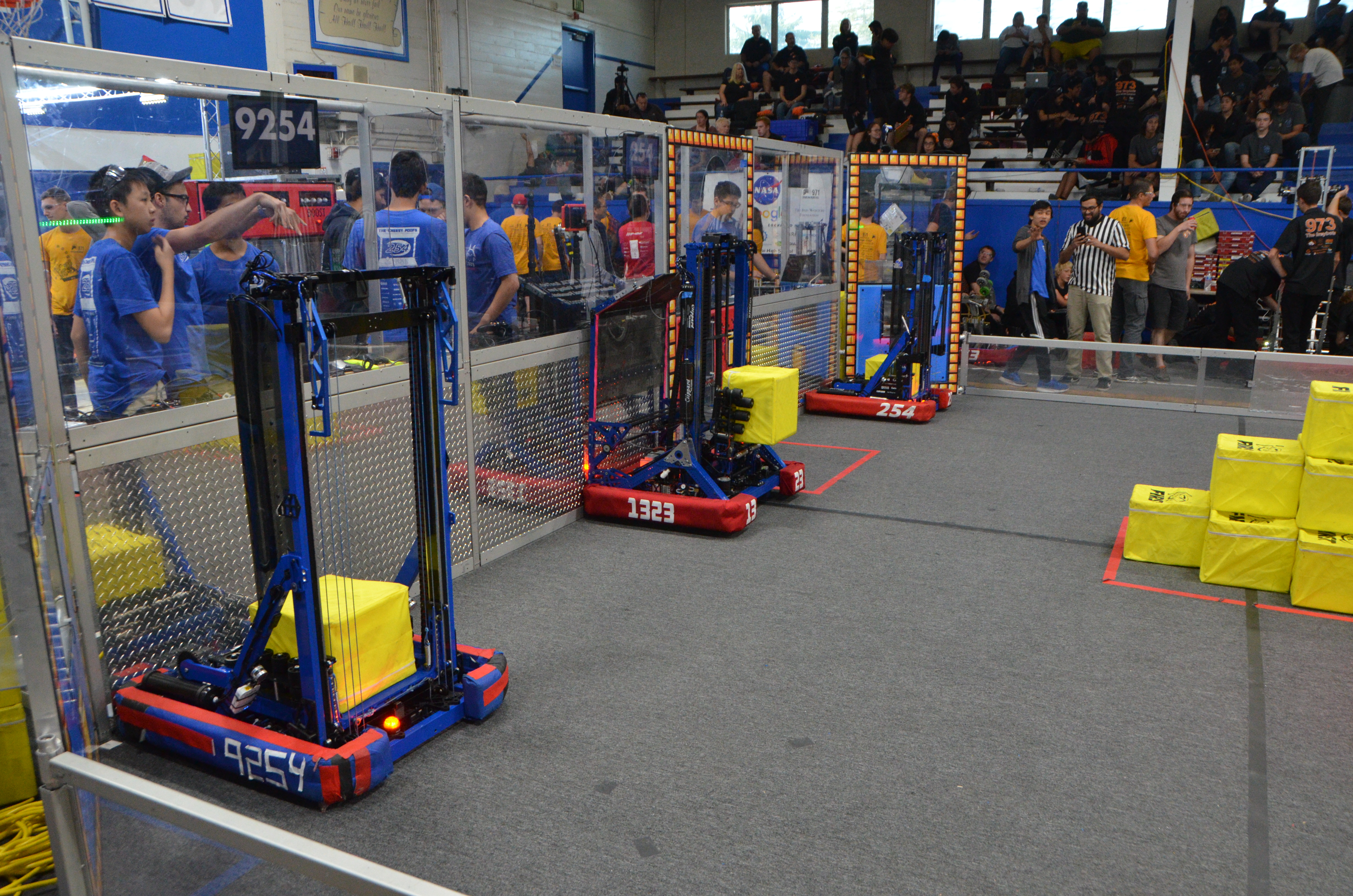
Team 254 and alliance partners Team 1323 and our programming robot 9254 in position before an elims match
Event Summary and Highlights
General Summary
Overall, Madtown Throwdown was a great event for our team. Lockdown, our competition robot, went undefeated 15-0. Our programming robot, was run by an all-freshman pit crew and drive team to ensure that our new members gain a valuable experience before the 2019 FRC Season. The programming robot had a great qualifications match record and was lucky to join Lockdown in an alliance at the tournament. We also had a swerve robot, which we worked on all summer, with a 3-person pit crew, which finished 2nd to last place in the tournament. With rotating pit crews and drive teams, all team members were able to gain some valuable technical experience at the tournament.
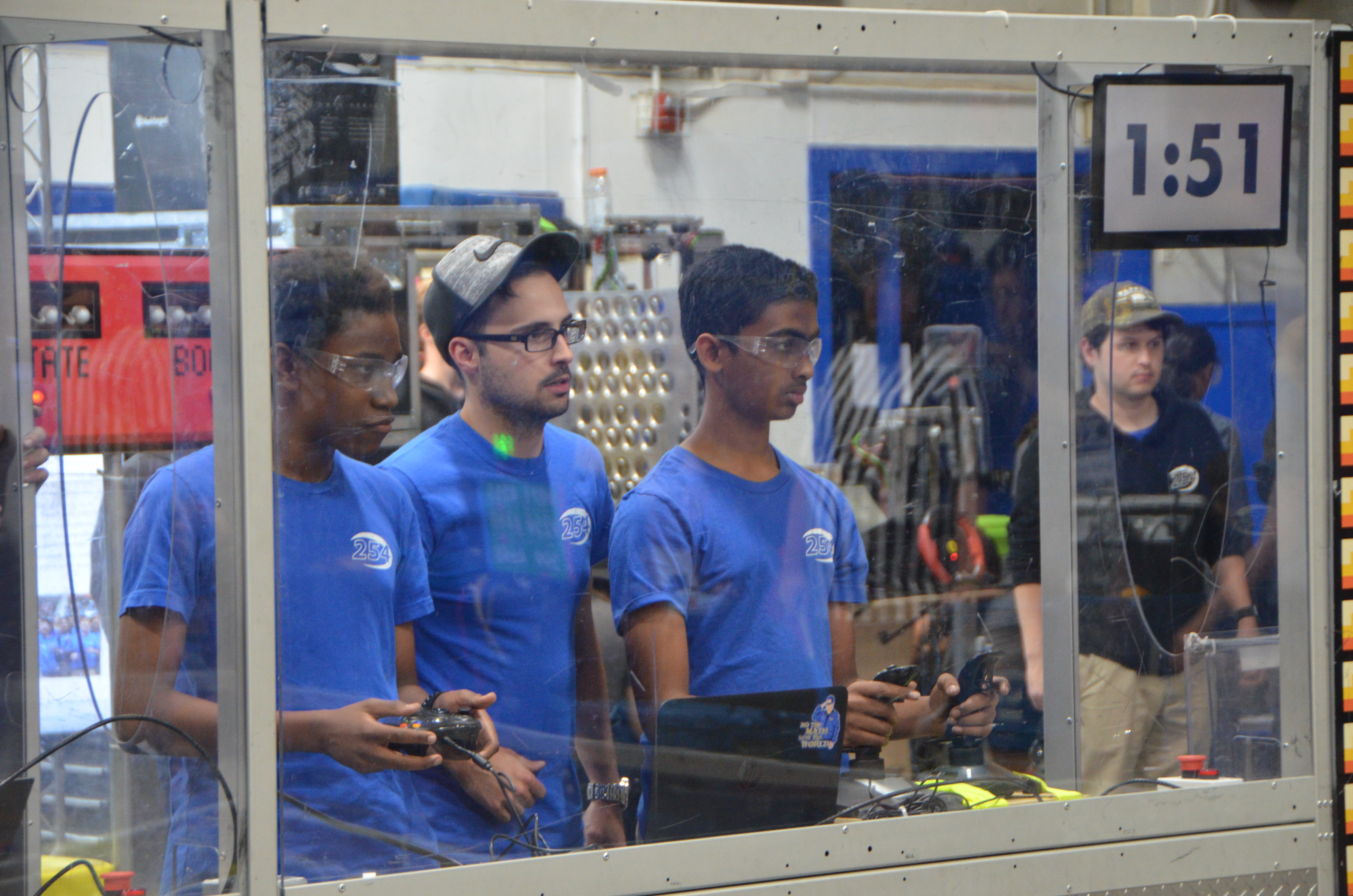
Programming Robot Drive Team Members, Abhinav Nallapa and Dylan Shumba, are seen in action
Robot Performance
Competition Robot Strategy
During qualification matches, we aimed to earn all 4 ranking points. In order to to reach this goal, we had to run our switch autonomous program. We also fought to achieve scale dominance as early as possible during the match to allow for time to shore up our own switch/exchange, attack the opposing alliance’s switch, and hang at the end of the match. We generally went for the scale first and peeled off to either our own switch or the opposing alliance’s switch whenever needed.
During alliance selection, we partnered with Team 1323 Madtown Robotics, their offseason robot (9323), and our own programming robot (9254). During the elimination matches, we worked with Team 1323 and ran our dual autonomous program to gain dominance over the scale, while ensuring ownership of our switch as well. Lockdown and 1323’s competition robot focused on scale ownership, and 1323’s competition robot would fall back for defense whenever necessary. When we had a headstart on the scale, Lockdown would attack the opponent switch, as seen during quarterfinals and semifinals. 1323’s competition robot hung at the end of the match, but we did not pursue a buddy climb since the other two robots were unable to climb onto our forks.
Programming Robot Strategy
During the qualification matches, our programming robot played a supportive role and generally tried to get a few cubes scored in its switch, scale, and exchange. However, during the elimination matches, our programming robot functioned as a switch/exchange robot to ensure that we had enough cubes to use the levitate powerup. We also chose to defend robots from the opposing alliance when given the opportunity.
Summer Project Robot Strategy
During the qualifications matches, our summer project robot functioned as a switch/exchange robot to defend our own switch and make sure there were cubes in our vault. Sometimes, we would also attack our opponent’s switch. Unfortunately, our swerve robot was not chosen during the elimination period.
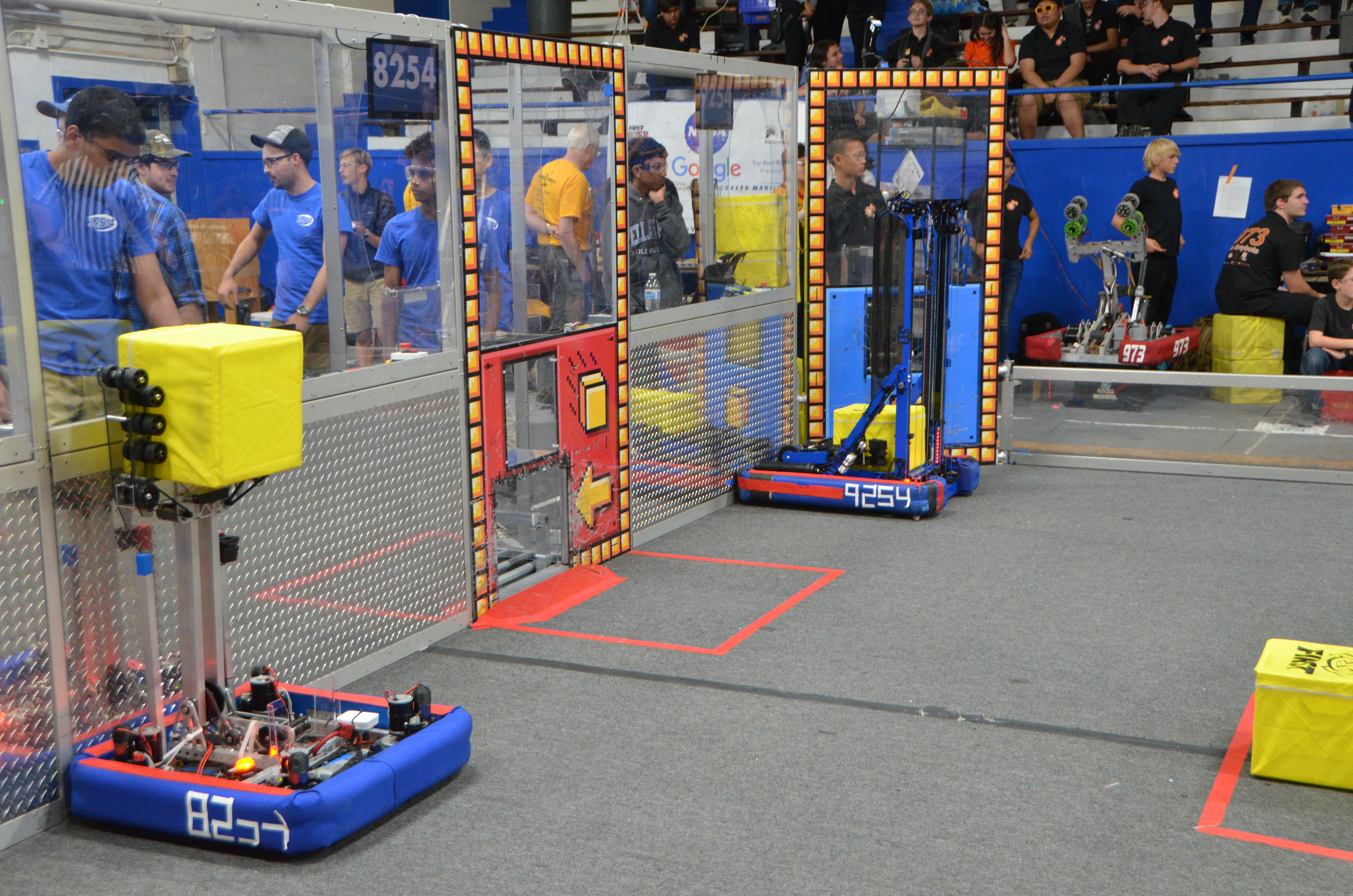
Lockdown and our Summer Project Robot in position before a qualification match
A Special Thanks
Since this was Team 254’s third time attending Madtown Throwdown, we would like to say thank you to Team 1323 (Madtown Robotics) for hosting the tournament and making us feel welcome!

Some new members on Team 254 celebrate the team’s victory
Discovery Day 2018
Event Summary
On November 3rd, Team 254 appeared at the Bay Area Science Festival Discovery Day in AT&T Park to demonstrate our 2018 season robot Lockdown. We talked about our 2018 season, what we do as a robotics team, and how others can get involved in robotics. We collaborated with Teams 1868 (Space Cookies), 2643 (Dark Matter), 4159 (Cardinalbotics), and 5026 (Iron Panther Robotics) to demonstrate to people what robotics and FIRST have allowed us to accomplish as young high school students. This event allowed us to share our knowledge and experiences with the surrounding community.
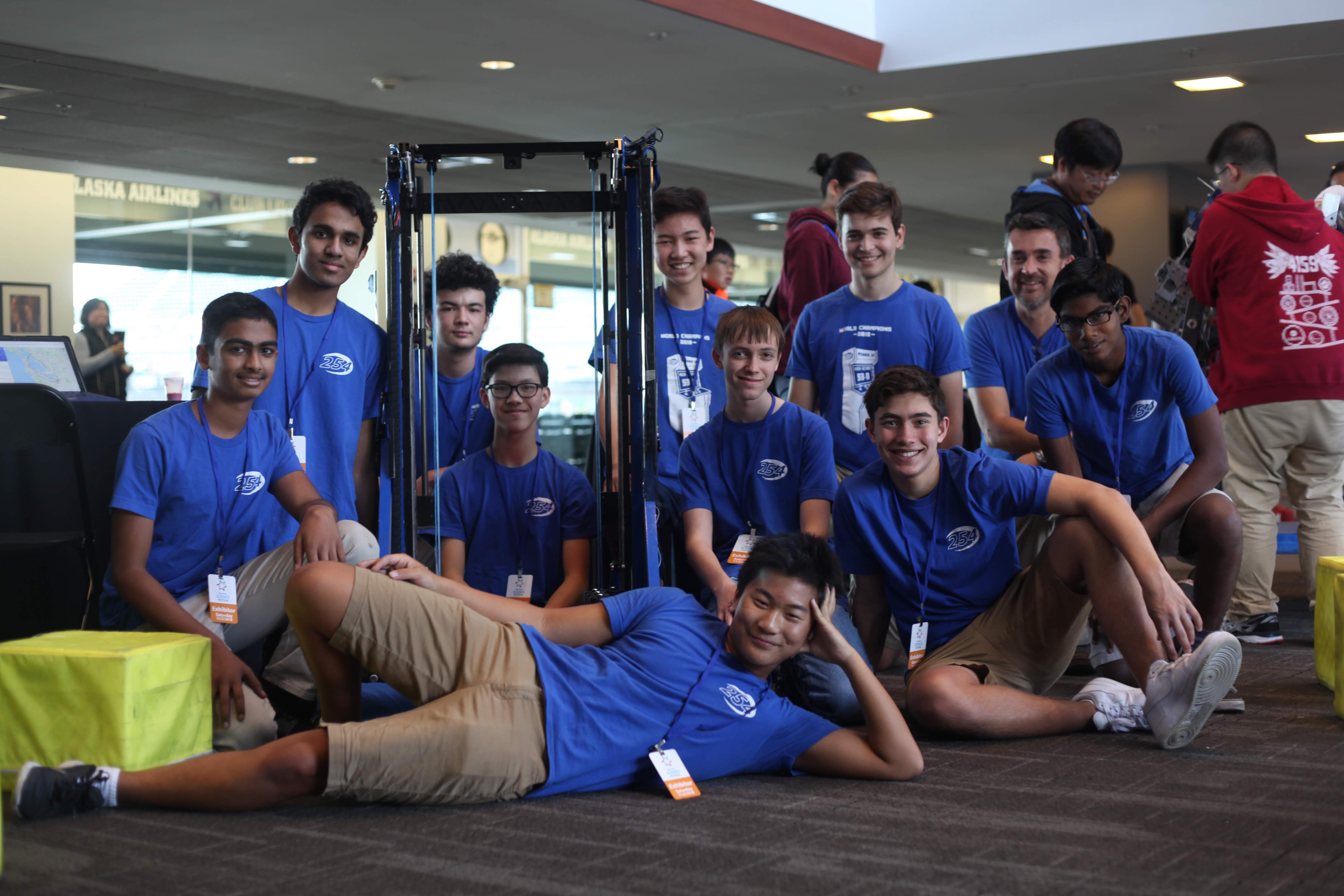
254 Members and alumni, Themis Hadjioannou, pose for a team picture
Our Experiences
Our experience at Discovery Day not only spread awareness for STEM within our community, but also made an impact on our team. Outreach leader, Abhinav Nallapa stated, “I loved seeing the smiles and the cheers from the kids watching when they saw our robot lifting up power cubes 7 feet into the air.” Our team allowed visitors to touch our robot and look at it up close, while also answering any of their questions about our robot. In general, people were astonished to see the speed of our robot and how tall it could expand, and a several people asked how they could get involved with what FIRST has to offer. Overall, Discovery Day was an outstanding outreach event and we wish to continue making such a profound impact in our community!
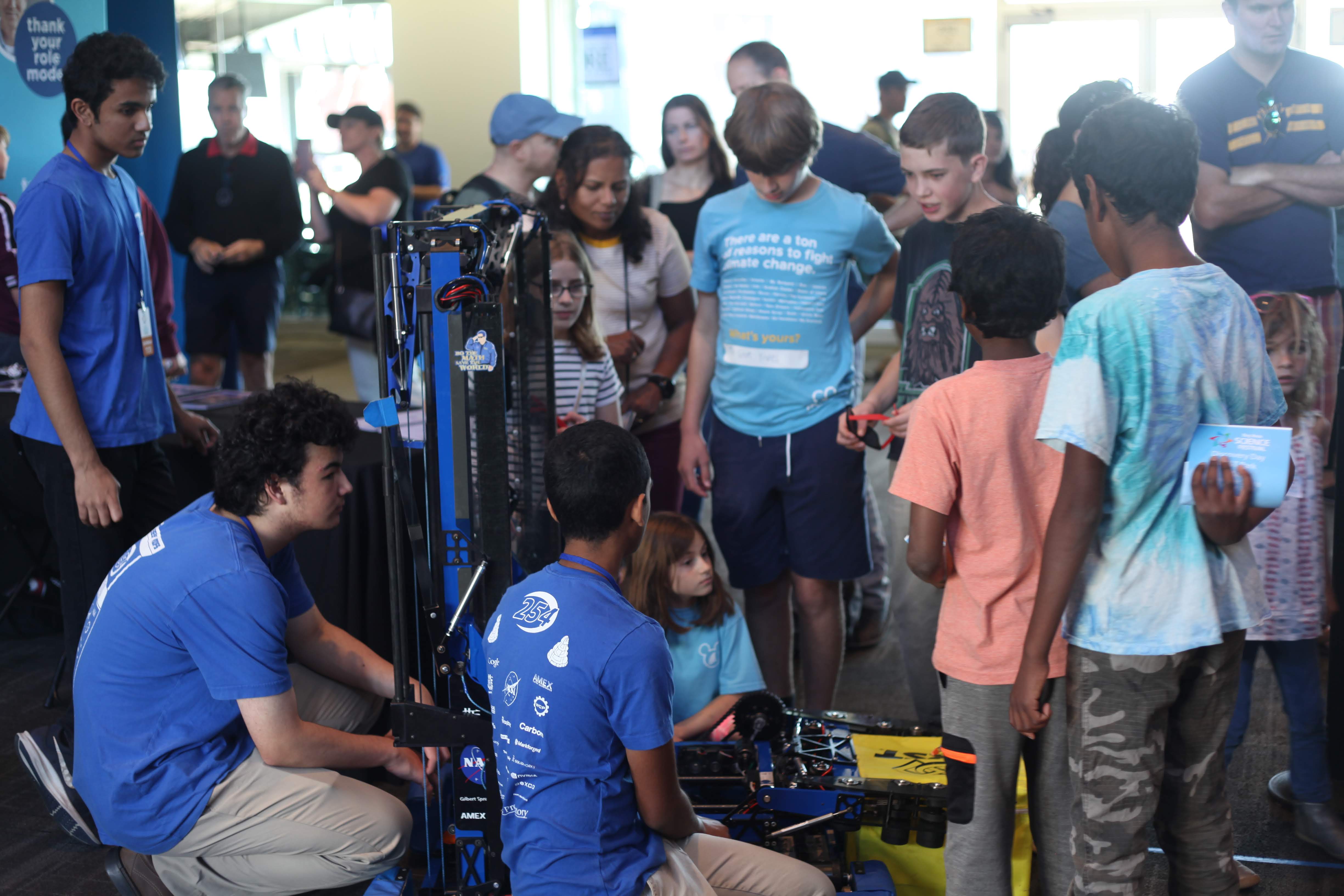
Team 254 Outreach Director, Abhinav Nallapa, shows the capabilities of Lockdown to interested visitors
Capital City Classic 2018
A Brief Sumary
As part of an eventful weekend, we attended Capital City Classic, an annually hosted offseason tournament hosted by Team 1678 (Citrus Circuits), in Davis, CA. We had a great time jumping back into action with our robot, Lockdown, before the start of the 2019 FRC Season. Alongside, FRC Team 1323 MadTown Robotics, FRC Team 199 Deep Blue, and FRC Team 3859 Wolfpack Robotics, we were able to win the tournament!

Team 254 Members pose with their alliance partners and fellow champions
Event Highlights
General Summary

Team 254 hangs at the end of a quarterfinals match
Overall, Capital City Classic was a great event for our team. After ending with a record of 15-0, our team members were excited throughout the tournament. With an 8 person pit crew and drive team, we were very effective and made sure the rest of our team members were at home working on our summer project robot to prepare to Madtown in 2 weeks.
Robot Performance
In general, we prioritized ranking points throughout the event. Since many robots at the event did not focus on the scale, we adopted a strategy of aggressive offense where we would score on our opponent’s switch. We would also focus on maintaining ownership of the scale and climbing at the end of the match for the extra ranking point. We ended up seeding first with 31 ranking points over 9 matches.
During Alliance Selection, we chose to form an alliance with Team 1323 since they had a great scale robot that could really help us establish a lead during auton. To accompany two strong scale robots we looked for two robots skilled in locking down the switches and exchange, like Team 199 and Team 3859.
During elims, we worked with Team 1323 to lock down ownership of the scale during auton. If necessary, Team 1323 would focus on offense towards the opposing alliance’s switch. During finals, we did have some scale competition with team Team 1678 and Team 1425 on the opposing alliance. Thus, we played more conservatively and made sure we had a solid buffer on the scale before rotating to other tasks. We would also like to recognize the opposing alliance of Team 1678 (Citrus Circuits), Team 1425 (Error Code Xero), Team 5458 (Digital Minds), and Team 4171 (BayBots).
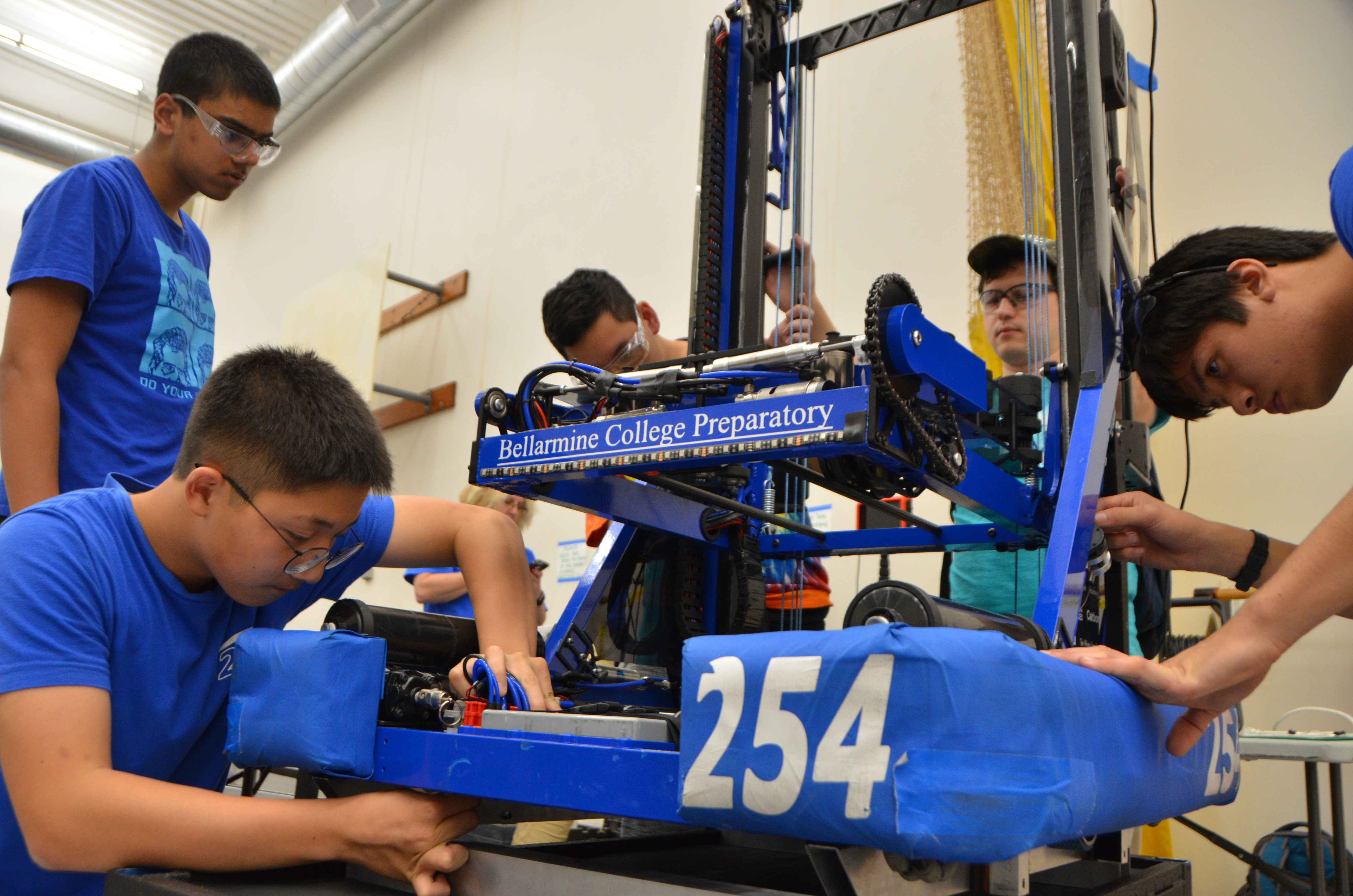
Members of the Team 254 Pit Crew repair Lockdown before an upcoming Finals Match
A Special Thanks
Since this was Team 254’s first time at Capital City Classic, we would like to say thank you to Team 1678 (Citrus Circuits) for hosting the tournament and making us feel welcome.
Chezy Champs 2018
A Brief Sumary
As part of an eventful weekend, we hosted Chezy Champs, our annually hosted offseason FRC tournament at Bellarmine College Preparatory, in our hometown of San Jose, CA. We had a great time jumping back into action with our robot, Lockdown, before the start of the 2019 FRC Season. Alongside, FRC Team 1678 Team Citrus Circuits, FRC Team 649 M-SET Fish, and FRC Team 2557 SOTAbots, we were able to win the tournament!
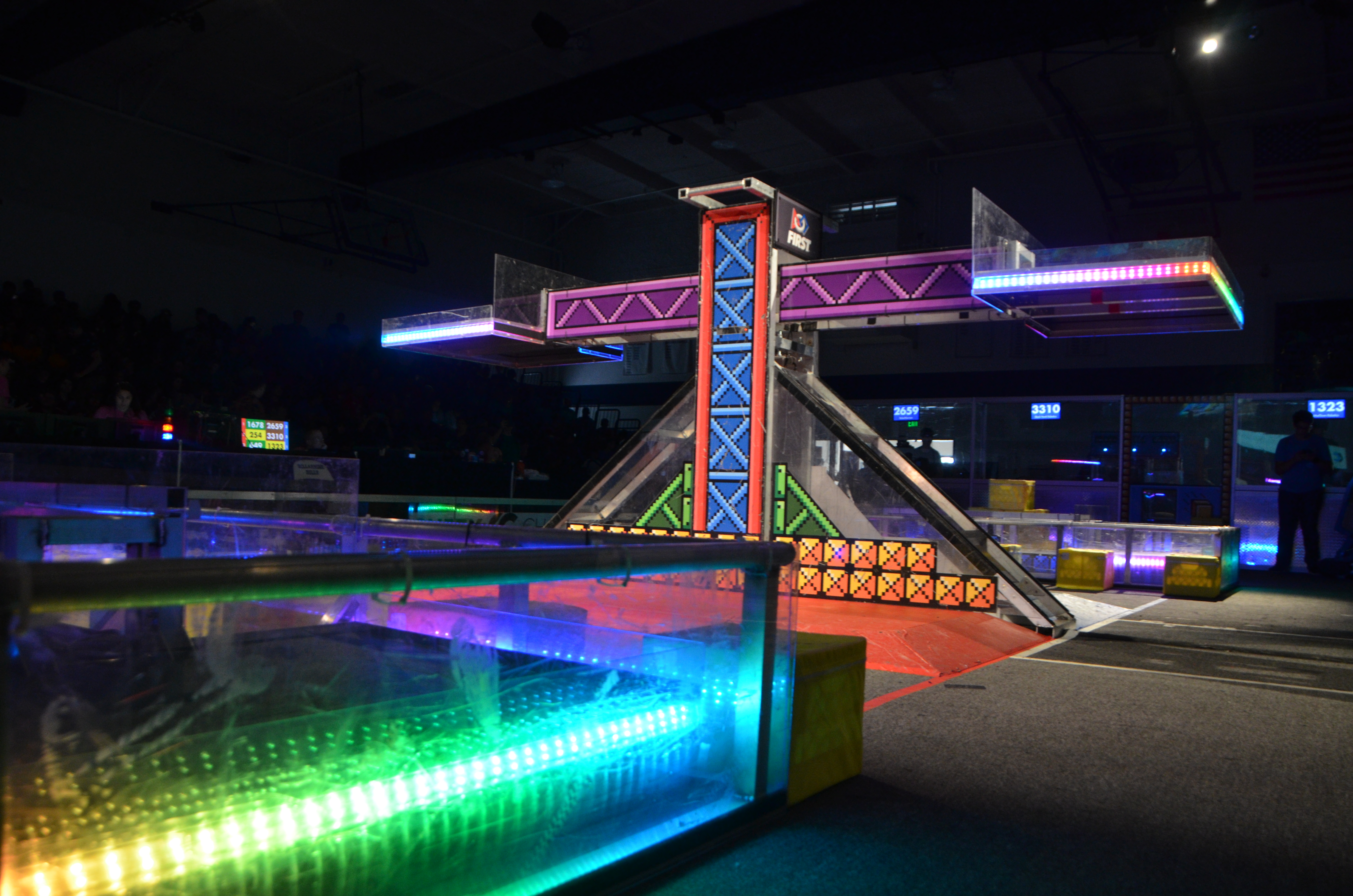
Robot Performance
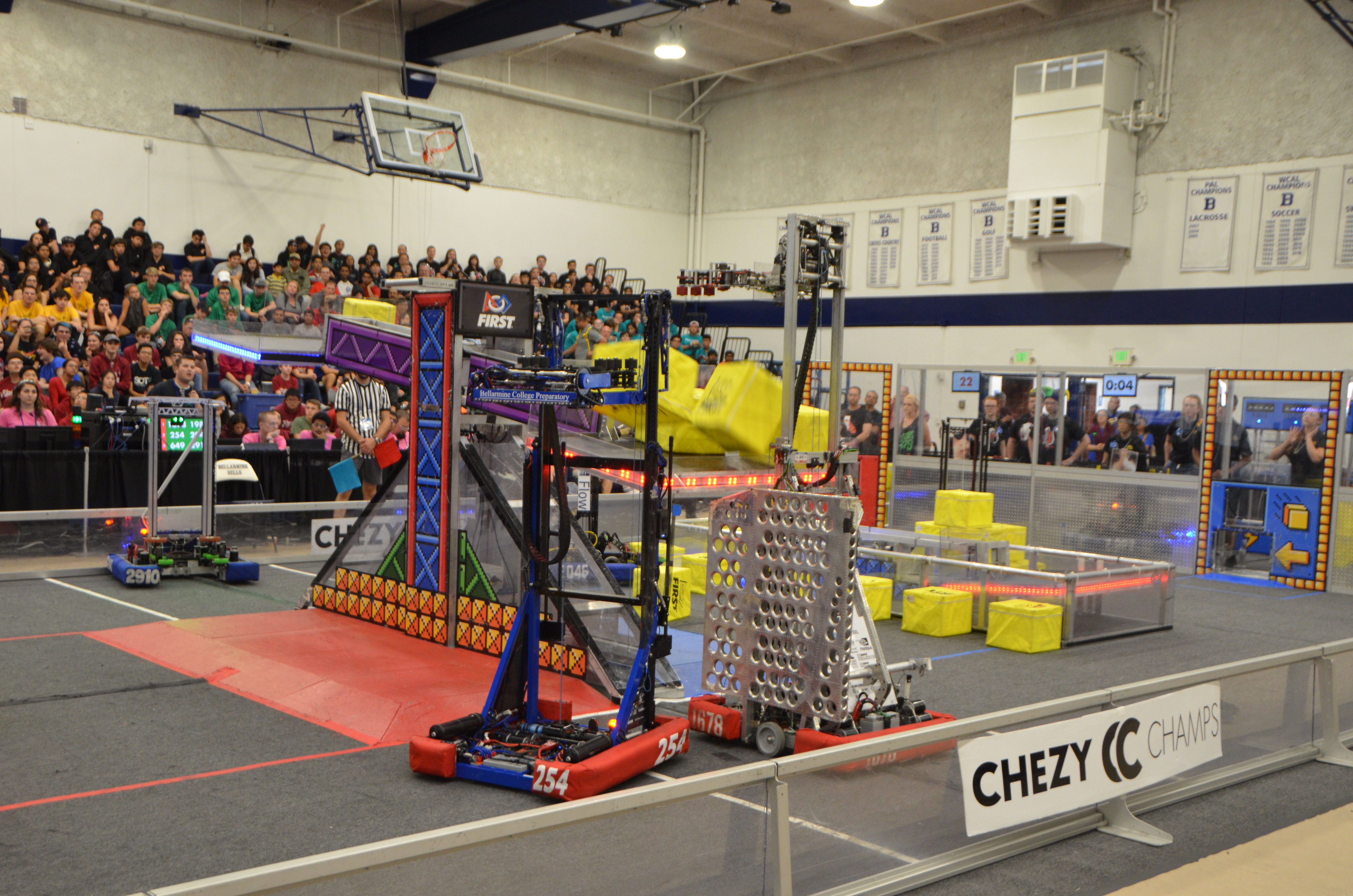
Lockdown faces some competition in scoring on the scale
Throughout the qualification matches, we had a very loose strategy. We had a new drive team for this year, so we were very relaxed in our approach to the game and generally focused scoring on the scale. Though we lost a few quals matches and did not seed first, we were chosen to join an alliance with generous Team 1678 (Citrus Circuits). During elims, we had scale-heavy matches and switch-heavy matches. During our scale-heavy matches, we worked with Team 1678 to score on the scale until we had a substantial lead. After focusing on the scale, we would divert our attention to our switch or attack our opponent’s switch of necessary. For finals, our objective was to build a solid lead after auto and then maintain ownership of the scale. We ensured that we completed this objective by placing all of the switch fence cubes on the scale. Whenever we had a lead on the scale, 1678 would maintain it and we would do our best to slow Team 1323 down by attacking opponent switch and disrupting their pyramid-scale cycles. We would like to congratulate the winning alliance of Team 3310 (Black Hawk Robotics), Team 1323 (MadTown Robotics), Team 2659 (RoboWarriors), and Team 1538 (The Holy Cows).

Team 254 Members show Lockdown to a visitor
A Special Thanks
Chezy Champs was very special this year due to the efforts of so many people and organizations. Team 254 would like to thank our friends from RoboSports Network (RSN) for providing our audience with such a great analysis of each match and team at the tournament. We would also like to thank all the volunteers, who helped make Chezy Champs possible. It was truly an incredible experience to host an offseason tournament attended by so many talented teams, even those who chose to attend from out of state, and to make new friends and catch up with old ones too!
2018 World Champions!
A Brief Summary
As part of an eventful week, we attended the 2018 FIRST World Championship in Houston, Texas from April 18th to April 21st. Assigned to the Hopper Division, we won the Division Championship Award and the Autonomous Award sponsored by Ford, for our 4 cube scale autonomous program and scale detection software. After becoming the Hopper Division Champions, we executed a well-planned strategy alongside FRC Team 148 Robowranglers, FRC Team 2976 Spartabots, and FRC Team 3075 Ha-Dream Team, allowing us to win our 4th world championship and finish with an undefeated season!
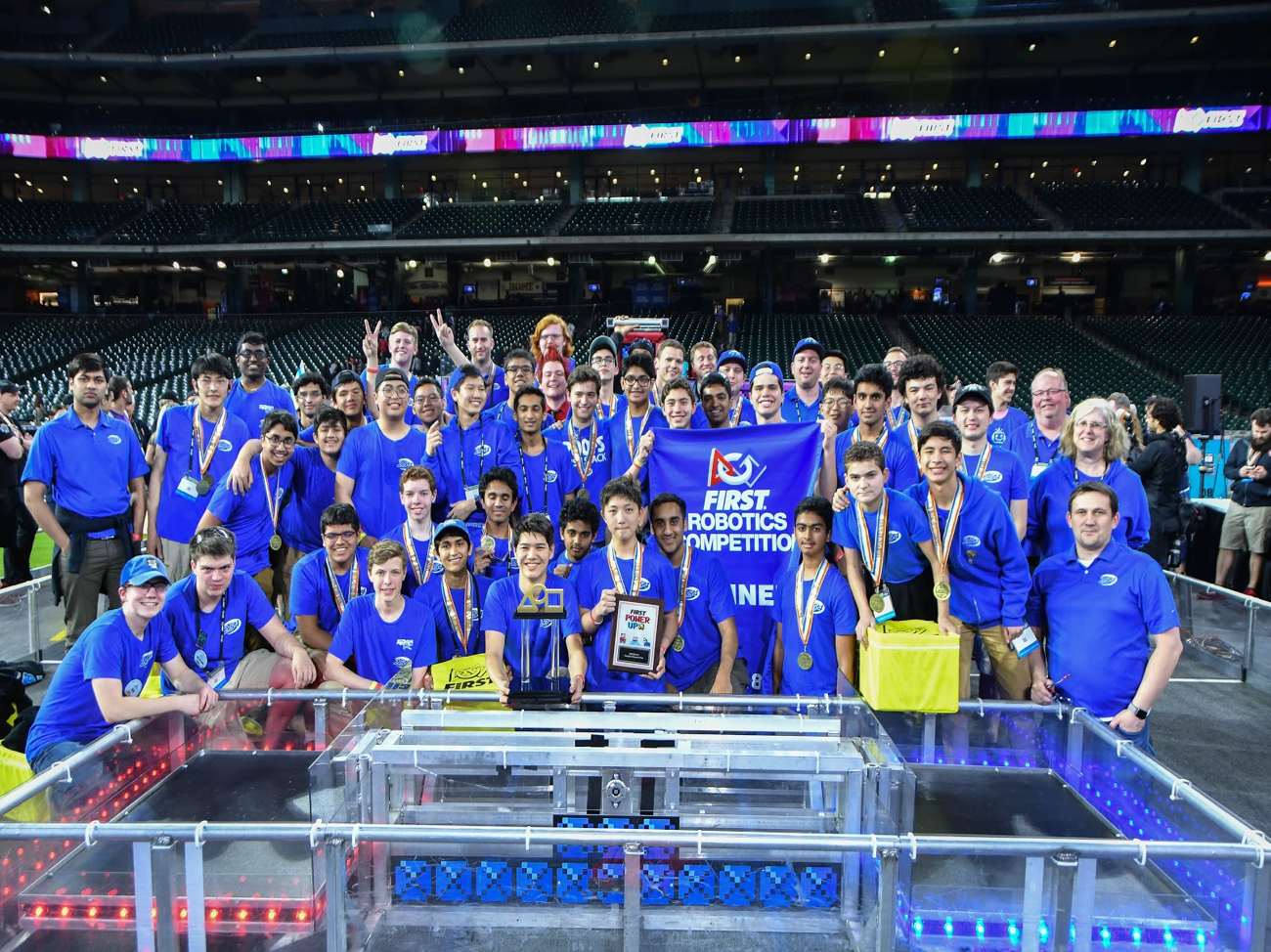
Team 254 poses for a picture after winning at the 2018 FIRST Championship in Minute Maid Park
Robot Performance
Qualification Matches (Hopper Division)
Throughout our qualification matches, we wanted to make sure that we secured 4 ranking points during every match, while still gaining control of our scale for as long as possible. In order to do this, we ran our scale autonomous program, which placed 3-4 cubes on our alliance’s scale or, when we were not confident with our alliance partners’ ability to place cubes on the switch, we executed our autonomous program which placed cubes on the switch and scale.
Alliance Selection
Going into the elimination period in the Hopper Division, we chose to form an alliance with FRC Team 148 Robowranglers, FRC Team 2976 Spartabots, and FRC Team 3075 Ha-Dream Team.
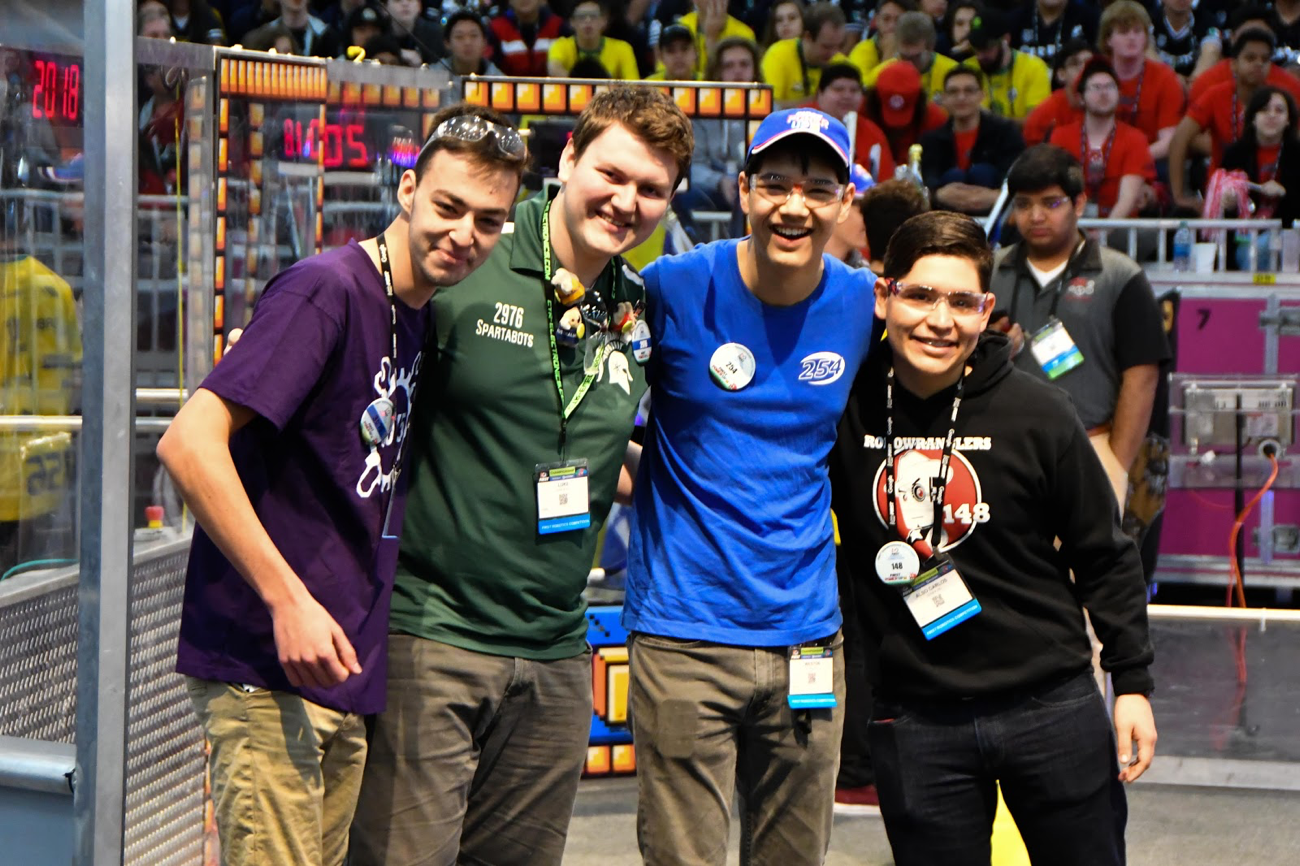
Team 254 representative, Weston White, poses with our chosen alliance partners
Elimination Matches (Hopper Division)
During the elimination matches in the Hopper Division, we maintained our undefeated record for the entire tournament. From a strategic perspective, we aimed to always have possession of the scale and our own switch while also placing cubes on our opponent’s switch. This strategy allowed us to gain a significant lead during each match and stopped the opposing alliance from being able to score from their own switch. We would also like to thank Team 3075 Ha-Dream Team for helping our alliance during Finals Match 2 in the Hopper Division, while Team 2976’s robot was undergoing some repairs. Through the efforts of our alliance partners, we were able to win the Hopper Division. We also won the Autonomous Award sponsored by Ford, for our unique 4 cube scale autonomous program and scale detection software!
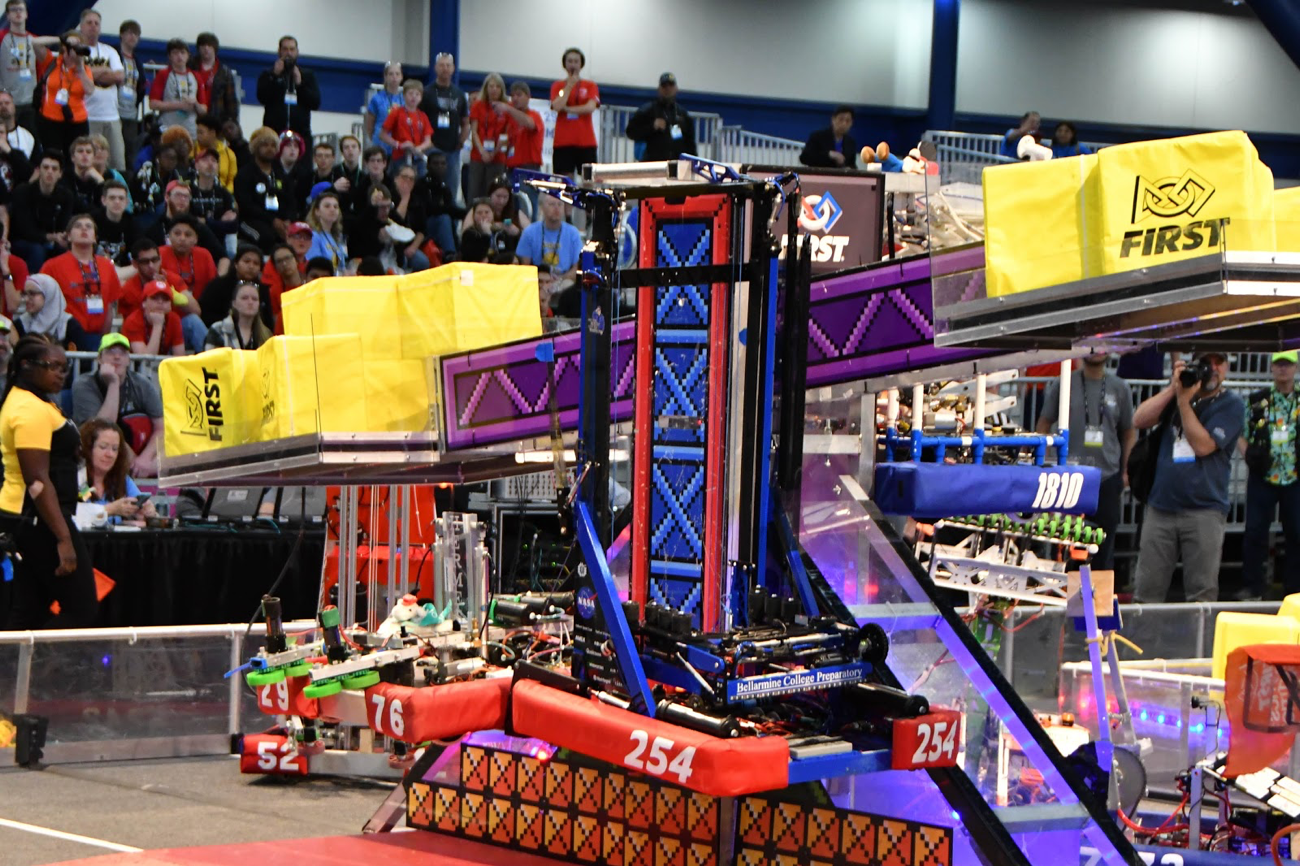
Lockdown hangs with alliance partner, Team 2976, at the end of a match
On the Einstein Field
We generally maintained a similar strategy during the Einstein matches as in the Hopper Division elimination round, by placing cubes on both switches and keeping possession of the scale. Team 2976 Spartabots played awesome defense on the portals to slow down the opposing alliance’s cube flow after they used all the cubes from their switch fence. Team 148 Robowranglers attacked the opposing alliance’s switch to force them to cover their switch before attacking our switch or the scale. Our drive team chose not to prioritize powerups, by placing only 3-4 cubes in our exchange for the levitate or boost powerup. With this strategy, we placed first during the round robin matches, allowing us to move on to Finals, with the Carver Division winners. We would like to shout out FRC Team 2910 Jack In The Bot, FRC Team 4911 Cyberknights, FRC Team 4499 The Highlanders, and FRC Team 5006 Apophis, the Carver Division winners, for executing a great strategy while playing against us on the Einstein Field.
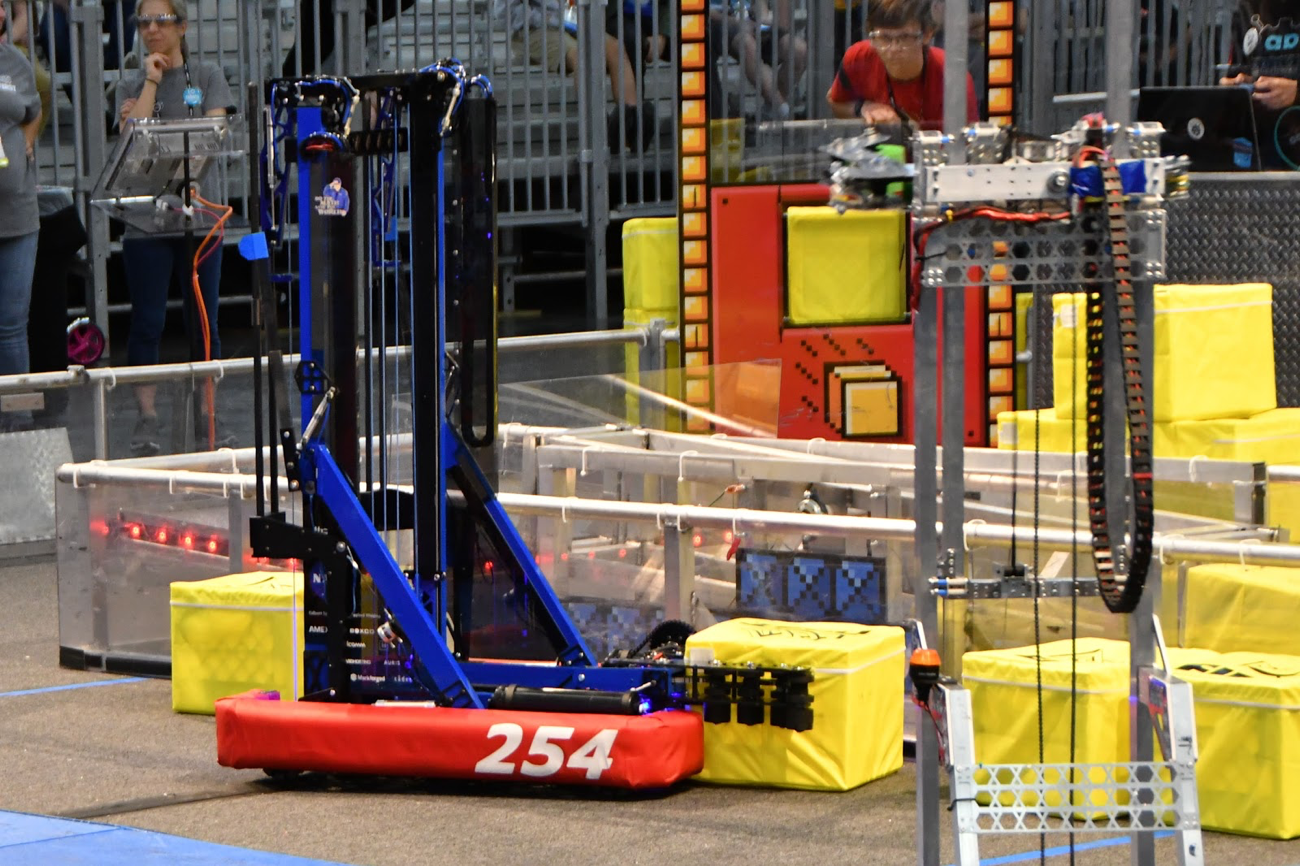
Lockdown works to place a cube on the opposing alliance’s switch
A Special Thanks
At the 2018 FIRST World Championship in Houston, we would not have been able to be so successful without the amazing teams that we were able to work with during our matches. Also a special shout out to our pit crew and drive team for properly maintaining our robot during the tournament. We would also like to highlight the efforts of our alliance readiness crew to keep our alliance partners ready throughout the tournament. Team 254 would also like to thank all the volunteers and judges that made this tournament an exciting experience, and all of our mentors, teachers, and parents who supported us and helped us succeed in this tournament.
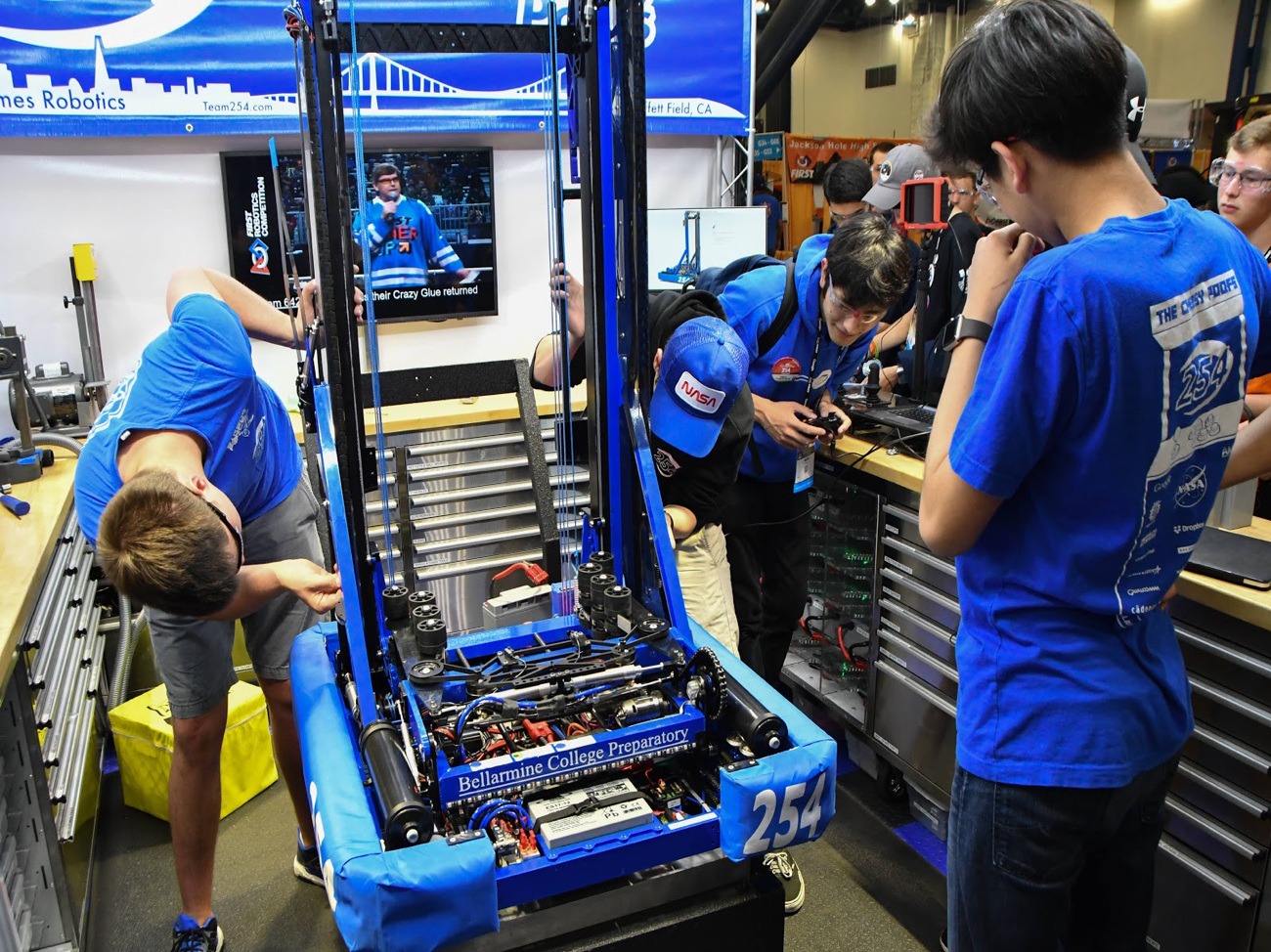
Members of the Team 254 Pit Crew repair Lockdown before an upcoming match

Members of the Team 254, 148, 2976, and 3075 drive team strategize before an upcoming match
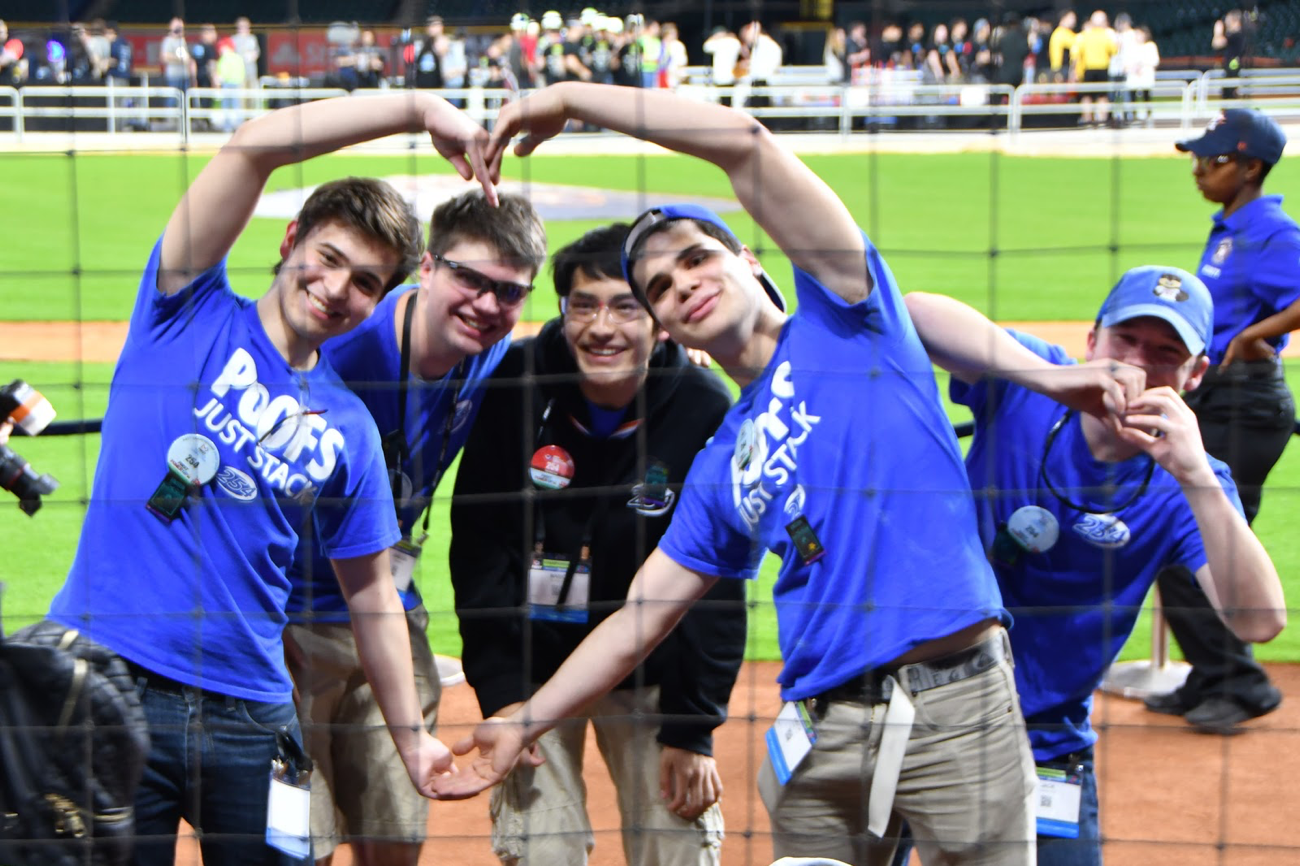
Our drive team poses for a picture on the Einstein Field

Members of the Team 254 Alliance Readiness Crew assist Team 6014
2018 Silicon Valley Regional Champions!
A Brief Summary
As part of an eventful weekend, we attended the the 20th Silicon Valley Regional, in San Jose, CA. We had a great time at our second tournament of the FIRST Power Up Season with our robot, Lockdown. We won the Innovation In Control Award sponsored by Rockwell Automation for our autonomous code. Congratulations to one of our mentors, Nick Hammes, for winning the Volunteer of the Year award, for his hard work emceeing and in planning this wonderful event! Alongside FRC Team 973 The Greybots and FRC Team 2367 Lancer Robotics, we were able to win the tournament, earning our 50th Blue Banner!
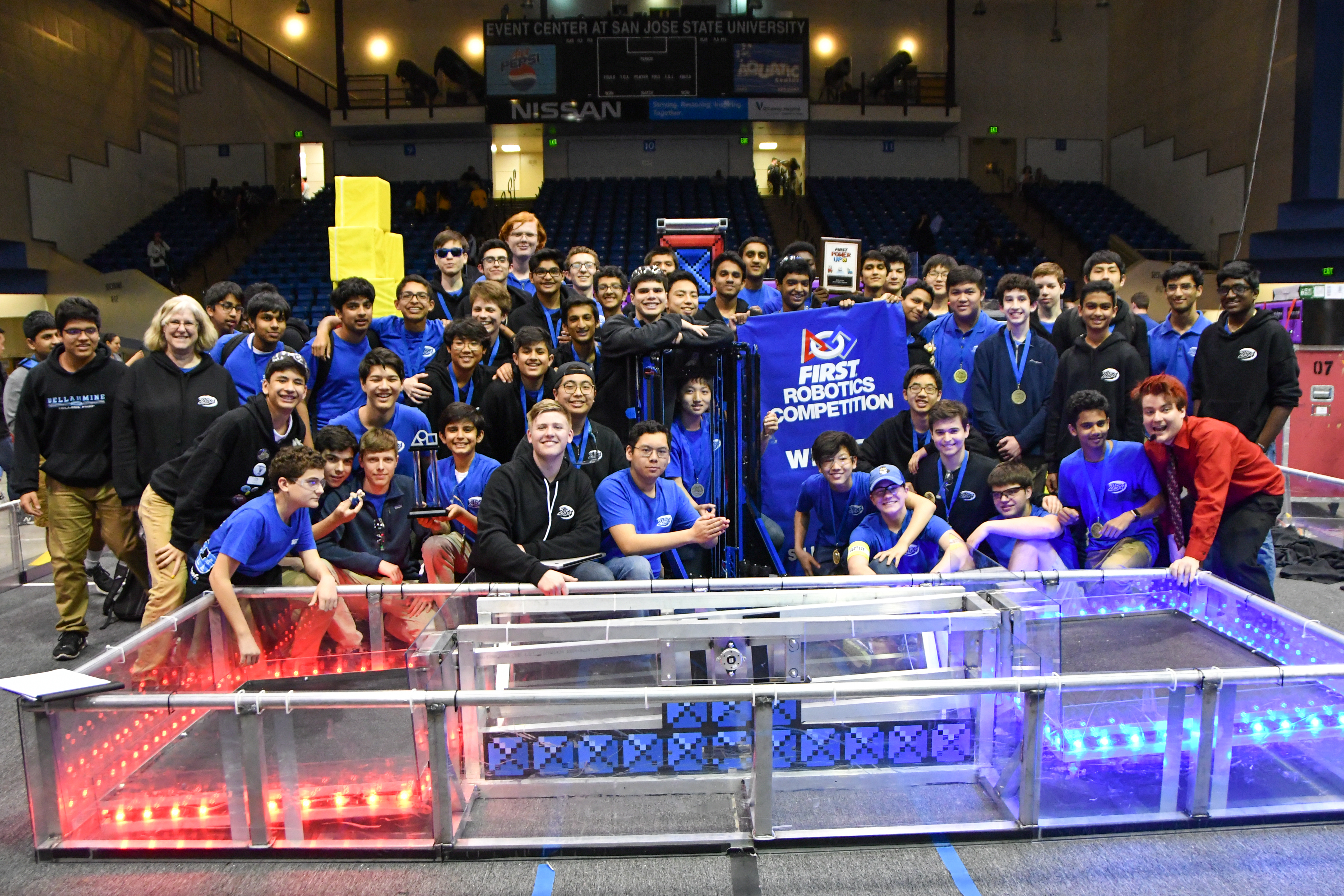
Team 254 poses for a picture with Lockdown after winning at the 2018 Silicon Valley Regional
Robot Performance
Qualification Matches
Throughout our qualification matches, we executed a variety of autonomous programs to ensure we were prepared for various situations. This allowed us to either place 3 cubes in the switch or place 3 cubes on the scale. When on an alliance with robots that were good at placing cubes on the scale, we had to make sure we maintained ownership of the scale before placing cubes on ours’ or our opponent’s switch. We always tried to position ourselves on the scale platform to have enough time for hanging. During the qualification match period, we gained 4 ranking points in each match.
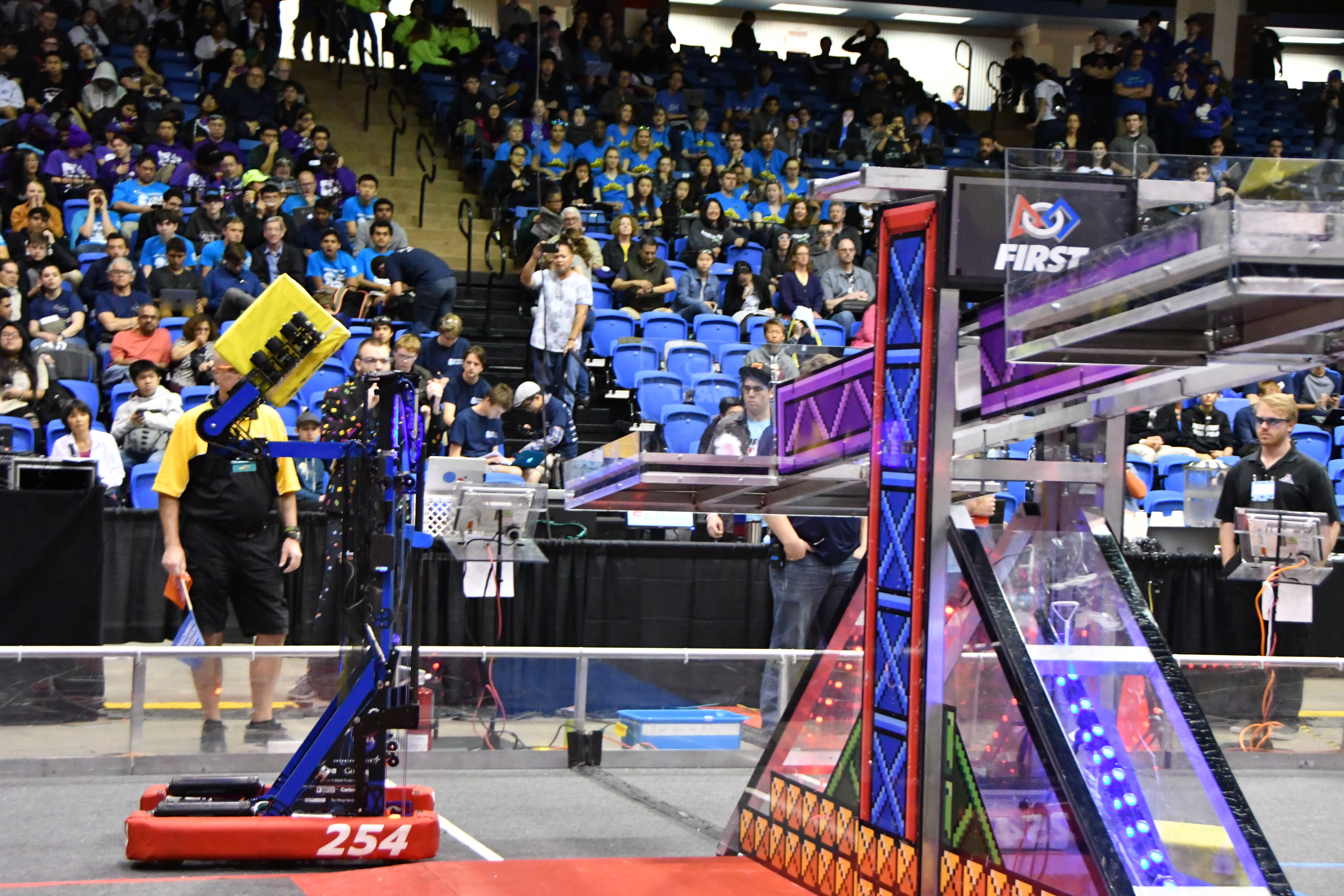
Team 254 places a cube on the scale during the autonomous period
Alliance Selection
Going into the elimination period, we chose to form an alliance with FRC Team 973 The Greybots, FRC Team 2367 Lancer Robotics.

Team 254 representative, Weston White, stands with Team 973 and Team 2367 as they agree to join our alliance
Elimination Matches
By choosing Team 973, a great scale robot, and Team 2367, a great switch and exchange robot, we were able to follow a more flexible strategy. During the elimination matches, Team 973 worked with us to lock down the scale, while Team 2367 focused on keeping ownership of our switch and delivering cubes to our exchange station. To create a head start on scoring cubes onto the scale, we used our 3 cube scale autonomous program. If our opponents were good scoring on the scale, we joined 973 in maintaining ownership of the scale. When our autonomous program was successful, we worked on maintaining ownership of our opponent’s switch, using cubes from our portal. Team 2367 executed flawless and well-timed defense against the opposing alliance. With an organized strategy and great alliance partners, we remained undefeated for the season, allowing us to become the first-place alliance at the tournament and win our 50th blue banner!
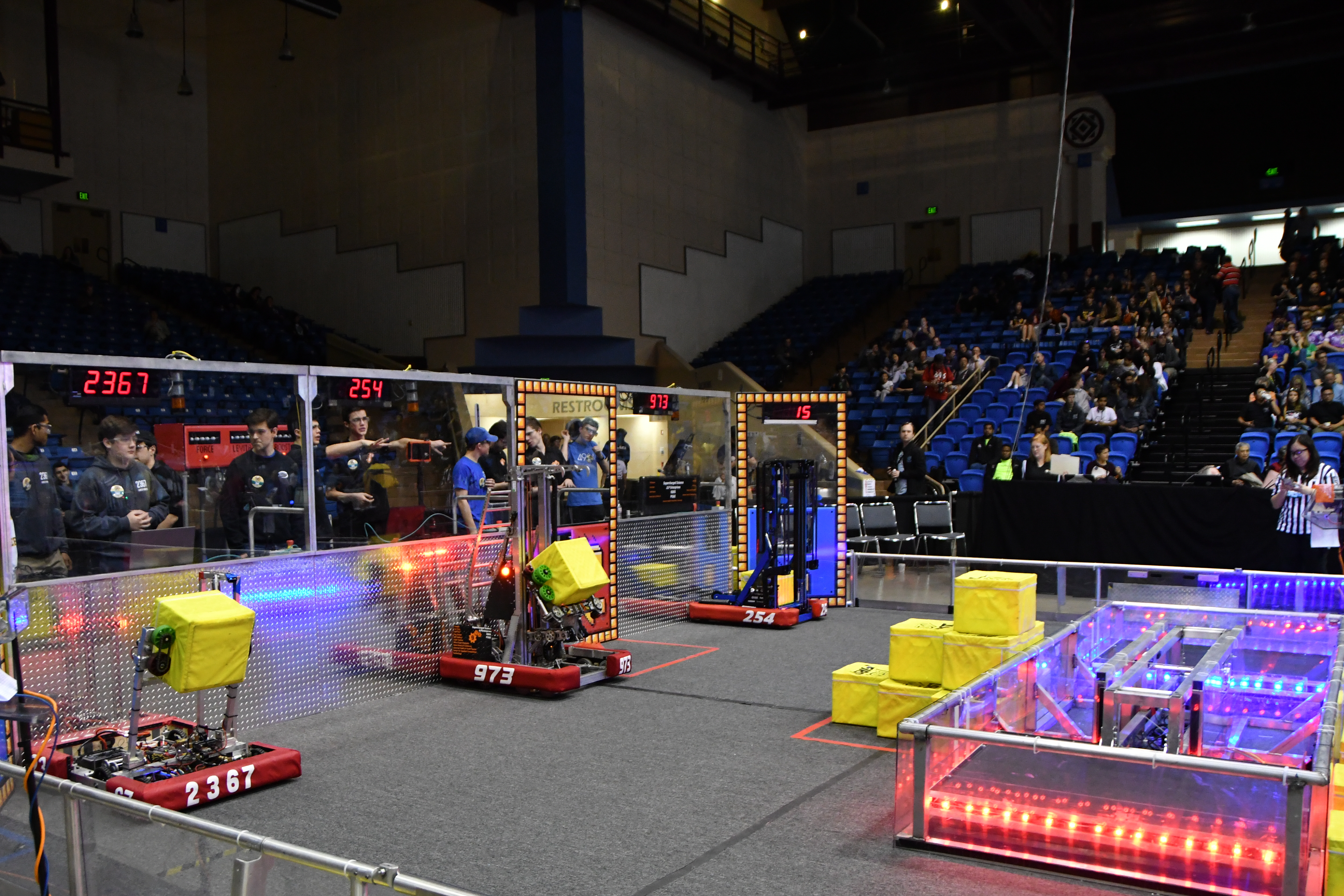
Team 254 and alliance partners Team 973 and Team 2367 stand together during Semifinals Match 1
Helping Other Teams
The Alliance Readiness Crew worked hard throughout the tournament to assist Team 6688 West Valley Middle College Robotics and Team 7317 Crusader Crew. Our crew helped improve the design of Team 6688’s exhaust system, used for delivering cubes to the switch, safely wire their control system, fix their pneumatics so that there were no leaks, and write an auto that could put cubes into the correct side switch. When Team 7317 needed help, our crew worked to create a new and improved intake system to collect and deliver cubes to the exchange. Through this experience, students were able to make friends and get more hands on with designing an actual robot.
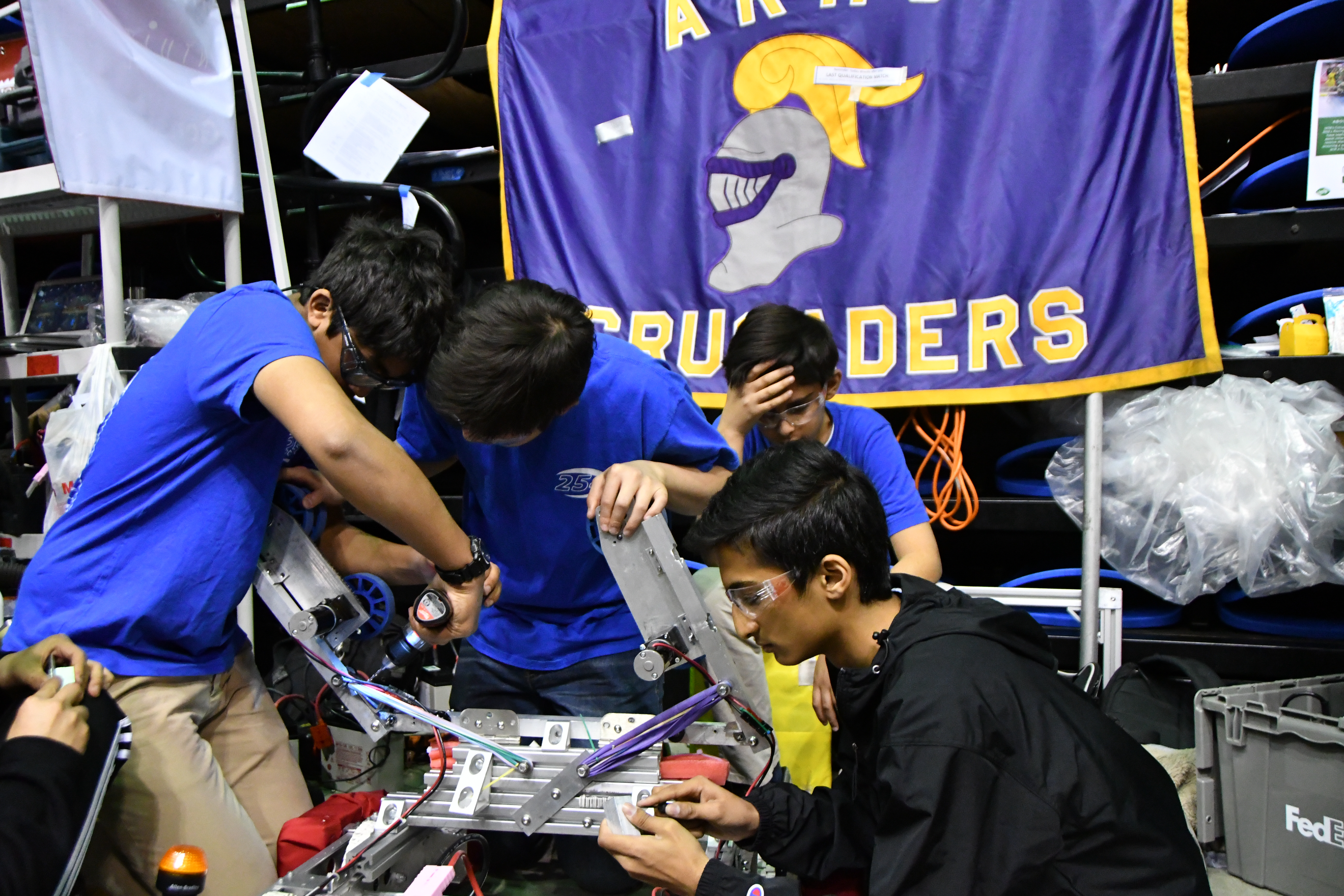
Our alliance readiness crew assists Team 7317 in mounting hardstops for a newly designed intake
A Special Thanks
At the Silicon Valley Regional, we would not have been able to be so successful without the amazing teams that we were able to work with during our qualification and elimination matches. Also a special thanks for our pit crew and drive team for properly maintaining our robot during the tournament. A big thank you to the chairman’s presentation team for handling our team’s Chairman’s Presentation in front of a panel of FIRST Judges. Team 254 would also like to thank all the volunteers and judges that made this tournament an exciting experience, and all of our mentors, teachers, and parents who helped us succeed in this regional.
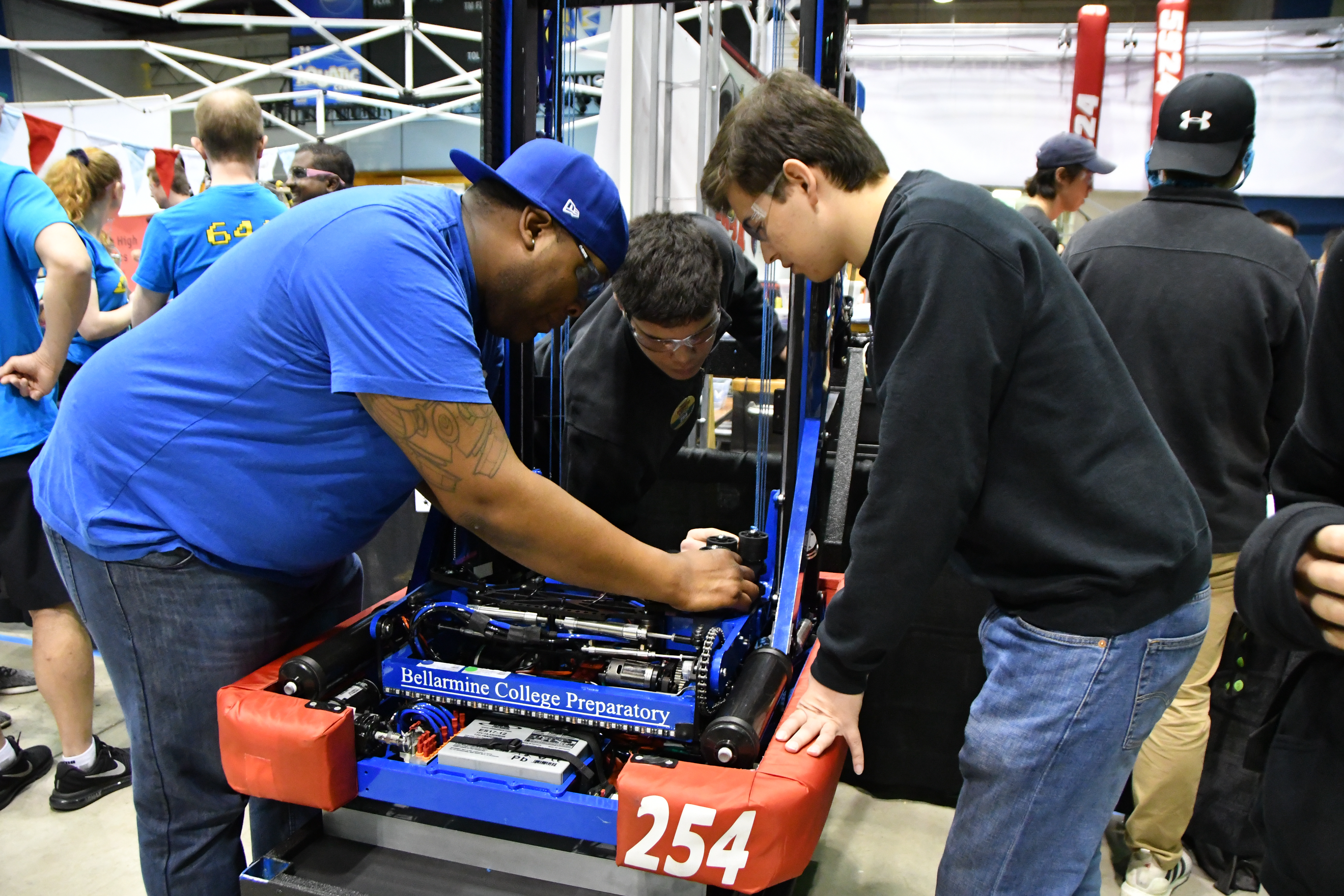
Members of the Team 254 Drive Team repair Lockdown with a mentor before an upcoming match
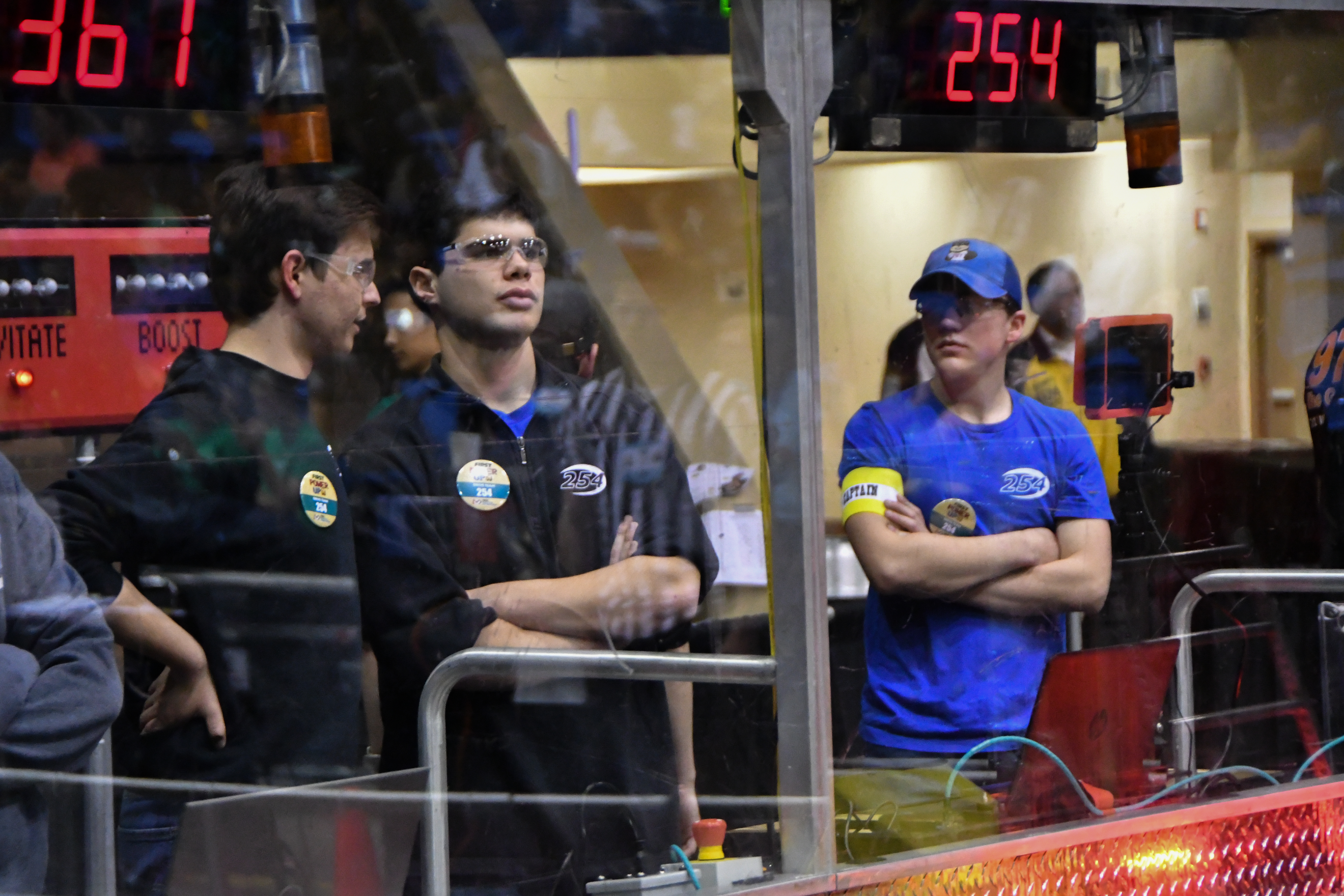
Our drive team discusses a possible strategy before a tense eliminations match
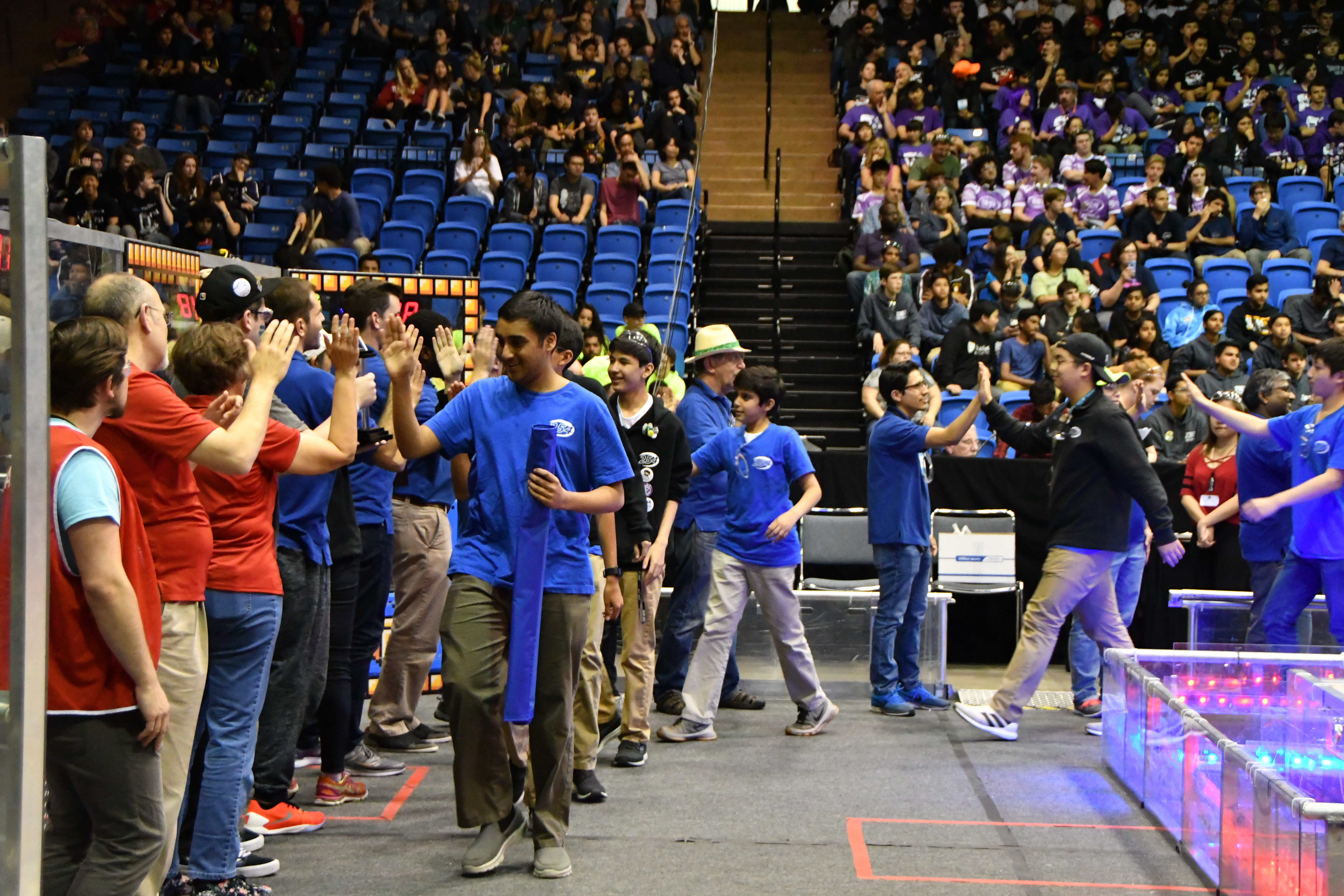
Excited Team 254 members receive the team’s 50th blue banner
2018 Arizona North Regional Champions!
A Brief Summary
As part of an eventful weekend, we attended the Arizona North Regional, for the very first time, in Flagstaff, AZ. We had a great time starting off the FIRST Power Up Season with our robot, Lockdown. Alongside FRC Team 842 Falcon Robotics and FRC Team 2403 Plasma Robotics, we were able to win the tournament!
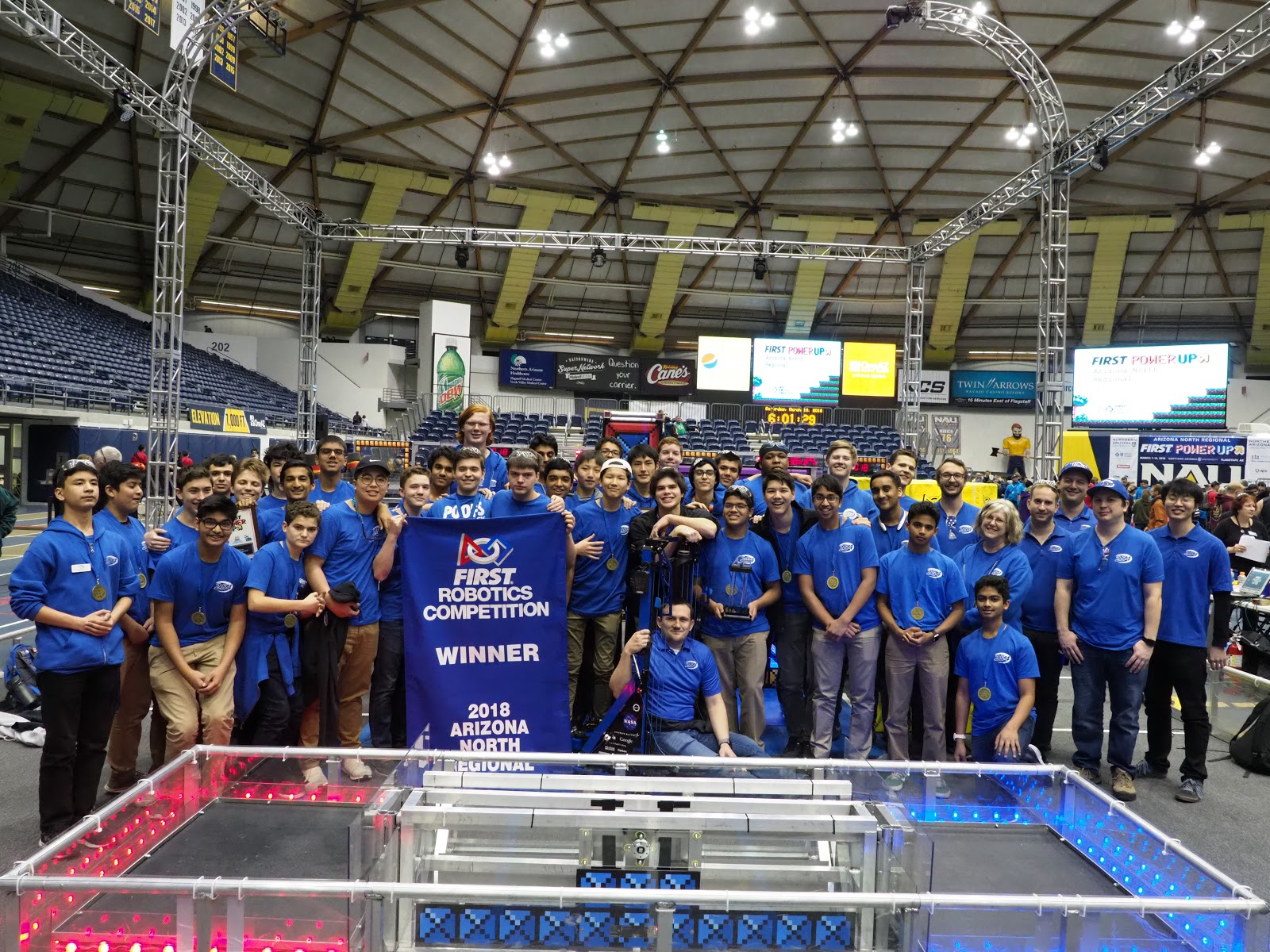
Team 254 poses for a picture with Lockdown after winning at the 2018 Arizona North Regional
Robot Performance
Qualification Matches
Throughout our qualification matches, we used an experimental strategy by testing out which of our autonomous programs worked best during a match. From this experimentation, we concluded that it would be best to use our autonomous program, which scored 2-3 cubes on the scale, to establish an early lead in a match. This autonomous program helped us gain ownership of the scale, but we had to focus more on maintaining ownership of the switches rather than the scale. Whenever we had alliance partners who could not secure the switch consistently, we ran our autonomous program for the switch to help our alliance partners before the tele-op period. During every match, we hung with our partners and used the levitate power up for an extra ranking point. By the end of the qualification match period, we were seeded first and had a undefeated record.
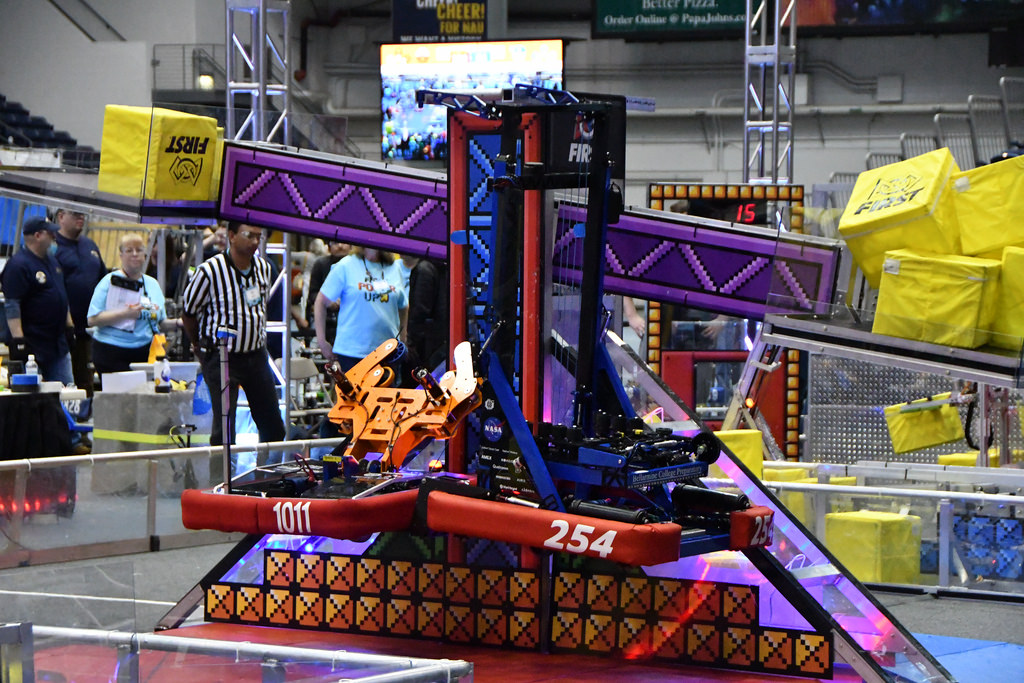
Team 254 and alliance partner Team 1011 work together to hang during Qualification Match 86
Alliance Selection
Going into the elimination period, we chose to form an alliance with FRC Team 842 Falcon Robotics, FRC Team 2403 Plasma Robotics.
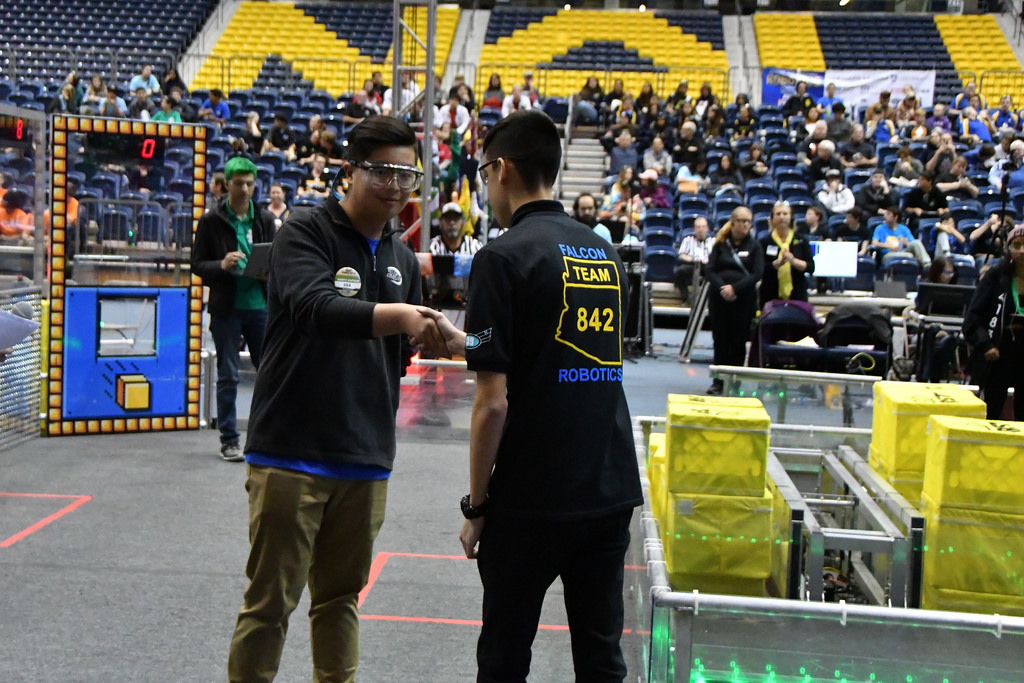
Team 254 representative, Brandon Chuang, greets Team 842 as they agree to join our alliance
Elimination Matches
During the elimination matches, we maintained our undefeated record for the entire tournament. Our autonomous program and Team 842’s robot, worked to score on the scale during each match. This allowed us to score on switches, while Team 842 covered the scale during the tele-op period. We also focused on stopping our opponents from gaining ownership of their own switch. If we had spare time during a match, we passed cubes through the exchange. Team 2403’s robot worked to gain ownership of our own switch and we also helped with scoring cubes in our switch. During finals, Team 2403 focused on switch, exchange, and defense against opponents who tried to take ownership of our switch. With an organized strategy and great alliance partners, we scored an all-time high of 594 points in Finals Match 2, allowing us to become the first-place alliance at the tournament!
Helping Other Teams
The Alliance Readiness Crew worked hard throughout the tournament to assist Team 6585 Hózhóogo Naasháa Doo and Team 6656 Ryu Botics. When Team 6656 needed an intake, our crew searched for the necessary parts and mounted a simple 2-wheel intake onto their robot. In addition, we helped them write an autonomous mode that crossed the auto line consistently. When Team 6585 needed a robot, our crew worked for 3 days to build and wire a drivebase, 2-wheel intake, and a polycarbonate box for collecting cubes from the portal. Through this experience, students were able to make friends and get more hands on with designing an actual robot.
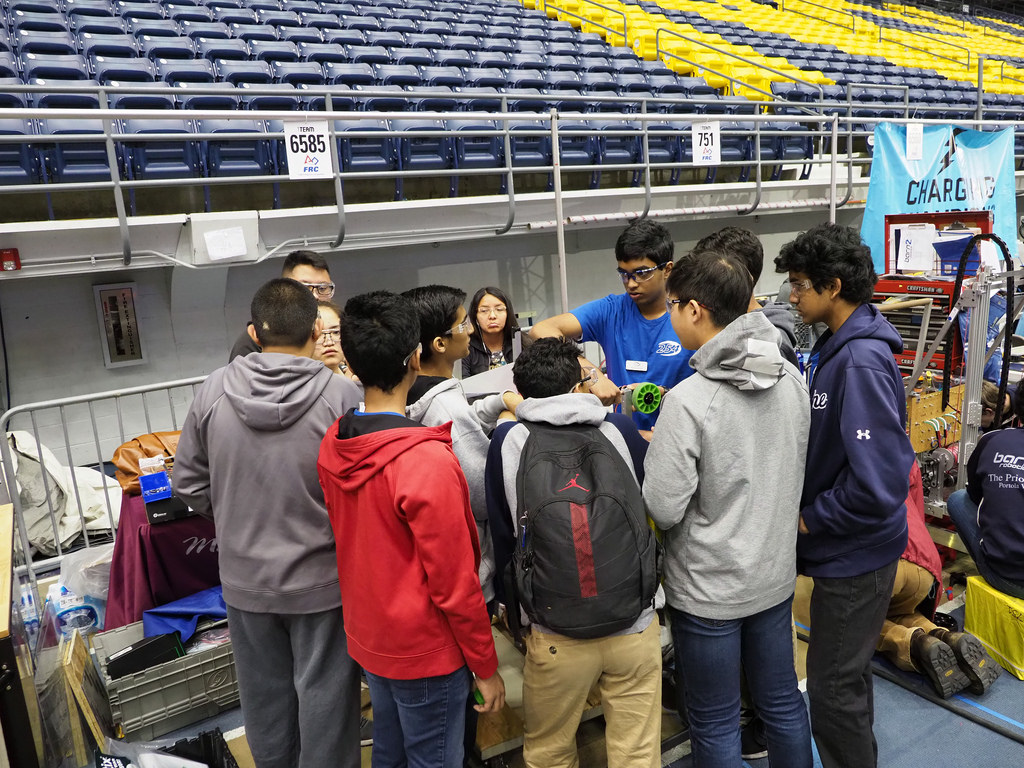
Our alliance readiness crew assists Team 6585 in mounting a newly designed intake
A Special Thanks
At the Arizona North Regional, we would not have been able to be so successful without the amazing teams that we were able to work with during our qualification and elimination matches. Also a special thanks for our pit crew and drive team for properly maintaining our robot during the tournament. A big thank you to the chairman’s presentation team for handling our team’s Chairman’s Presentation in front of a panel of FIRST Judges. Team 254 would also like to thank all the volunteers and judges that made this tournament an exciting experience, and all of our mentors, teachers, and parents who helped us succeed in this regional.
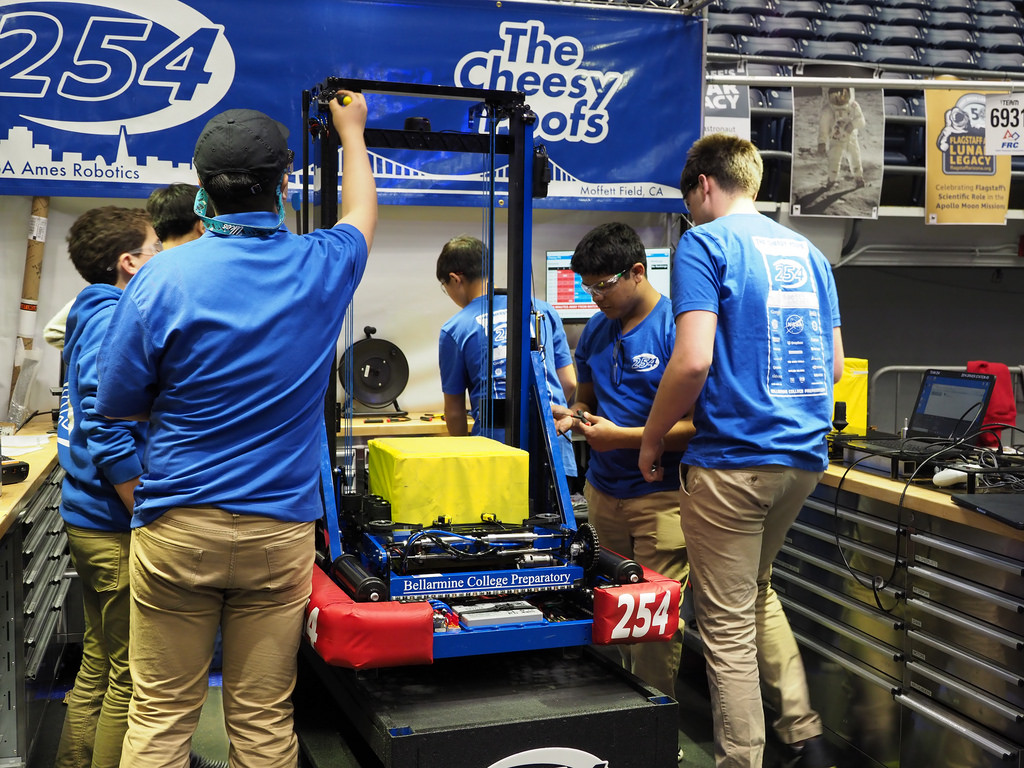
Members of the Team 254 Pit Crew repair Lockdown before an upcoming match
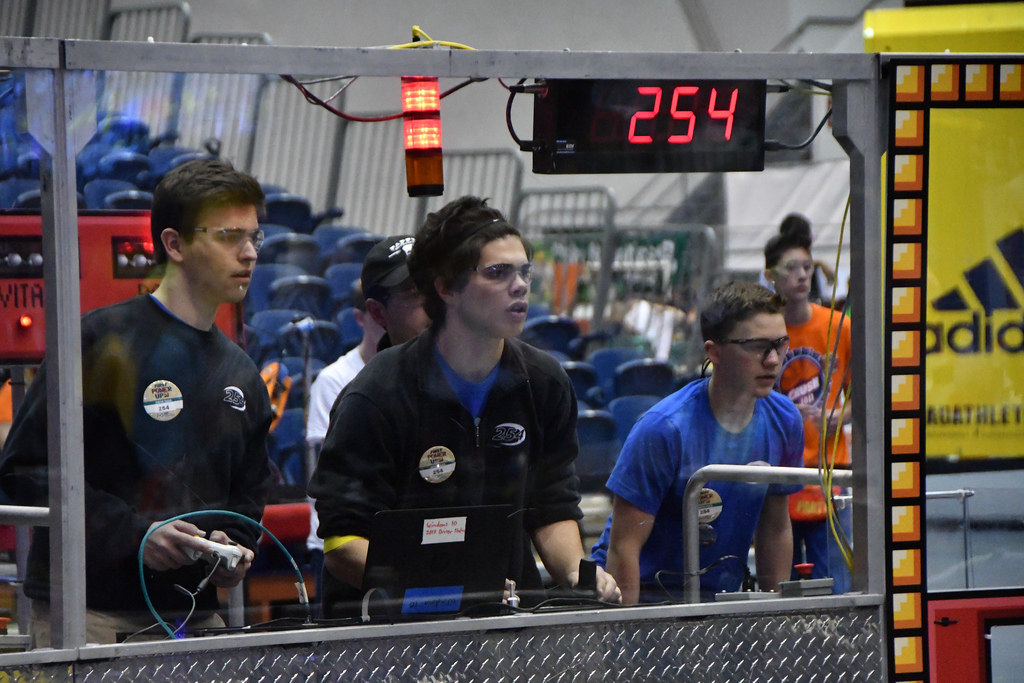
Our drive team works together during a tense eliminations match
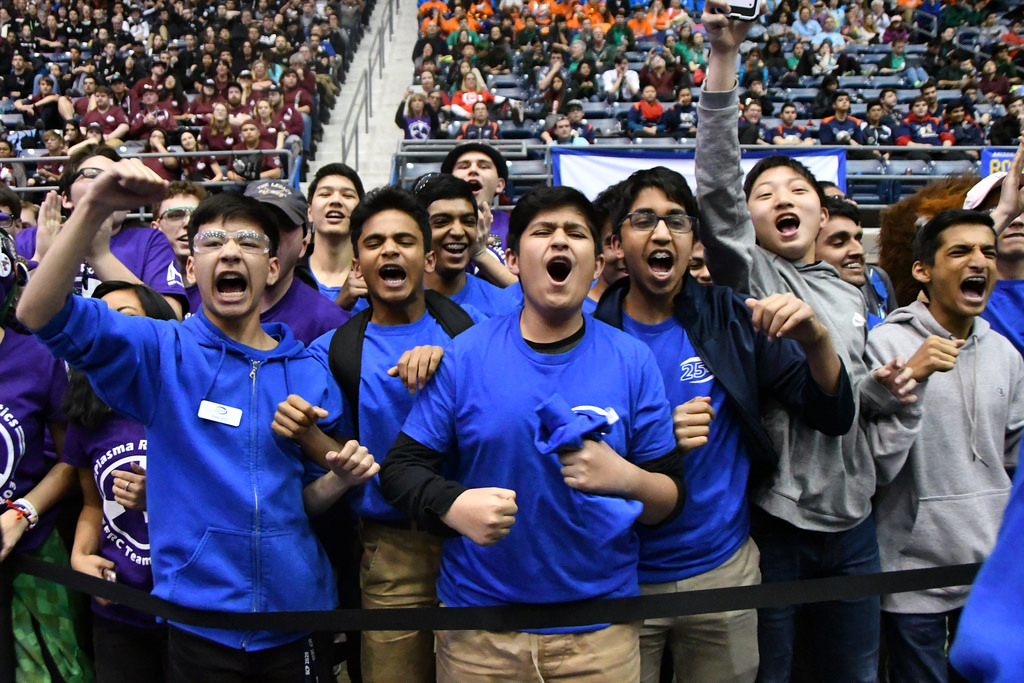
Spirited Team 254 members cheer excitedly for their alliance
Build Blog Days 28 and 29 (2/23/18 & 2/24/18)
Programming
- On Friday, 2/23, we handed off practice bot to the programmers to begin working on autonomous code. The programmers rewrote a large portion of our code to greatly simplify all our state machines and change the way operator controls work. They separated operator controls into wrist angle presets and height presets and experimented using an xbox controller rather than the button board. They also began working on some autonomous actions for intaking, setting superstructure position, and shooting/placing cubes.
Driver Tryouts
- We had our first round of driver tryouts, where all 254 members interested in joining drive team participated in a written test. The purpose of the written test was to test one’s knowledge of the Game Rules and Drive Team Positions during a match. A few lucky students were chosen to move on to the second level of drive tryouts where they were able to drive Misfire, our robot from last year. Students were asked to pick up gears from the field and place them on a makeshift peg, using the controls on our driver station. After these two rounds of tryouts, we narrowed our choices for students on the drive team, and will finalize our choices over the course of this week.
Driver Practice
- To facilitate driver practice this weekend, we rigged up the wooden lever arm of the scale we got from the SJSU kickoff onto the aluminum scale we are currently constructing. Our driveteam also practiced with Team 973 and Team 5499 throughout the day.
Working on Programming Bot
- On Saturday, 2/24, we worked on getting programming bot to the same state as competition bot. This year, driving is an especially critical component of the game. Because our robot accelerates extremely quickly with the 6 MiniCIM drivetrain and has a high CG with the elevator, the driver needs to have confident control over the robot's motion to ensure it doesn't tip over and the operator needs to have confident control over the robot's operations to ensure our mechanisms are stowed unless needed and do not accidentally hit parts of the field.
Build Blog Days 18-27 (2/9/18 to 2/20/18)
It's assembly time!
Part 1
-
On Friday, 2/9, we assembled together the elevator on comp bot and tested out how wheel the intermediate stage and carriage slid with the bearing blocks. As we were sliding the stages, we noticed that the carriage was ripping off the powder-coating on the intermediate stage, so we decided to manufacture new inner stage uprights to be anodized for comp bot. We also assembled all 3 carriages and sanded down the welds. On Saturday, 2/10, we started putting everything together on all 3 robots. We installed all the bearing blocks and forklift brackets, and began wiring up the comp bot with the IGUS chain. We also decided to hook up a magnetic limit switch to the top of the horseshoe to detect the distance between it and the carriage. That switch will be connected to the encoder on the elevator gearbox. We also assembled an intake without the pivot arms and mounted it to programming bot to test out how well it works. On Sunday, 2/11, we worked on manufacturing more parts to send out for anodizing on Monday, 2/12, and we cabled up the elevator on practice bot and tested it out. We noticed that the elevator moves slower than we thought which may require a change in gearing, and we also noticed that the cable runs are too close together which may prove problematic for spitting the cube out the back.
- On Wednesday, 2/14, we began assembling the programming bot and competition elevator gearboxes. After testing the elevator on Sunday night, we realized that it moved much slower than expected. To fix this, we swapped out the last stage gear reduction from an 18:50 to a 24:44 which theoretically allows us to climb 78.5" within 0.76 sec. We got back the intake pivot weldments from powder-coating and assembled them on practice bot.
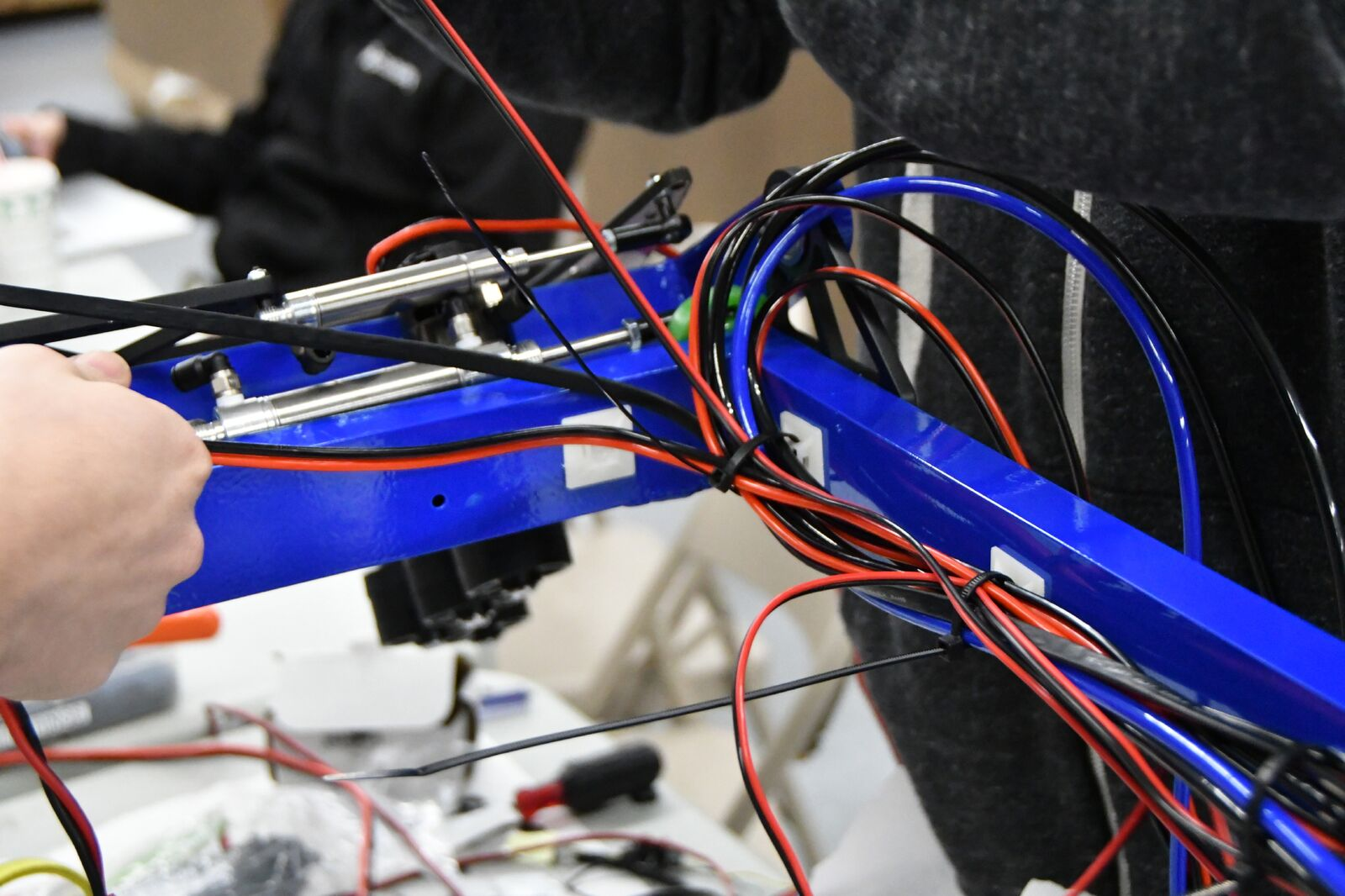
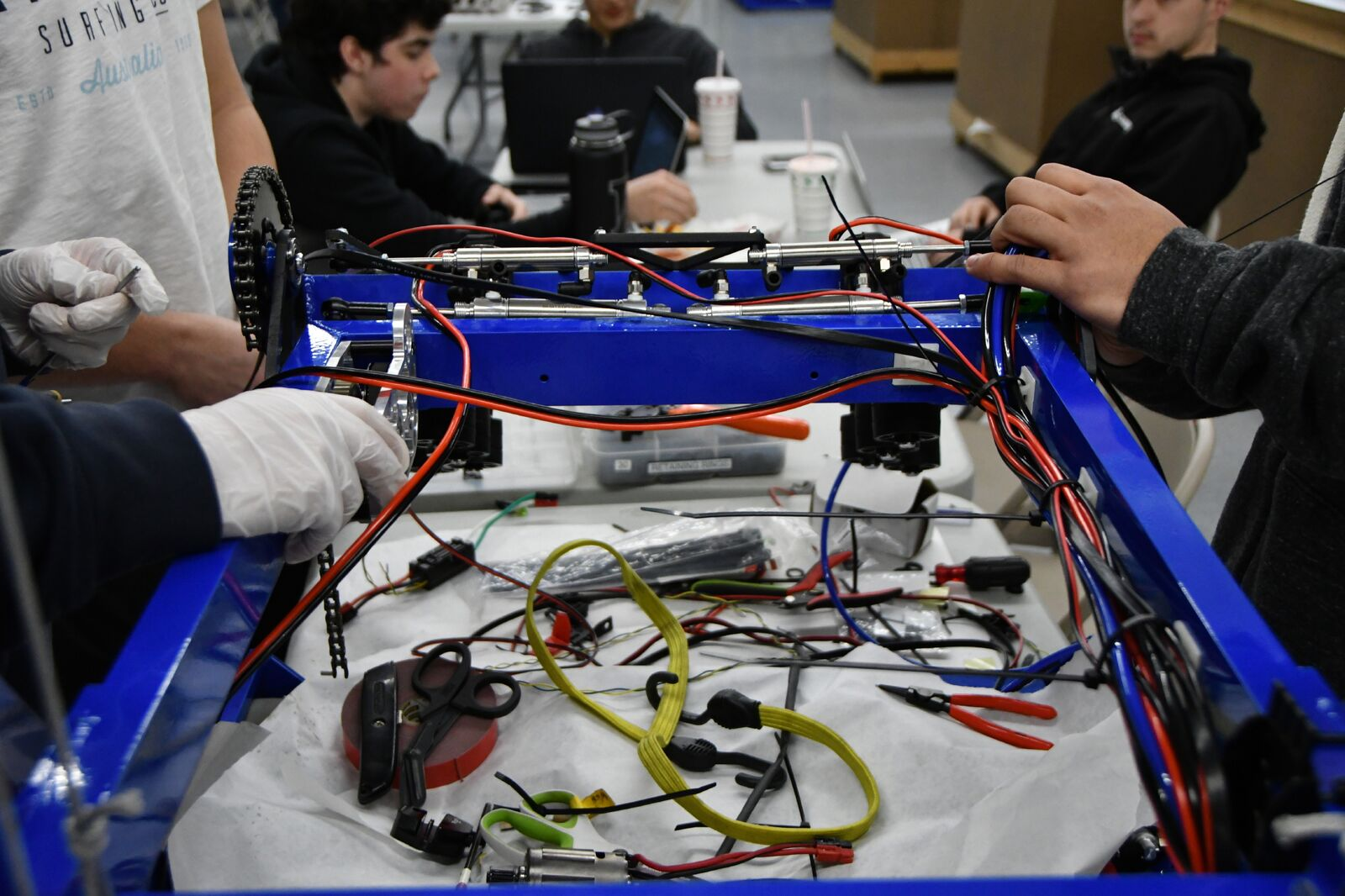
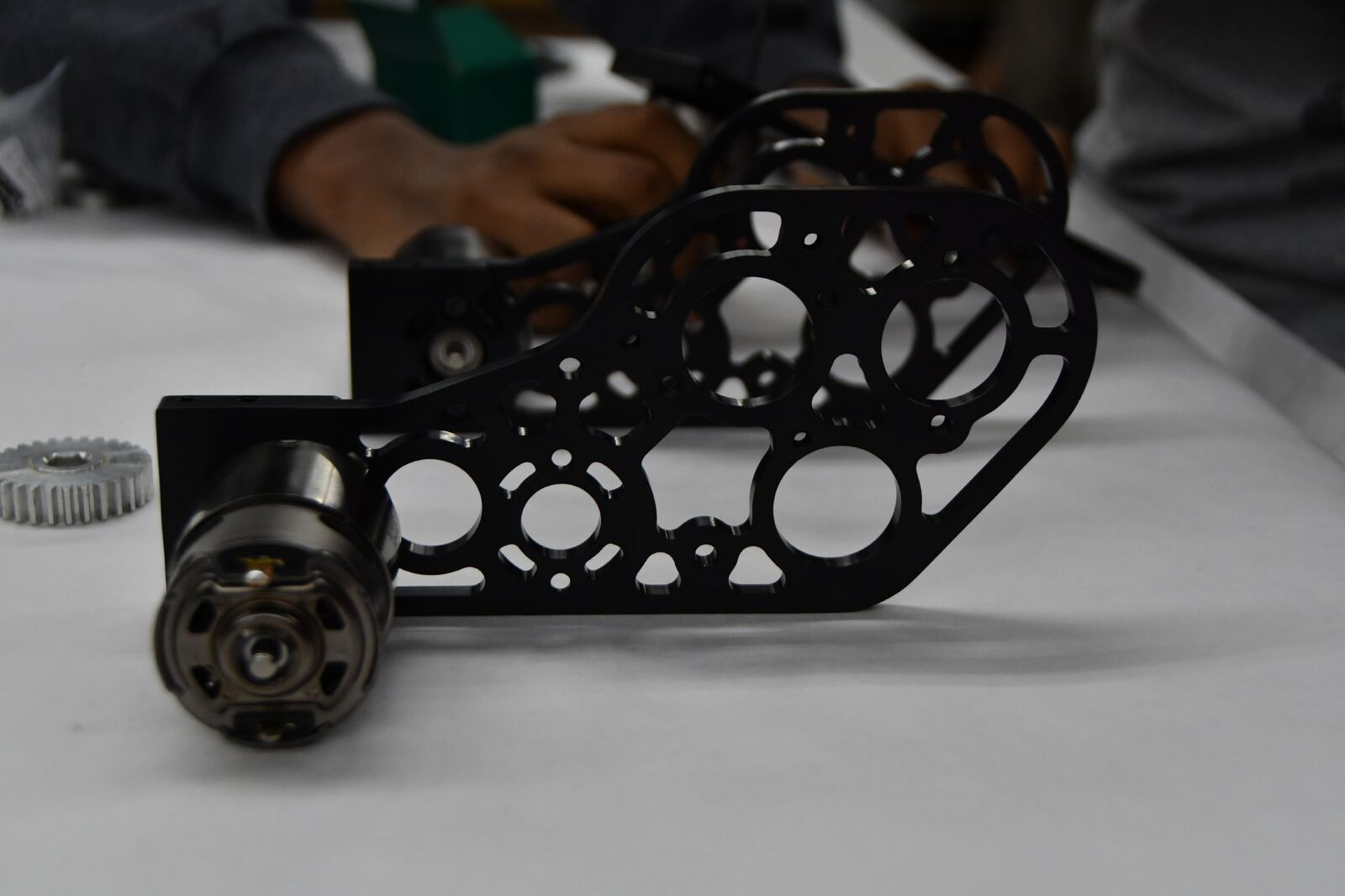
- On Thursday, 2/15, we continued work on assembling the intake. We wired up the CAN coming up from the PDP into the talon, then had the CAN daisy chain from the talon to the canifier, and then had the CAN terminate after the canifier with a 120 ohm resistor. The canifier will be used to breakout various DIO sensors we plan on placing on the intake such as magnetic limit switch sensors for soft stops for the intake pivot and beam break sensors for cube detection. We wired up the motors and pneumatics on the intake, and tested it out.
- After 4 intense days of early mornings and late nights, we bagged and tagged our completion robot last night! Thank you to all the students, mentors, and parents who made this build season possible!
- Saturday, 2/17: We handed off the the practice bot to the programmers to begin tuning the wrist pivot and the elevator.
- We wired up the carriage on competition bot by drilling in holes in the box tubing to channel the wires. We mounted the intake on the carriage and placed the magnetic limit switch sensor on the carriage pivot gearbox
- Sunday, 2/18: The programming team continued tuning practice bot. We continued assembling and wiring competition bot.
- Monday, 2/19: The programming team took competition bot to tune the mechanisms while the assembly team took practice bot to mount the forklift and hanger. We tested out both the forklift and hanger and saw that the sneaky hang with a partner was able to support two robots. While doing a solo sneaky hang, the robot did swing in which we expected to happen. We mounted a rollercoaster arm on practice bot hoping to counteract that swinging, but rather it only caused the robot to now pivot around where the rollercoaster arm contacted the scale. After all this testing, we decided to remove the partner hang and only mount the sneaky hang on competition bot.
- Tuesday, 2/20: Stop build day! We finished up all the wiring and assembly on competition bot and took pictures of it. In the last hour, the programmers took the robot to test it, and we noticed a few issues arising with the intake, Omni followers, and sensors which will need to be corrected at competition. We bagged the robot at 115.9 lbs as well as a tote full of spare parts.
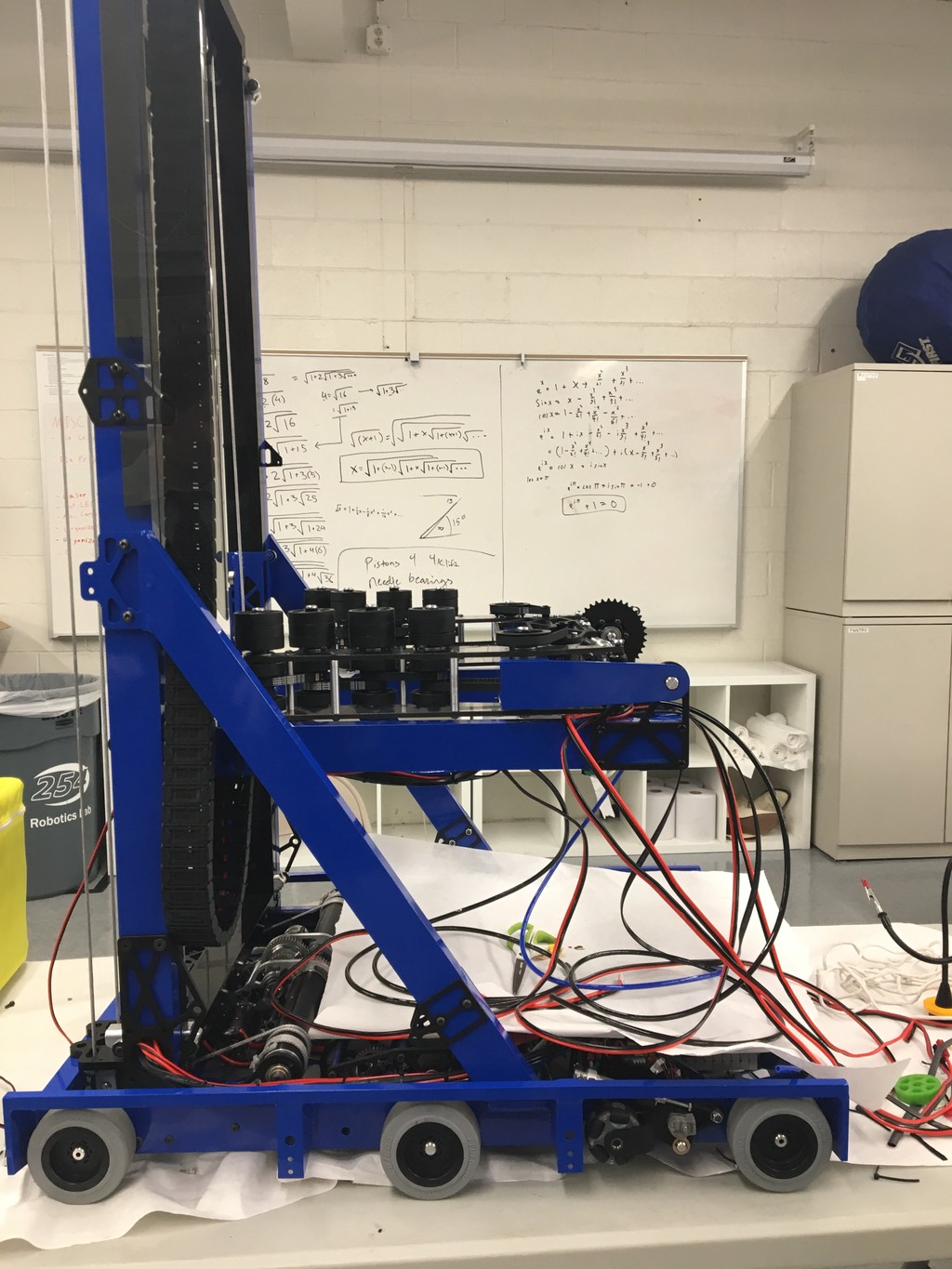
Part 2
Our Final Robot

Build Blog Days 16 and 17 (2/2/18 & 2/3/18)
Elevator
Task: Design Elevator Cartoon CAD
- We decided to offset the A-Frame from the frame rail to allow more space for the intake to open and close in between. To do so, this also required moving the frame rail closer to the elevator such that it would not interfere with the omni followers. We finalized the outer stage and A-Frame of the elevator, manufactured all the parts, and sent them out to be welded. We decided to have the igus chain ride on a polycarb guide on the same plane as the outer face of the upright. The igus chain will attach to the top of the polycarb guide, will curl around the side tube of the carriage weldment, and will bolt to the inside of the carriage. We also moved the pulleys in a little on the bottom side of the horseshoe to make space for our pit crew members to easily put in the thumbscrew bolting the bumpers to the back of the frame rail.
Forklift
Task: Design Forklift CAD
- We adjusted the forklift pivot and piston to work around the A-Frame by using a larger bore piston with a smaller stroke. We had initially planned on using a 3/4″ bore piston with a long lever arm, but because we decided to move it within a protected area and closer to the elevator, the lever arm decreased and thus required a larger bore piston to hold the forklift upright. We also finalized the tensile member which will be a steel wire bolting from the elevator to a-frame gusset to a standoff on the forklift and added a crossmember between the two forks.
Rollercoaster Wheels
Task: Complete Rollercoaster Wheels CAD Design
- We completed the design of the rollercoaster wheels. We decided to use metal lanyards as the deploying hardstop. In addition, we chose to use a ball bearing with a 3D printed cover to increase the size of the wheel without increasing the thickness.
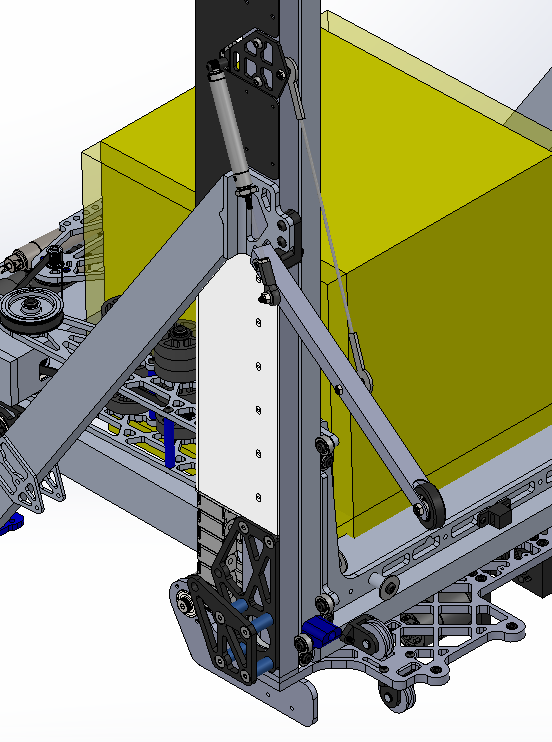
Electrical
Task: Wire the Practice, Programming, and Competition Robots
- Over the past two builds, we completed wiring the practice, programming, and comp bots. We also installed all necessary gearboxes and chains on each drivebase. So far, the practice and programming robots are set with pneumatics. At our next build, we plan to finish plumbing the pneumatics on the comp bot.
Stanford Outreach Event
Shockwave Shows Off Some Mad Skills!
A Brief Summary
WHAT: Shockwave launched t-shirts into a crowd of excited Stanford Basketball Fans
WHEN: Saturday, February 3rd, 2018
WHERE: Stanford University in Stanford, CA
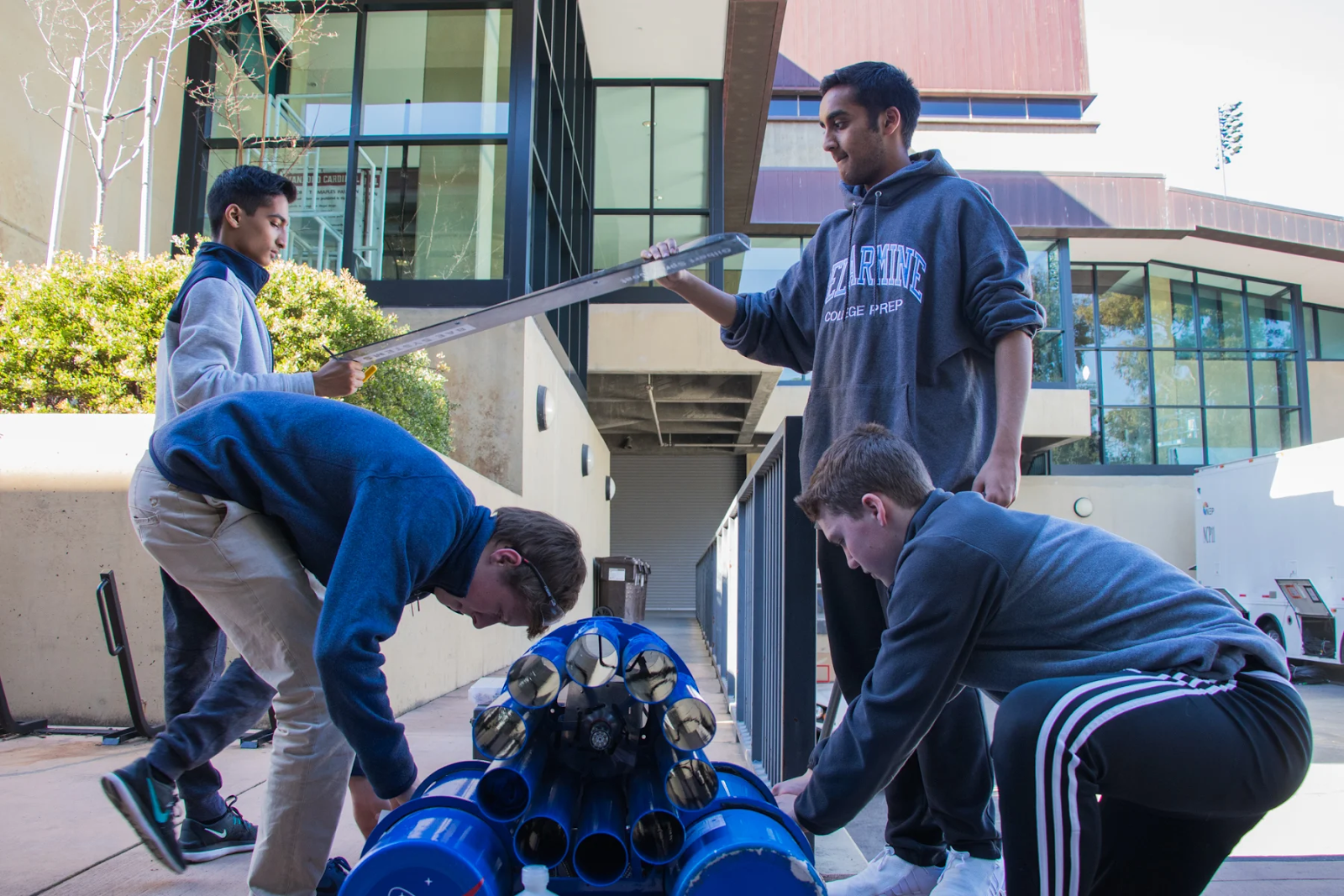
Team 254 Members Griffin Soule, Shruthik Musukula, Mubashir Hussain, and Jack Gnibus work together to prepare Shockwave before the game
As part of an eventful weekend, we participated in a successful outreach event at Stanford, CA. Due to the efforts of students on our outreach subteam, Team 254 students were excited to have the opportunity to present Shockwave at the Stanford Basketball Game, where Stanford played against the Oregon Ducks from the University of Oregon. During a timeout in the first half of the game, Team 254 students Yusuf Halabi, Shruthik Musukula, Jack Gnibus, Griffin Soule, and Mubashir Hussain worked together to operate Shockwave and launch several Stanford t-shirts into a crowd of approximately 8,000 people. We are extremely grateful to have such an opportunity and would love to support Stanford University in the future!

Shockwave launches t-shirts towards excited audience members
Build Blog Days 14 and 15 (1/29/18 & 1/31/18)
Elevator
Task: Design Elevator CAD
- We changed the placement of the A-Frame by pushing it further towards the front of the robot and higher up the outer stage elevator upright such that the bumper latch could freely swing without contacting it, and we made the corresponding changes to the gusset joining the A-Frame to the outer stage elevator upright. We also modified the horseshoe plate to accommodate the omni follower wheels on the back of the robot by having the cutout fit around a space of the follower wheels. To ensure that our forklift would not contact our pulleys and cables when stowed within the frame perimeter, we looked into pushing the pulleys closer to the sides of the elevator, but realized that they would then interfere with the carriage as it traveled up. Instead, we decided to adjust the forklift pivot such that it could stow vertically and not have the carbon fiber rods leaning into the elevator assembly. Moving forward, we will also need to design in a part to protect the pulleys in case the forklift sways while we accelerate across the field during a match. We also modelled in a new piston pivot off the lower part of the A-Frame to actuate the stowing/deploying of the forklifts. We decided to move this piston to be above the frame rail and below the top of the bumpers such that it is in a protected area. If it was kept in its previous configuration, a robot could have easily come in and hit it, which would have rendered us incapable of actuating the forklifts for that match.

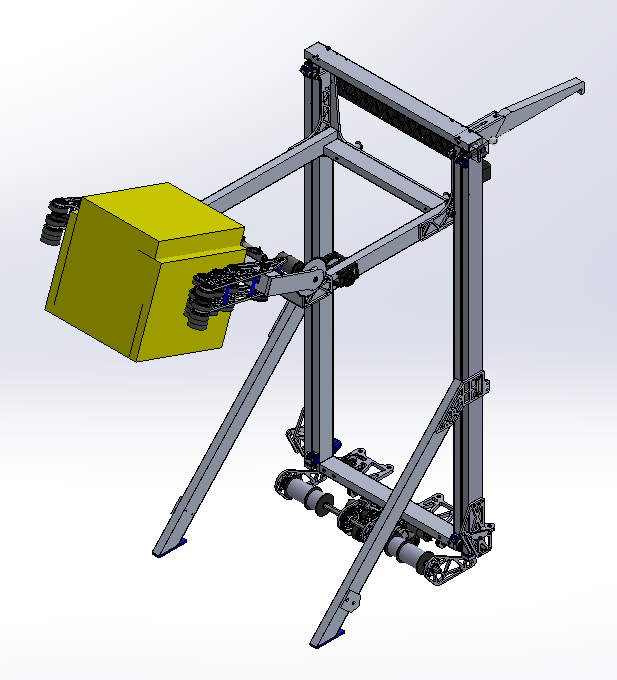
Electrical
Task: Wire the Practice, Programming, and Competition Robots
- We finished wiring the PCM on the Practice and Programming Robots. We also finished wiring all the Talons for each robot. Lastly, we worked on gathering and assembling the pneumatic systems for each robot.
Programming
Task: RPLIDAR Driver
- Today, we finished the odometry calculations necessary to track the robot’s position using the follower wheels. The main difference from last year’s code is the inclusion of the back follower wheel, which can be used to detect sideways slip when making turns. We are pretty much ready to test the follower wheels once they are ready, but we still need to figure out where the encoders will plug in so we can finish up the code.
Build Blog Days 12 and 13 (1/26/18 & 1/27/18)
Elevator
Task: Design Elevator Cartoon CAD
-
We finalized the elevator gearbox and pulley placement. To ensure the gearbox does not get in the way of the carriage, we decided to stow it below the elevator and belt out to reductions and the spool. We will have two spools, one on each side. Each spool will be divided into two sections by a flange: one section for the pull up cable and one section for the pull down cable. To avoid the carriage sweeping through in front of the elevator, we decided to have our cable runs go on the back of the elevator then come below the horseshoe and back onto the spool. We extended the horseshoe onto the frame perimeter to give us space to bolt the pulley assemblies and also to bolt into the frame rail to provide overall structure to the elevator assembly.


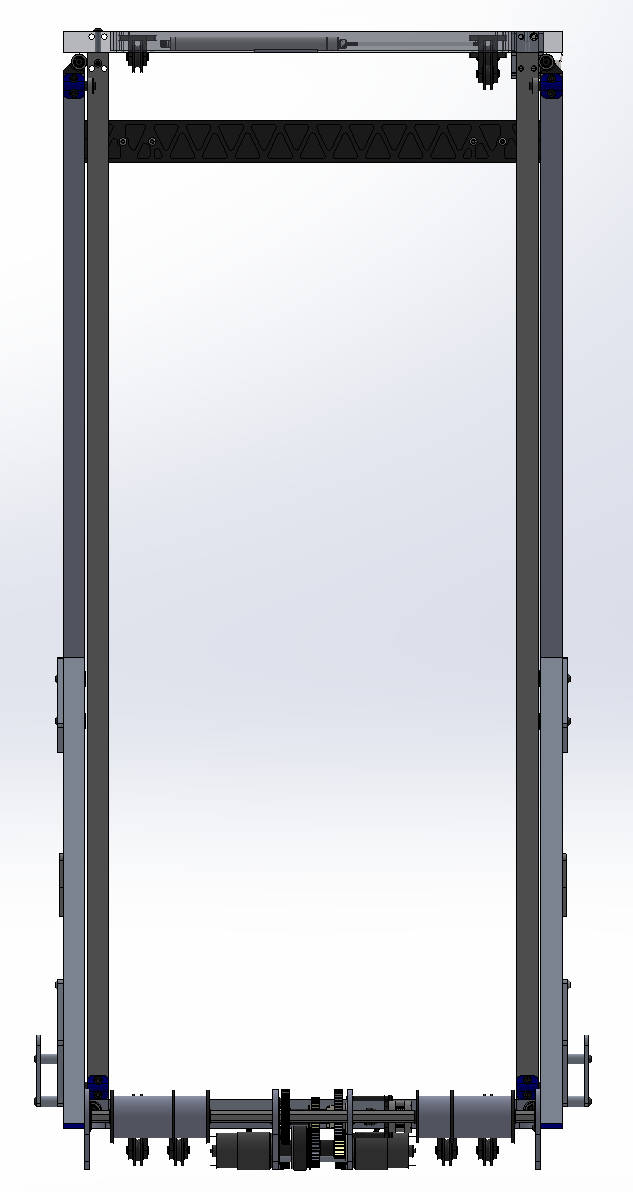
Rollercoaster Wheels
Task: Finish Rollercoaster Wheels Design in CAD
-
We finalized the geometry of the rollercoaster wheels design. We determined that we should have the piston mount to a plate mounted off the upright. This eliminates the original need for two degrees of freedom with two rod ends. Our plan is to start detailing the parts, finalizing that everything packages, and doing stress analysis.
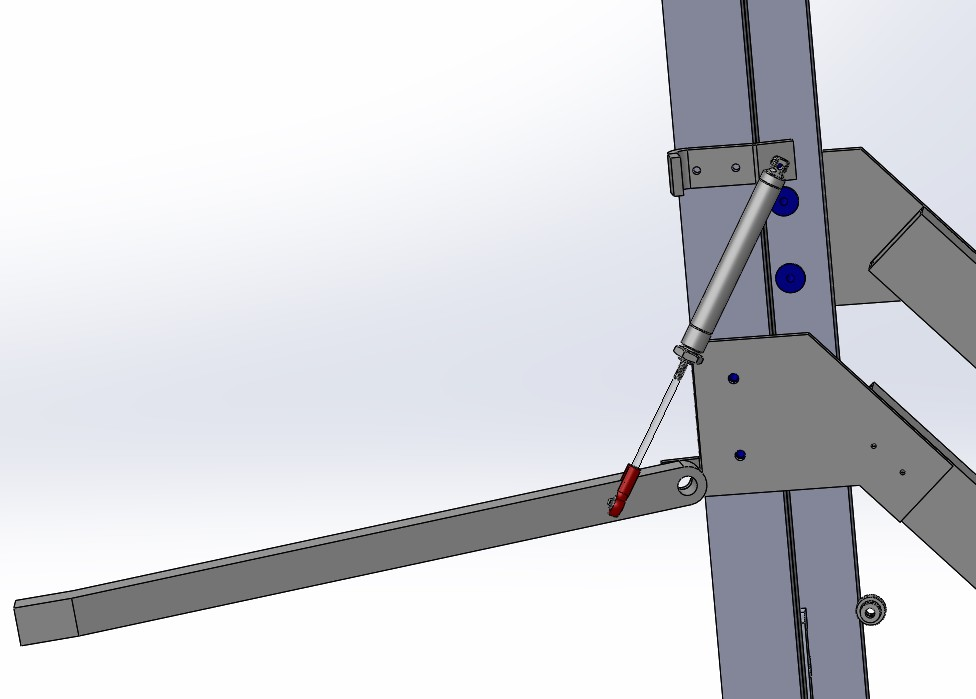
Electrical
Task: Wire the Practice, Programming, and Competition Robots
-
For wiring, we worked on wiring the talons and distributed power to the VRM, PCMs, and RoboRio. We completed wiring the programming bot and are close to finishing wiring the practice bot.
Programming
Task: RPLIDAR Driver
-
We worked some more on the lidar driver. We discovered a few problems with the UDP method where some data would be lost when the information was sent to the roborio resulting in a few of the packets missing timestamps. To solve this problem we ended up writing to an input stream and using a buffered reader to transfer the data instead. The new method also reduces CPU usage and decreases latency, so it is pretty much better all around.












